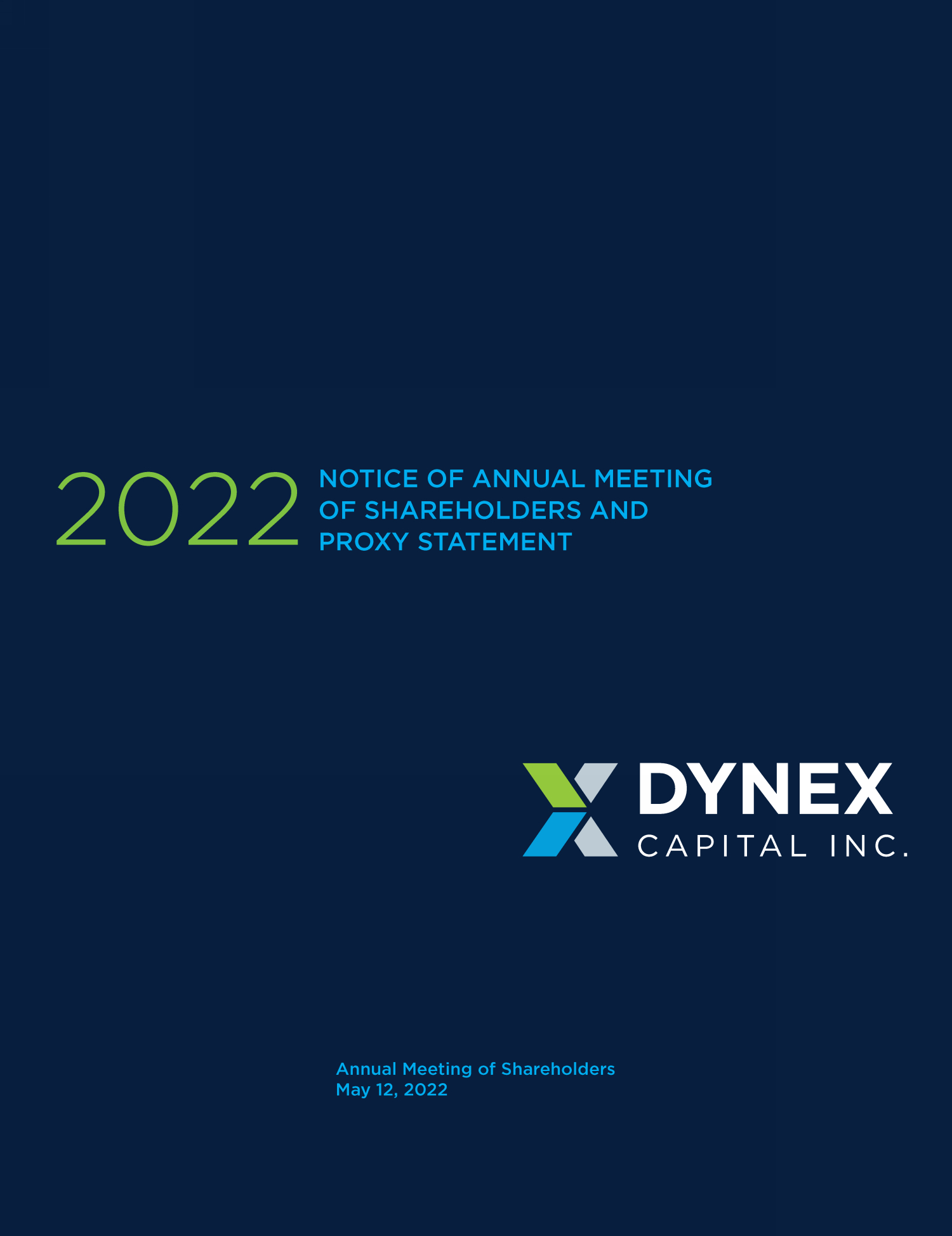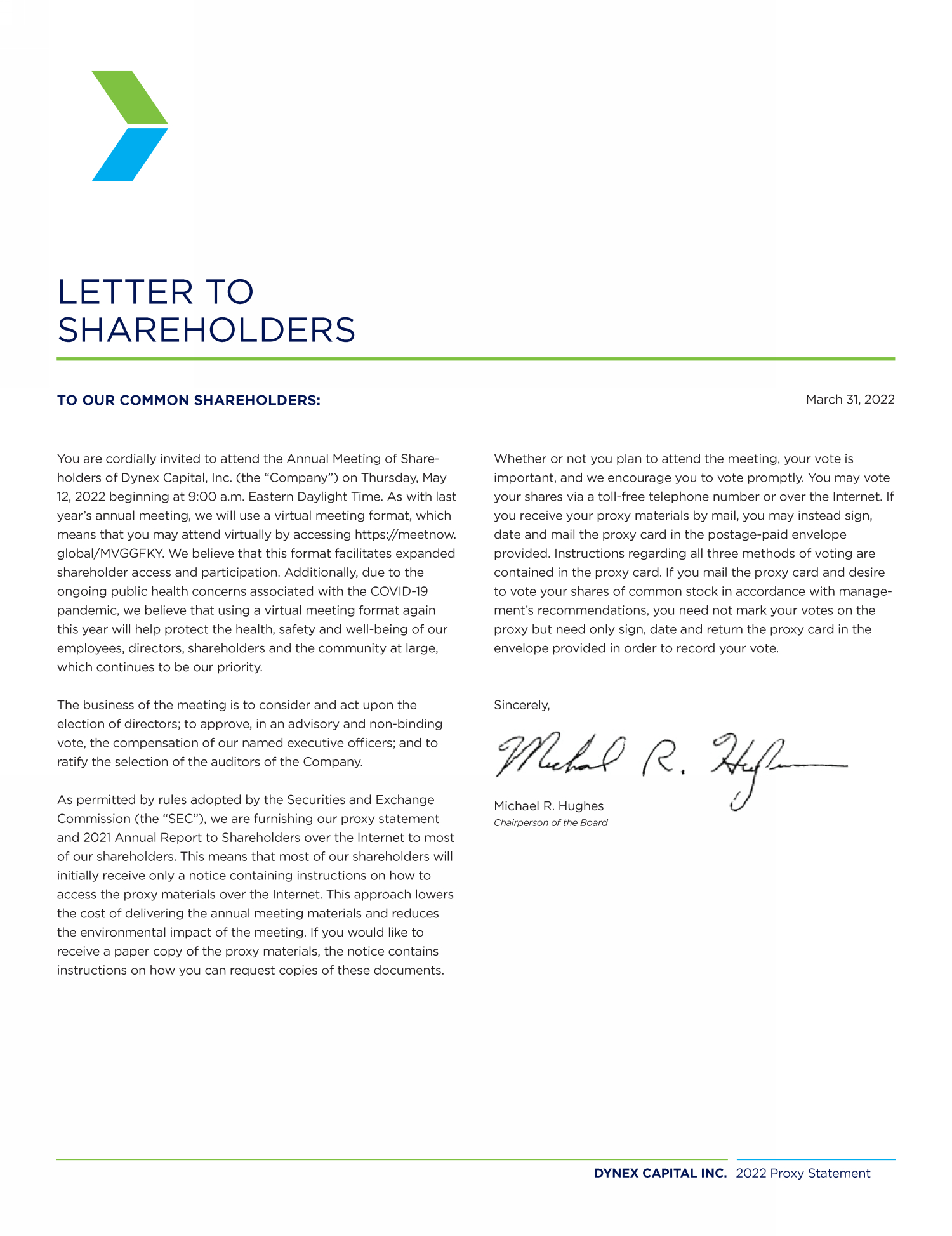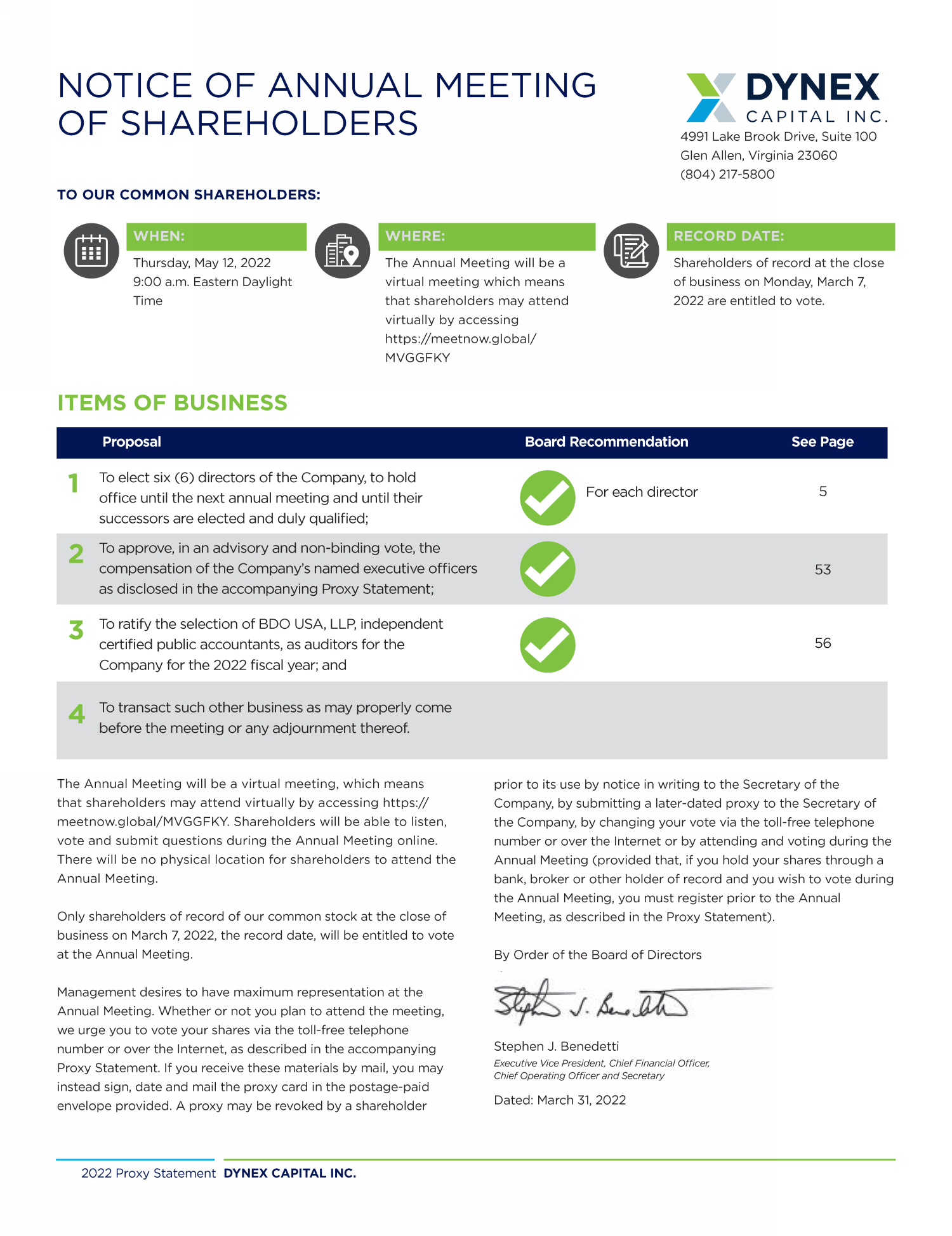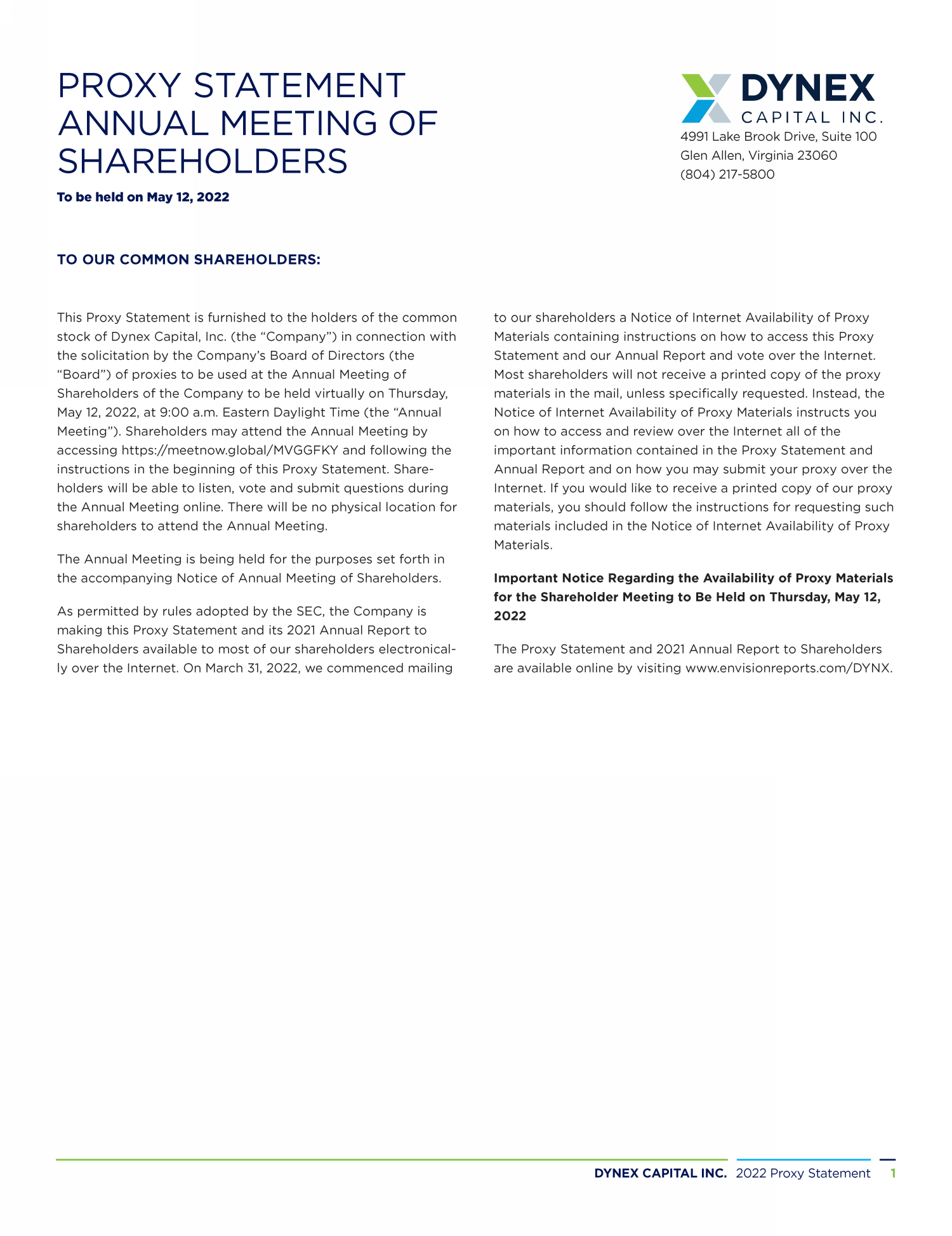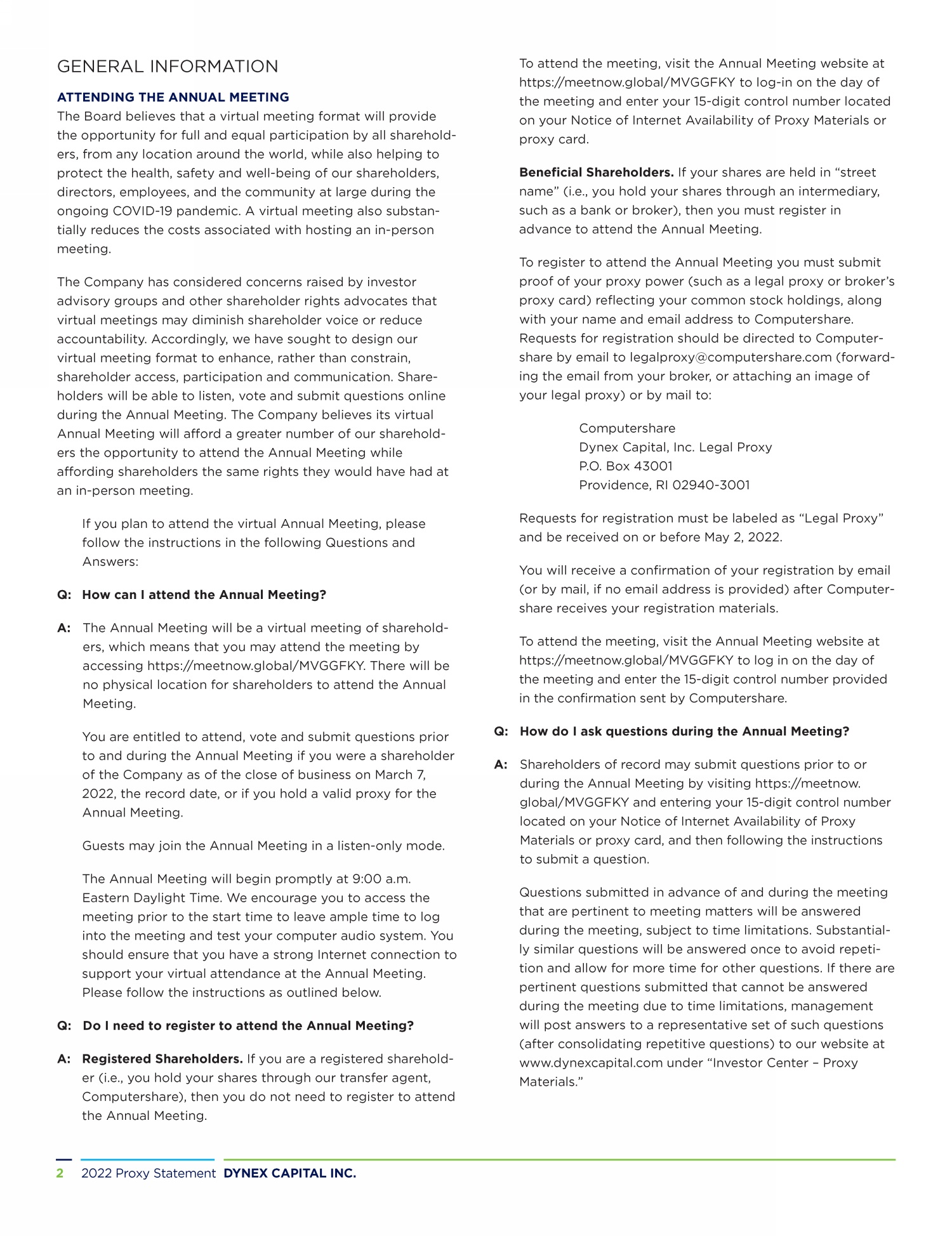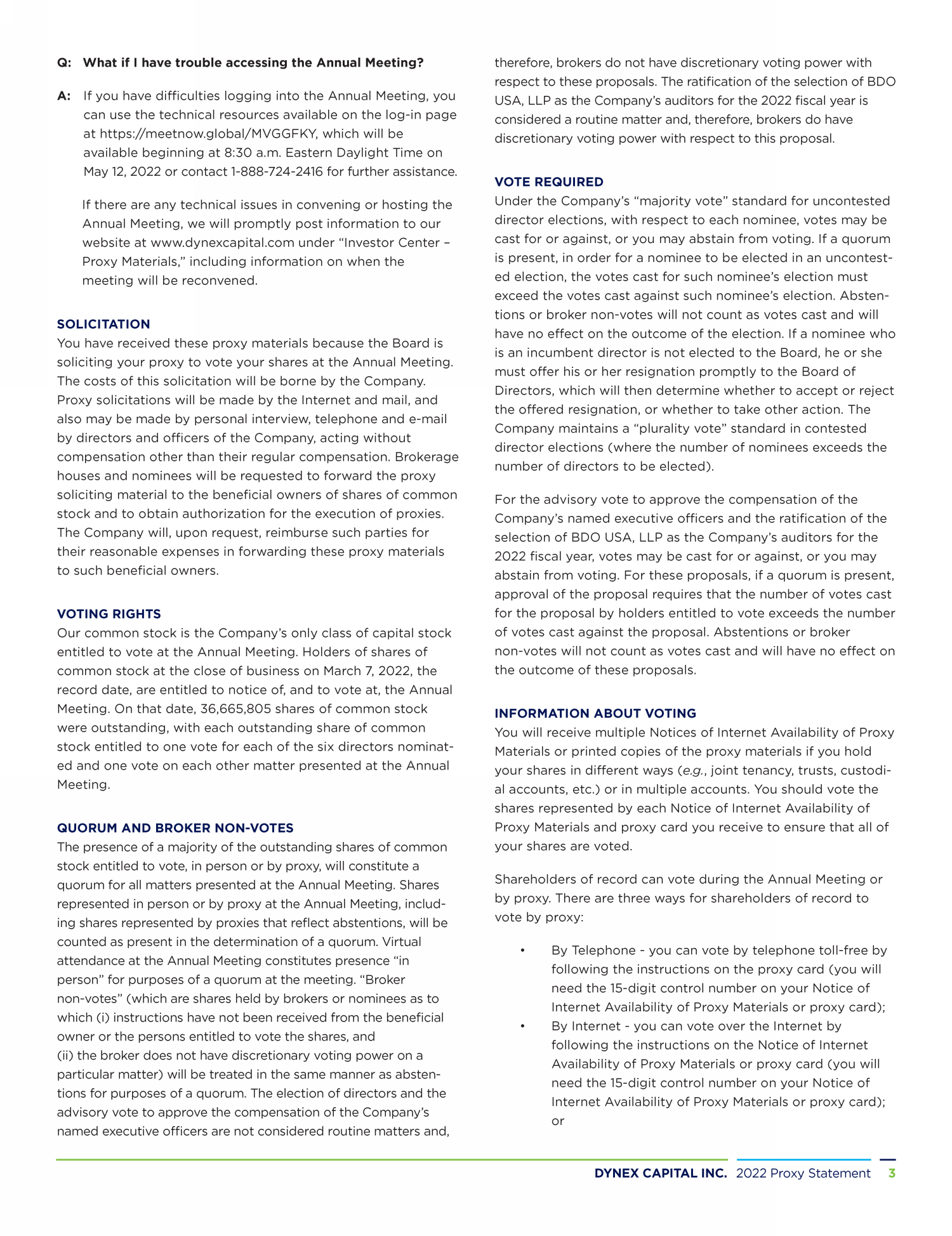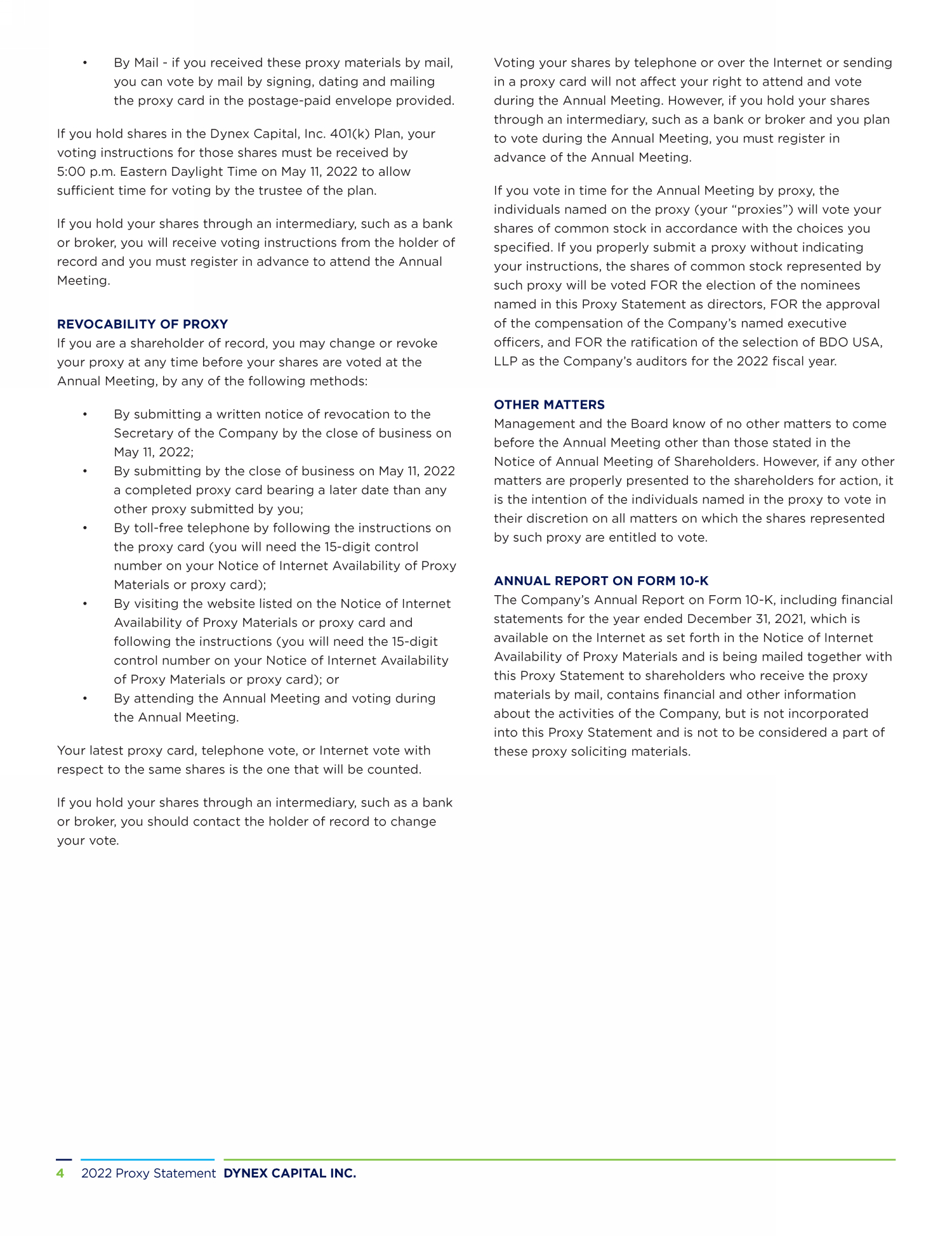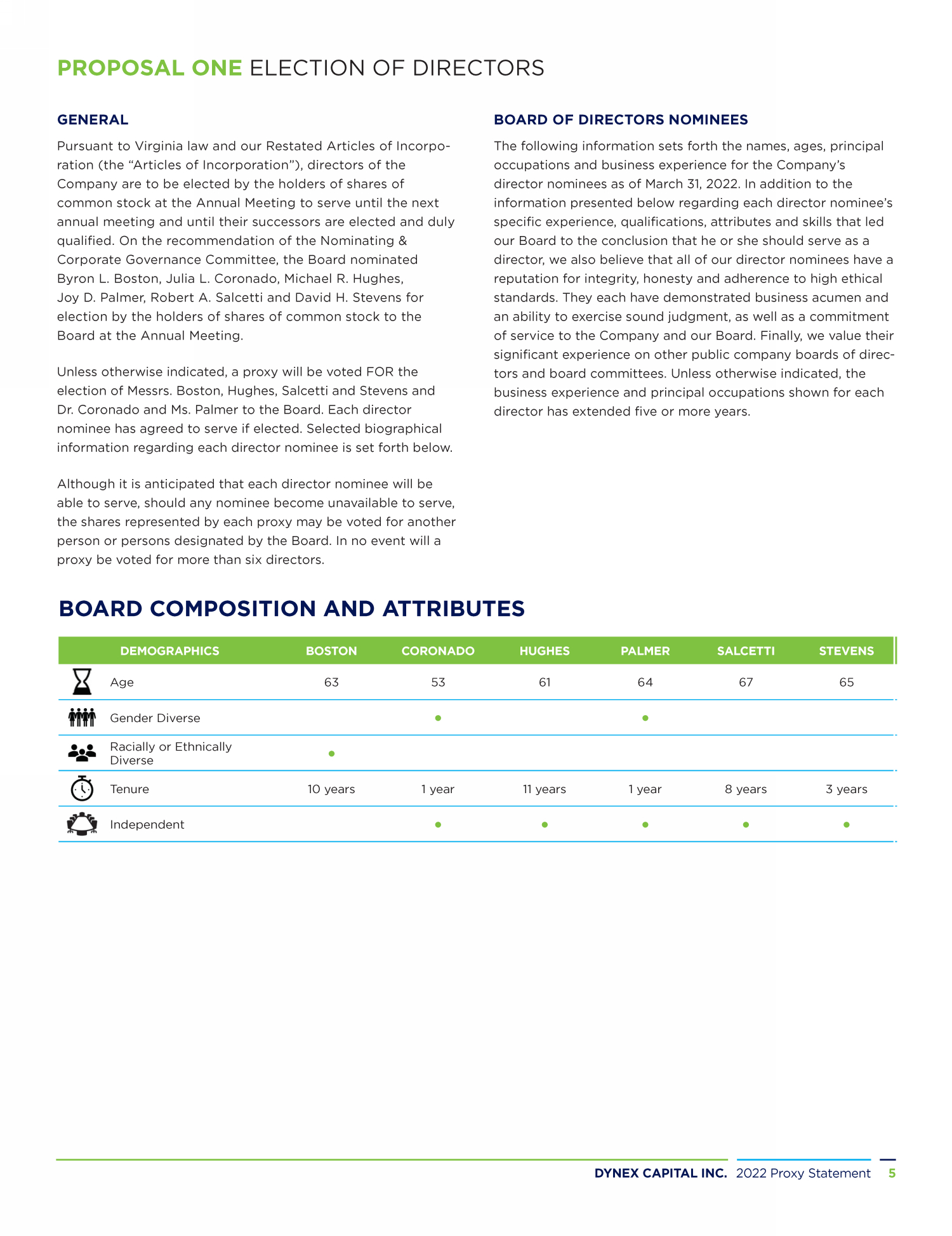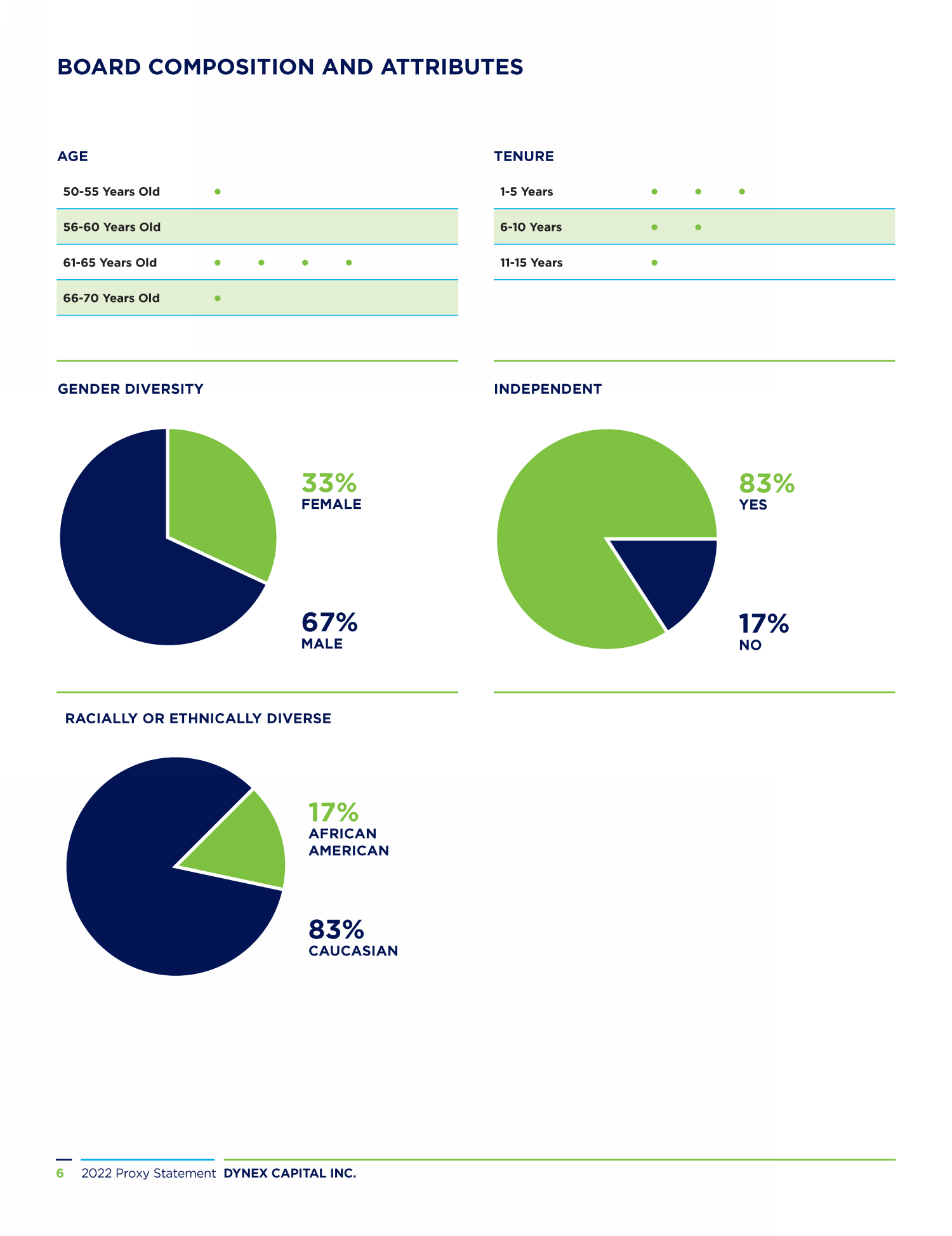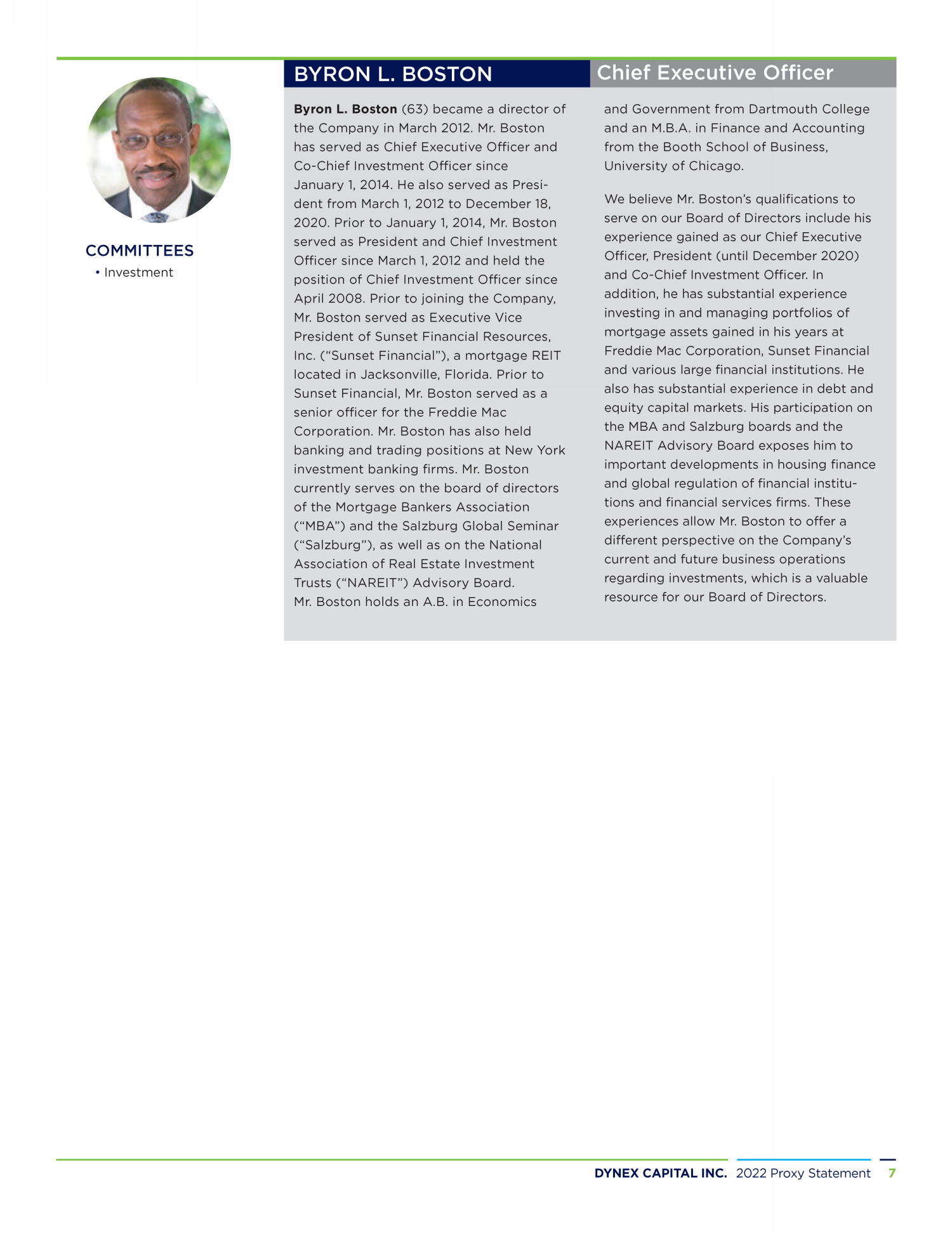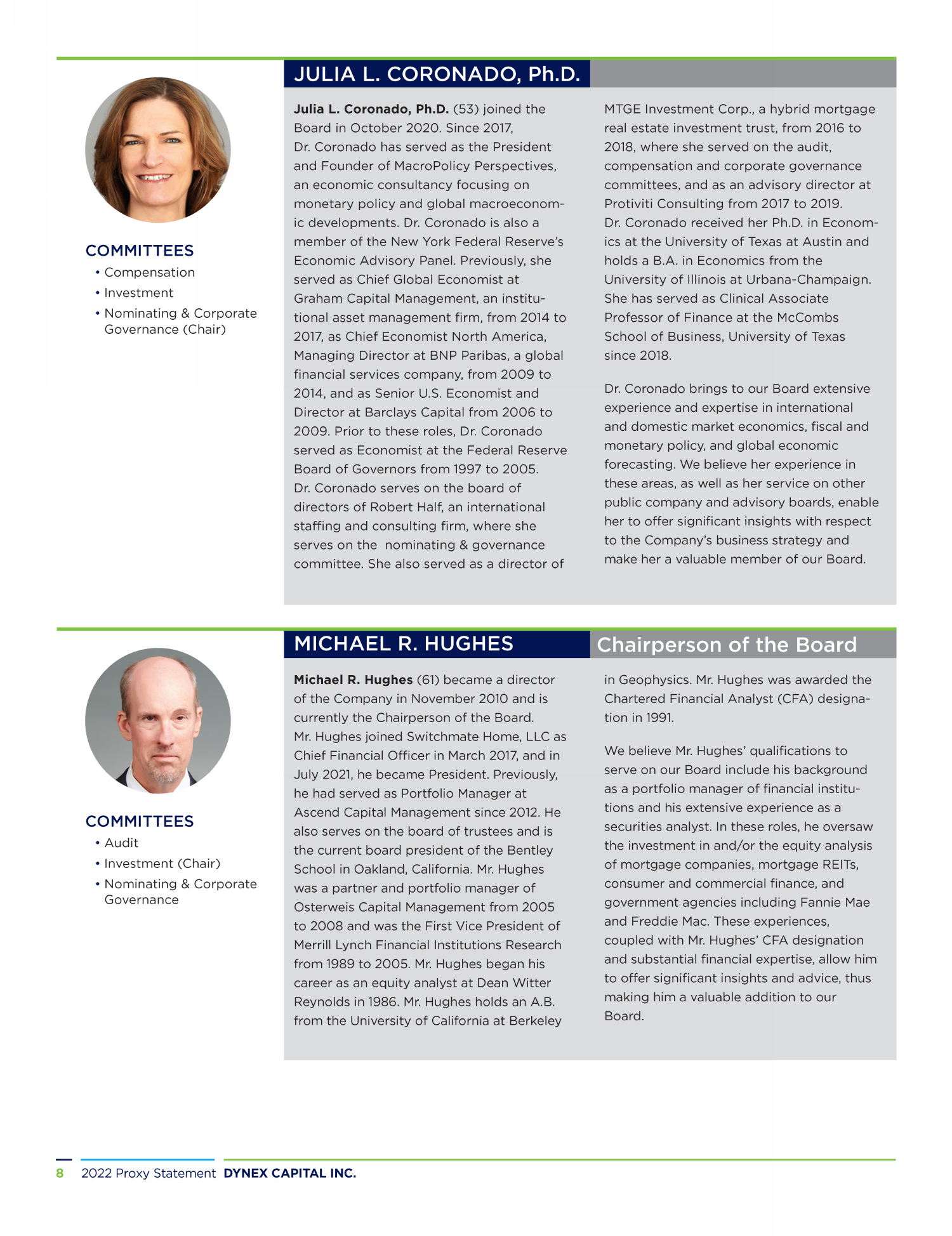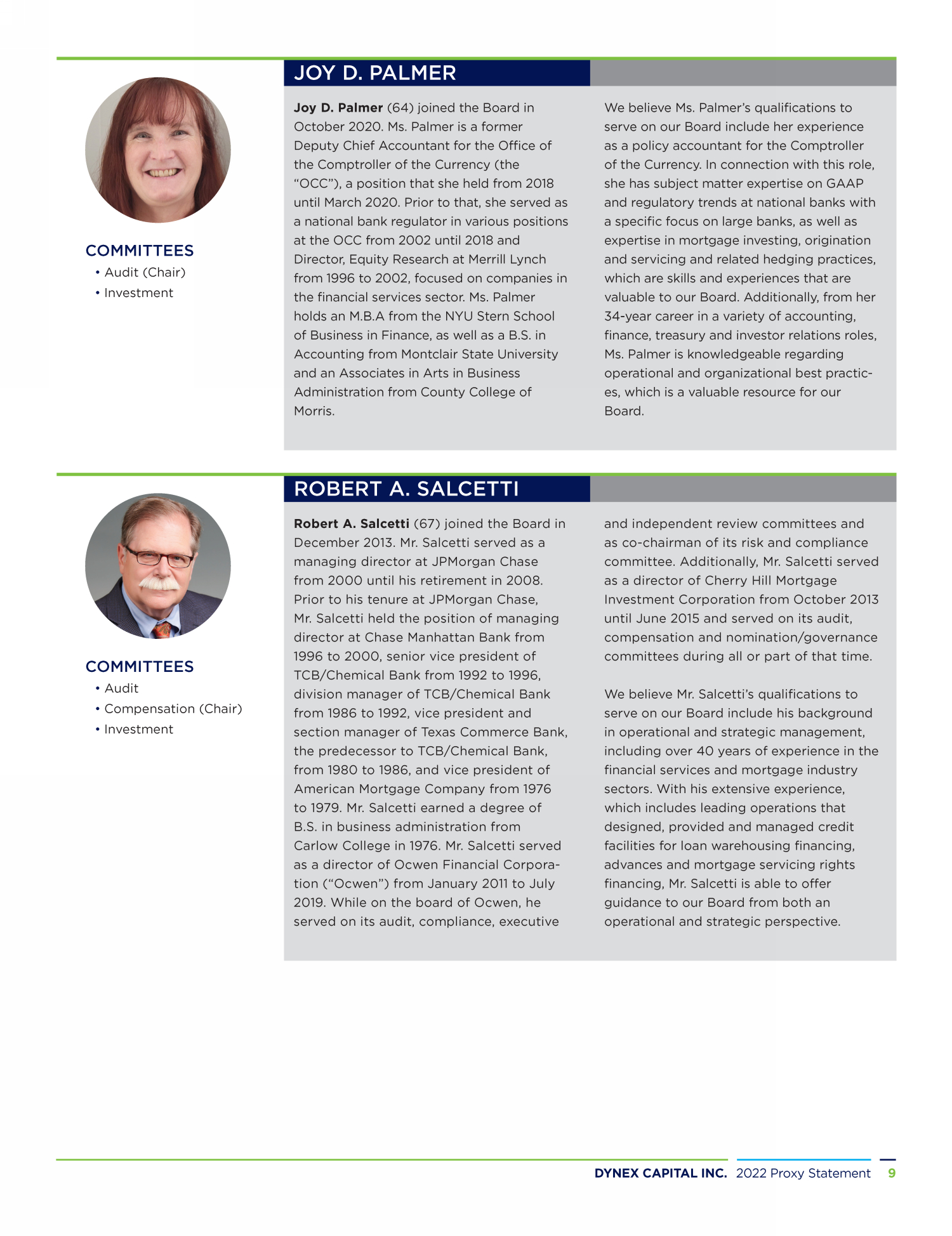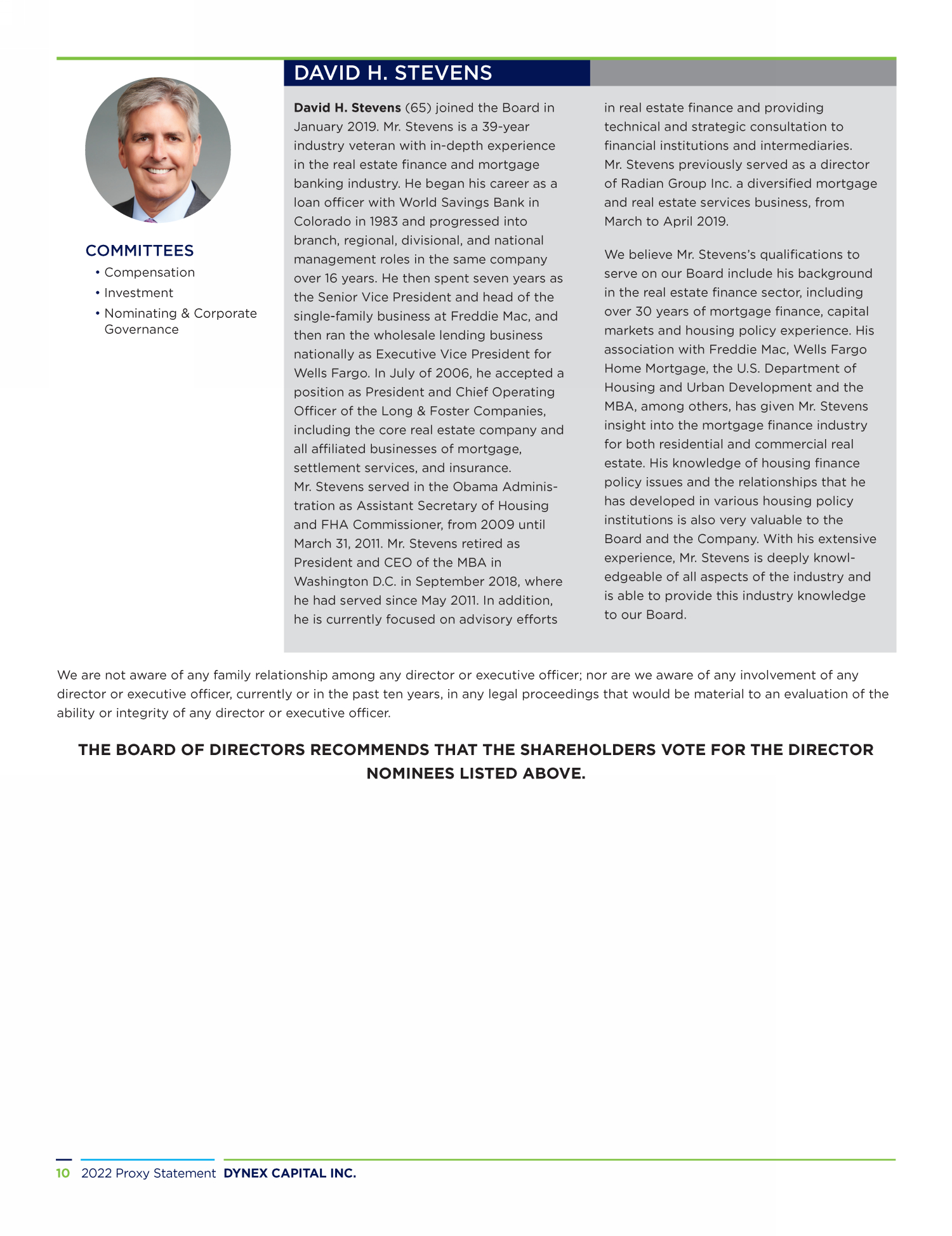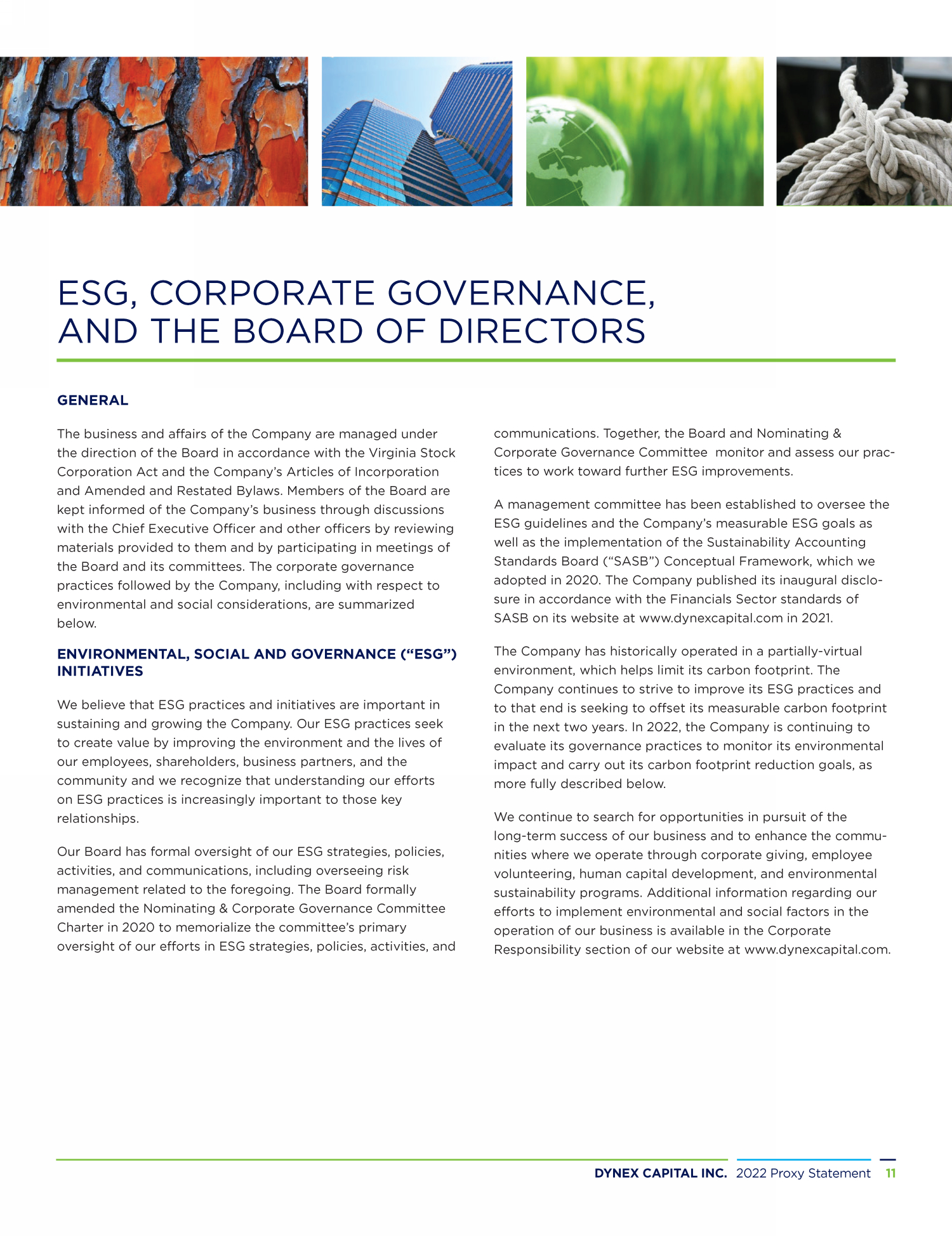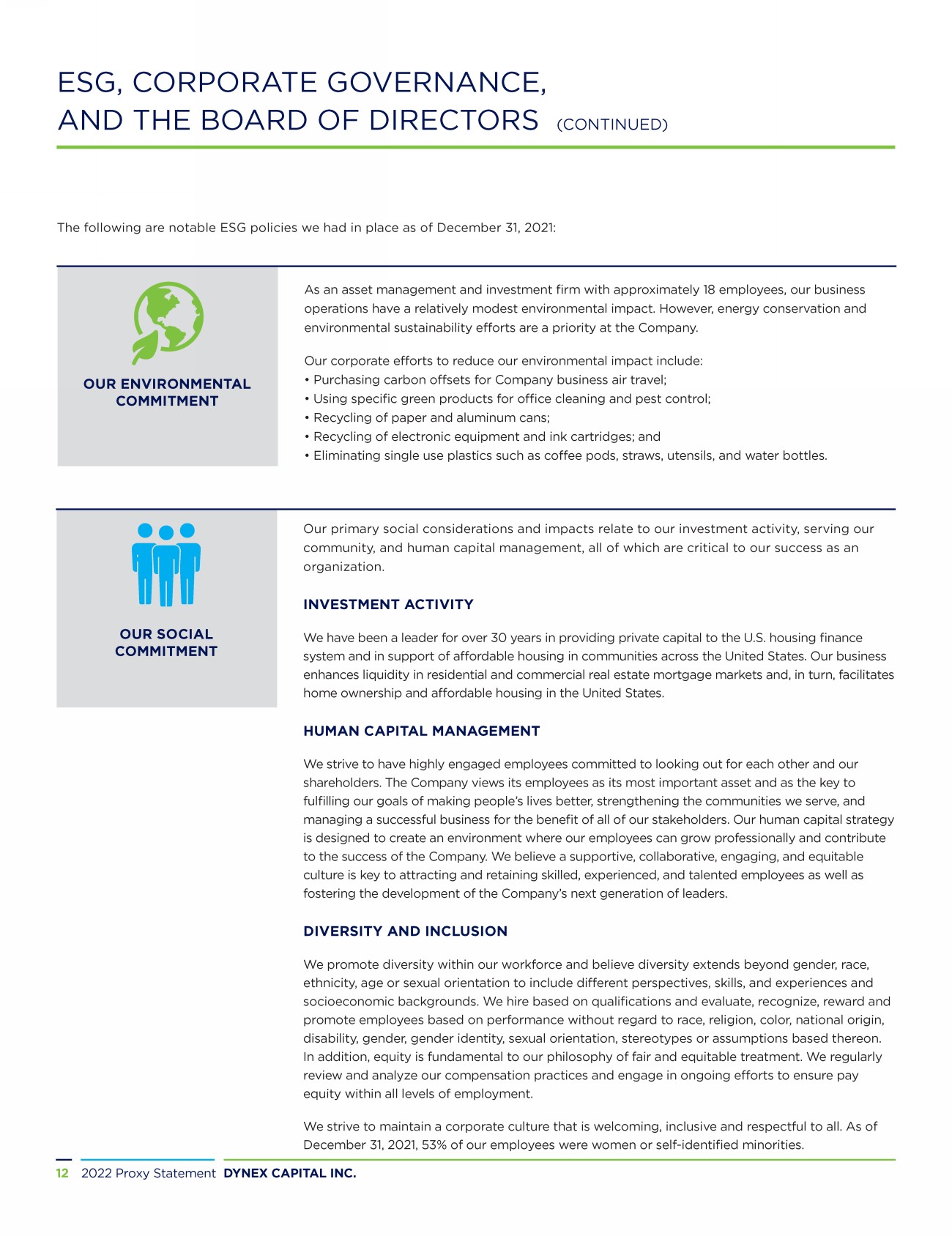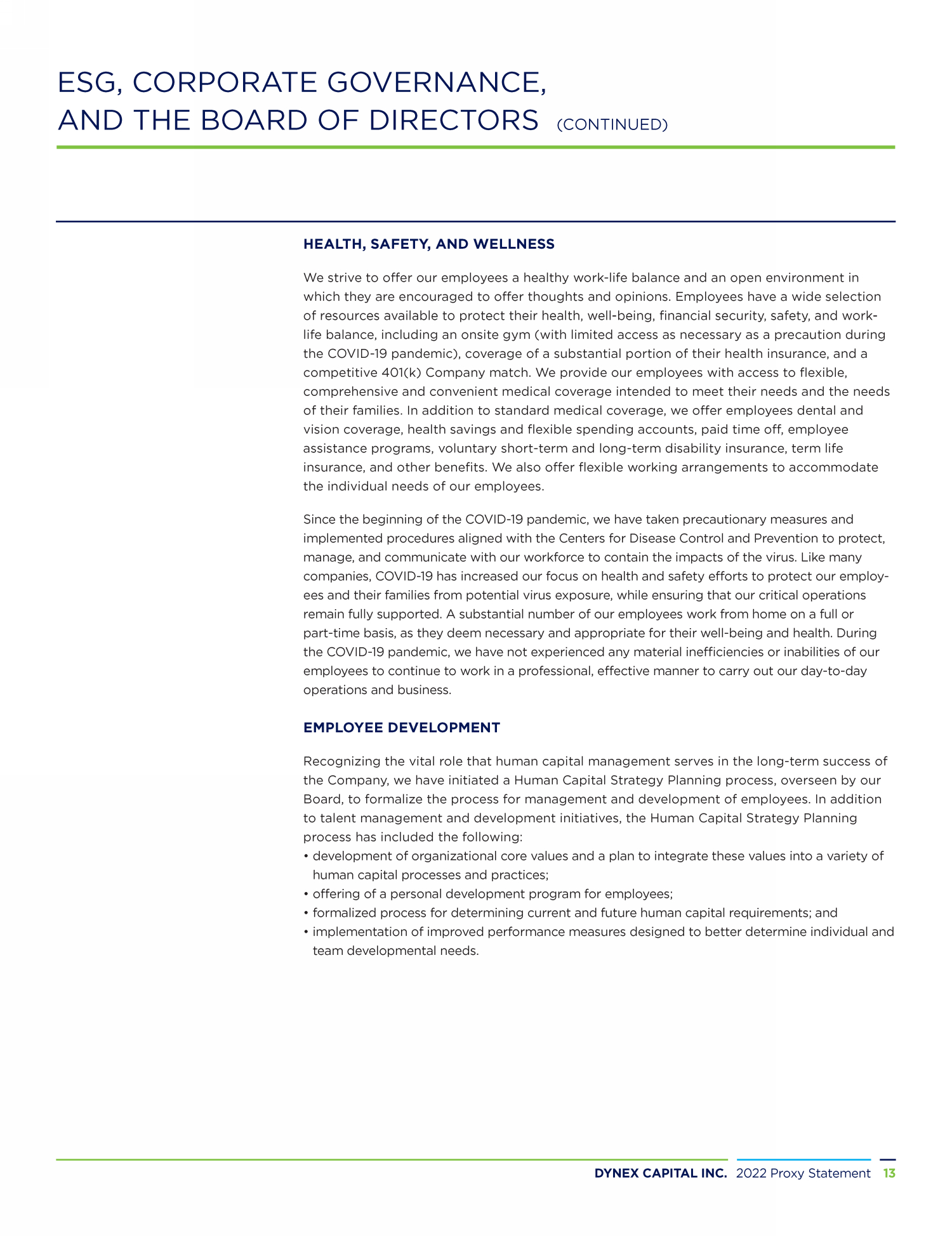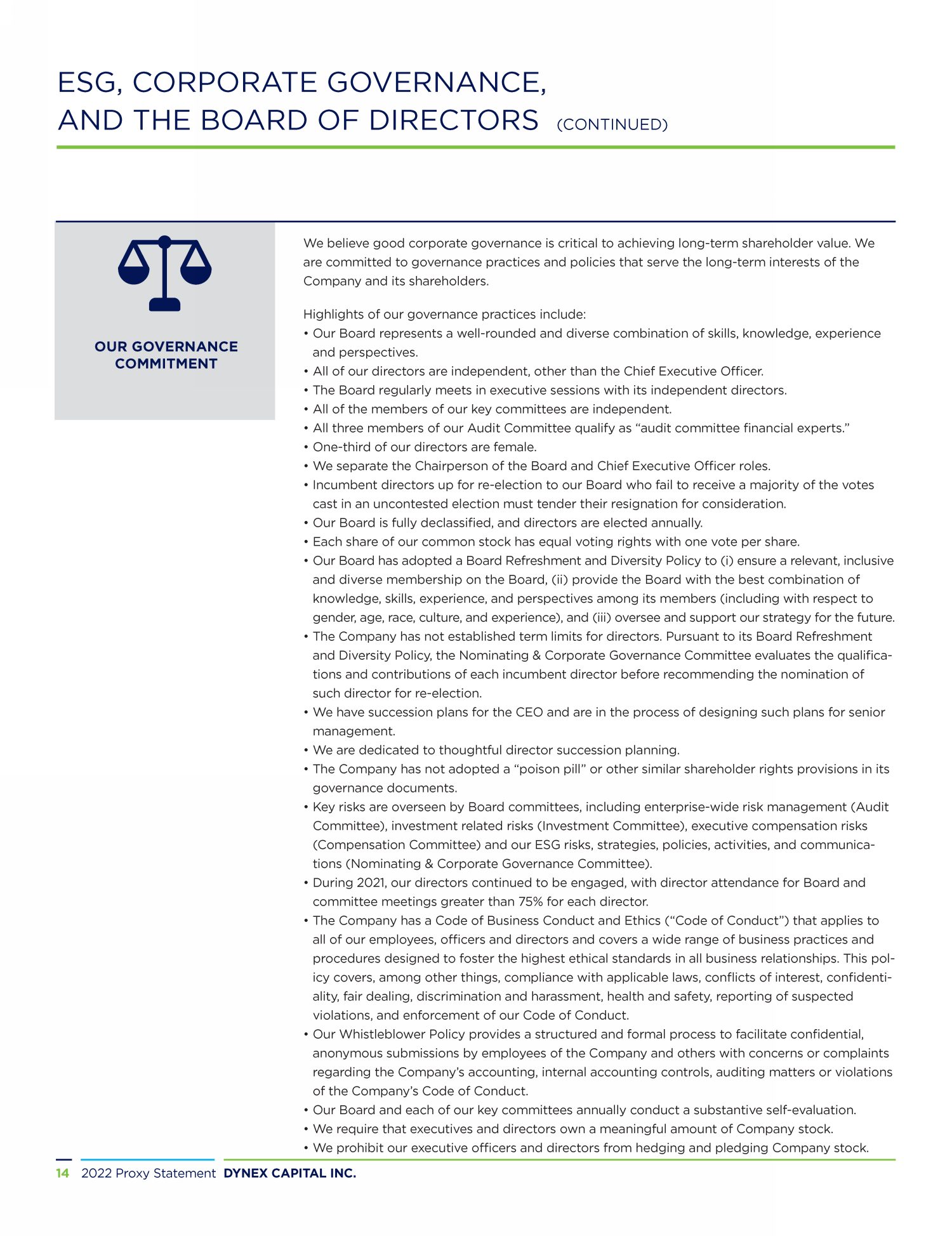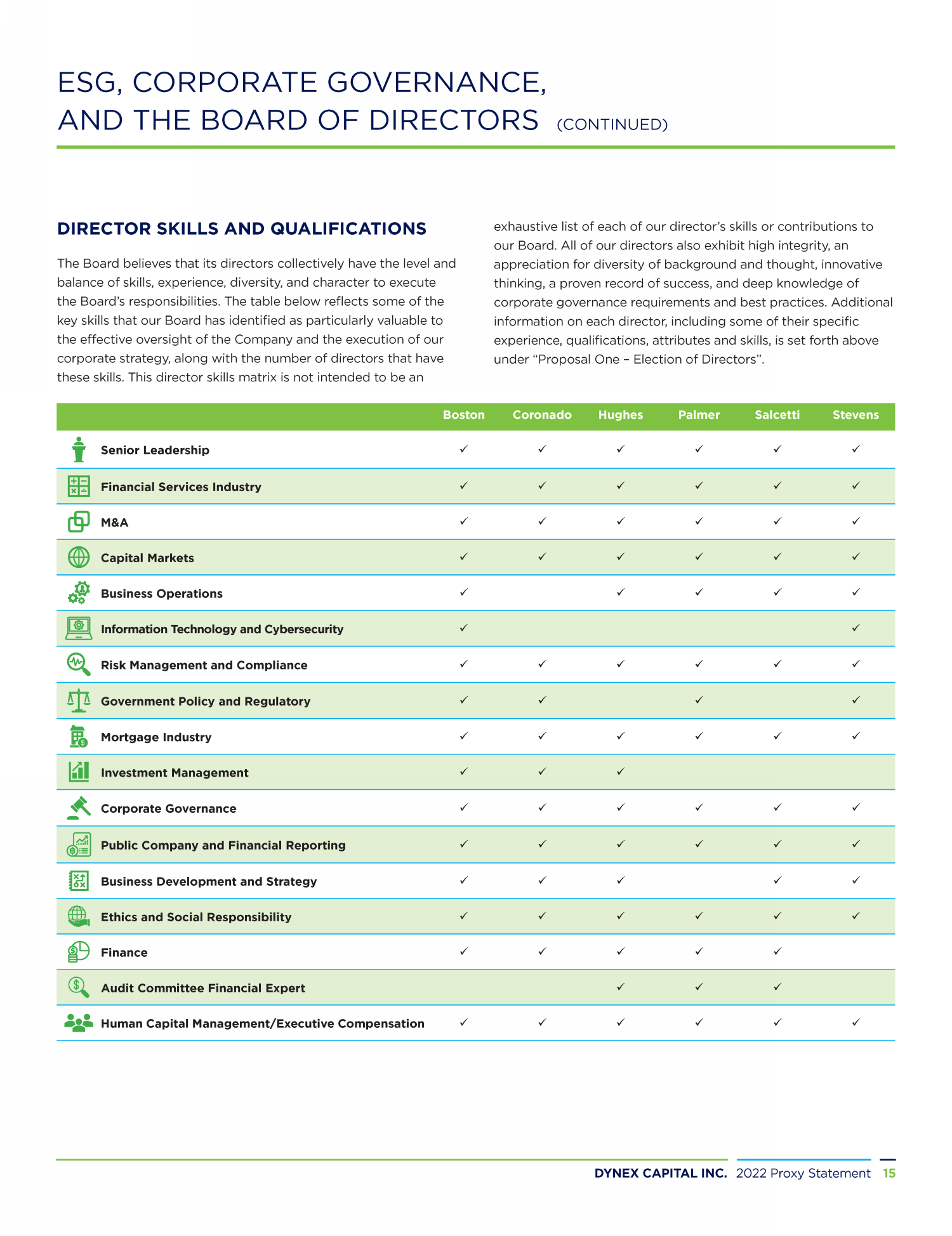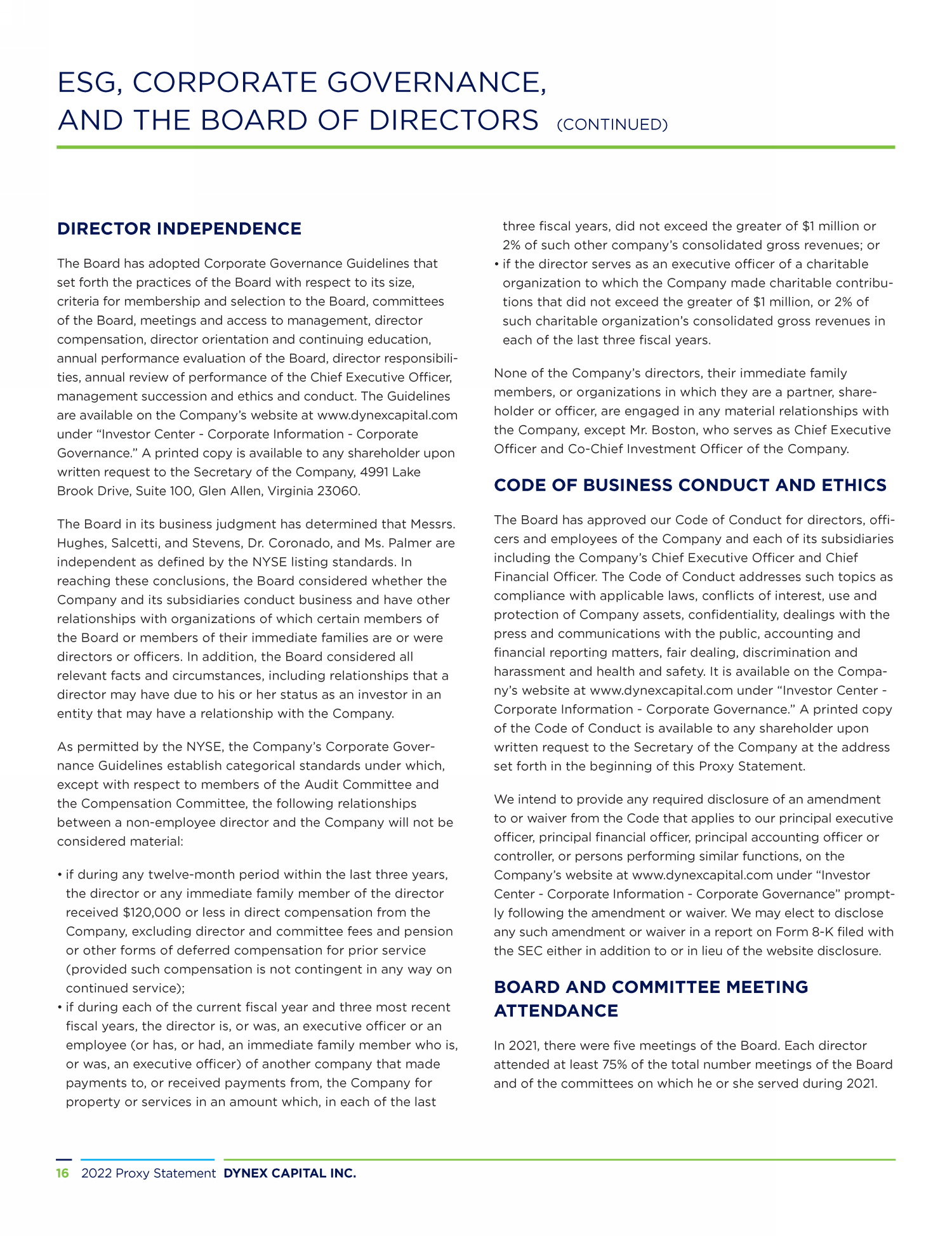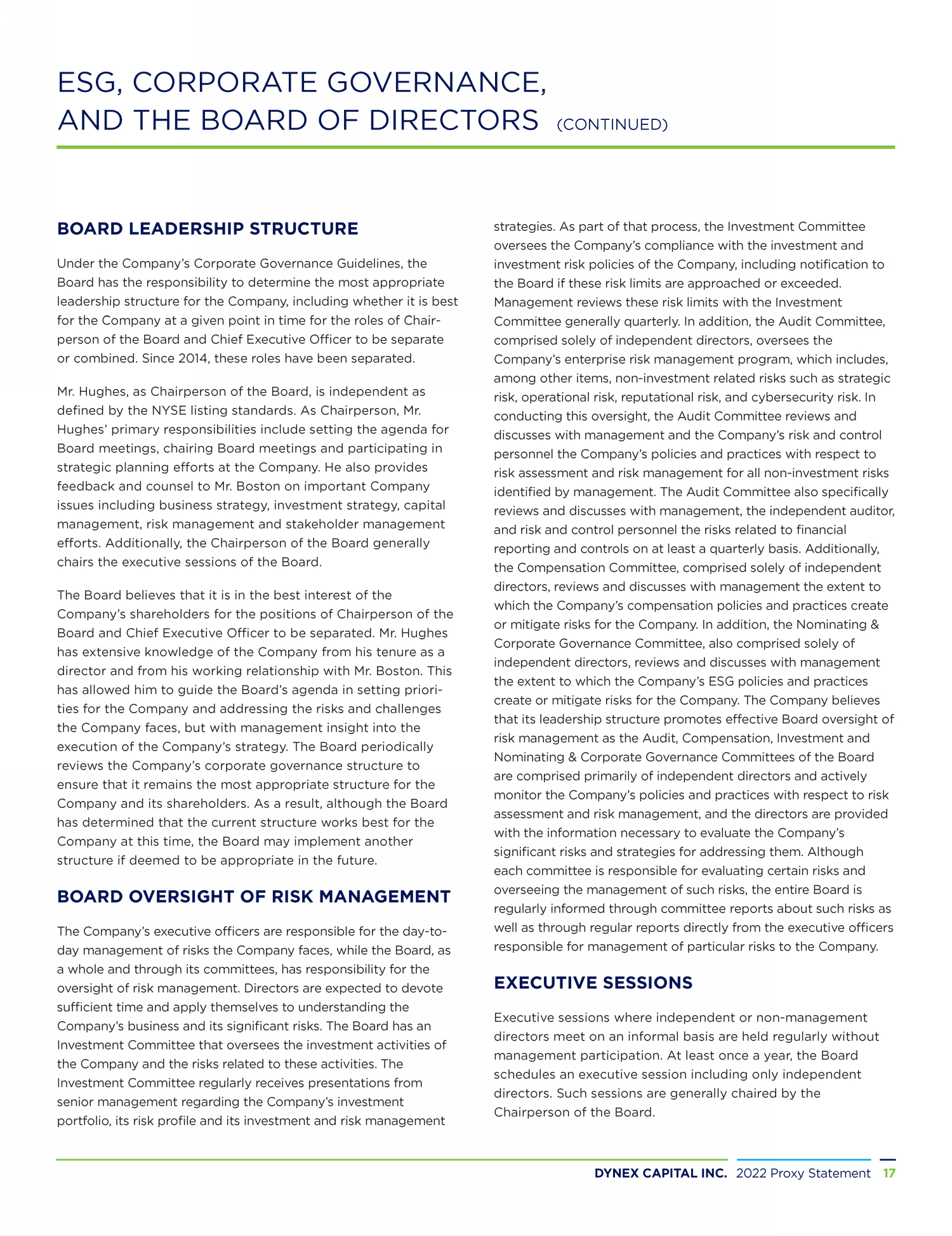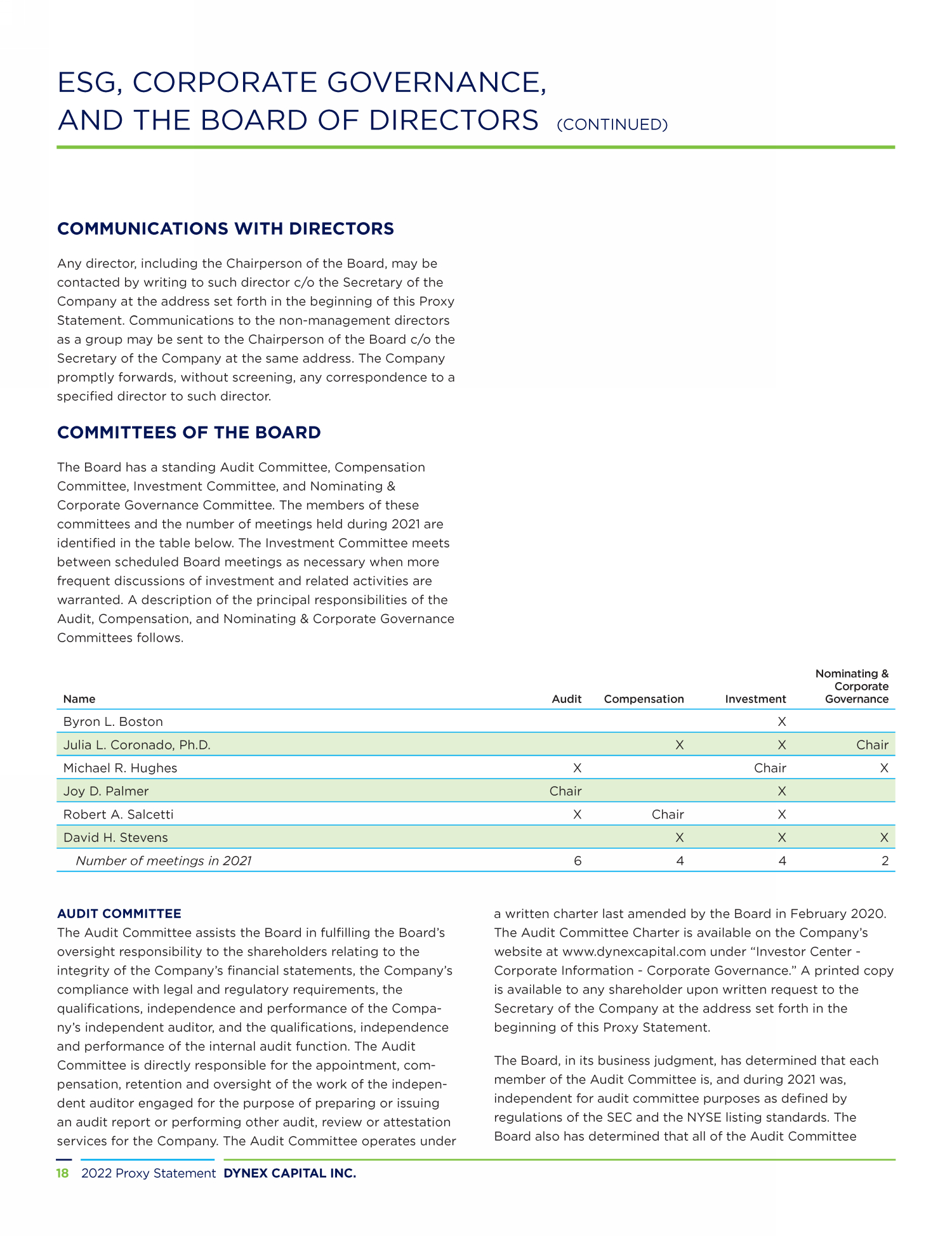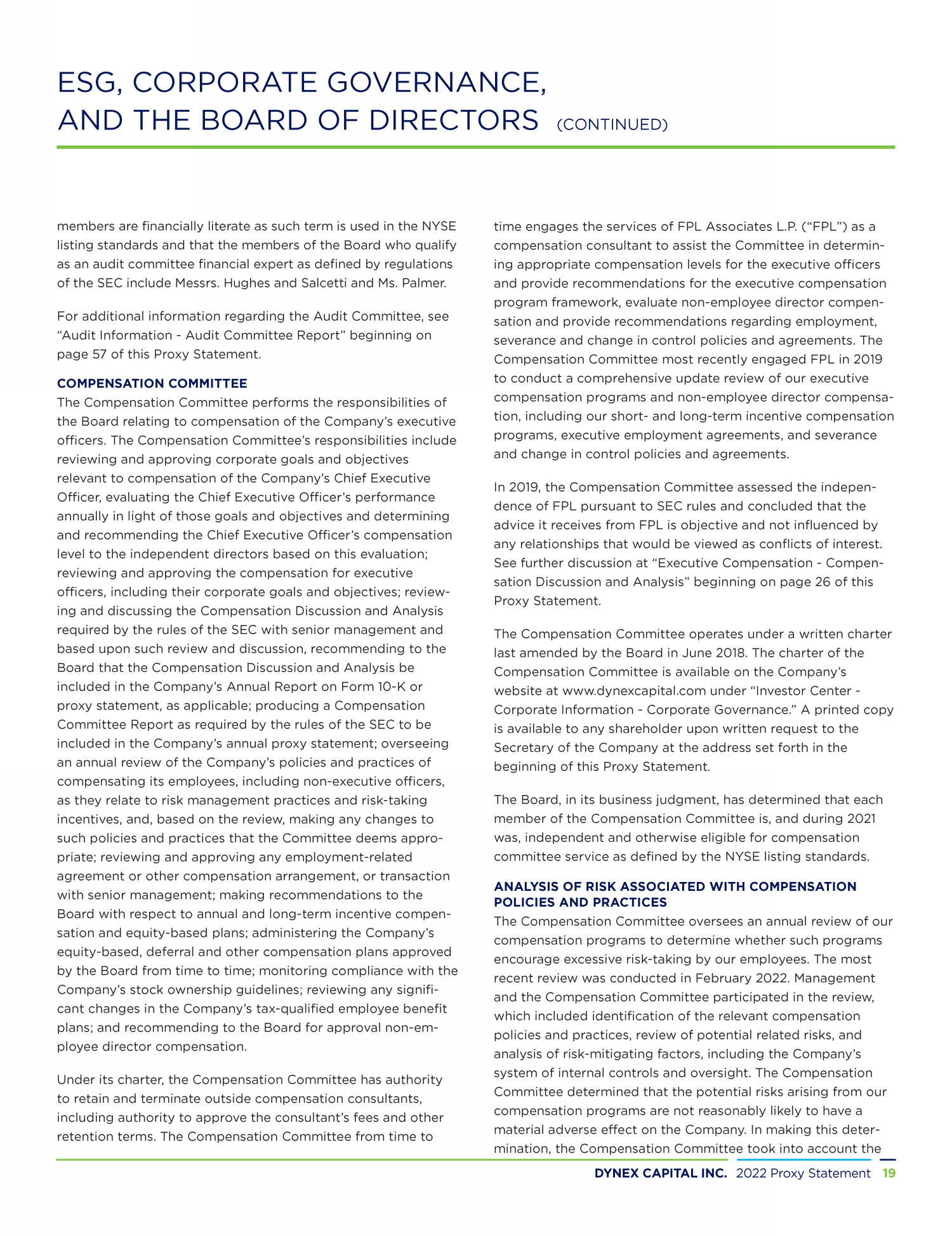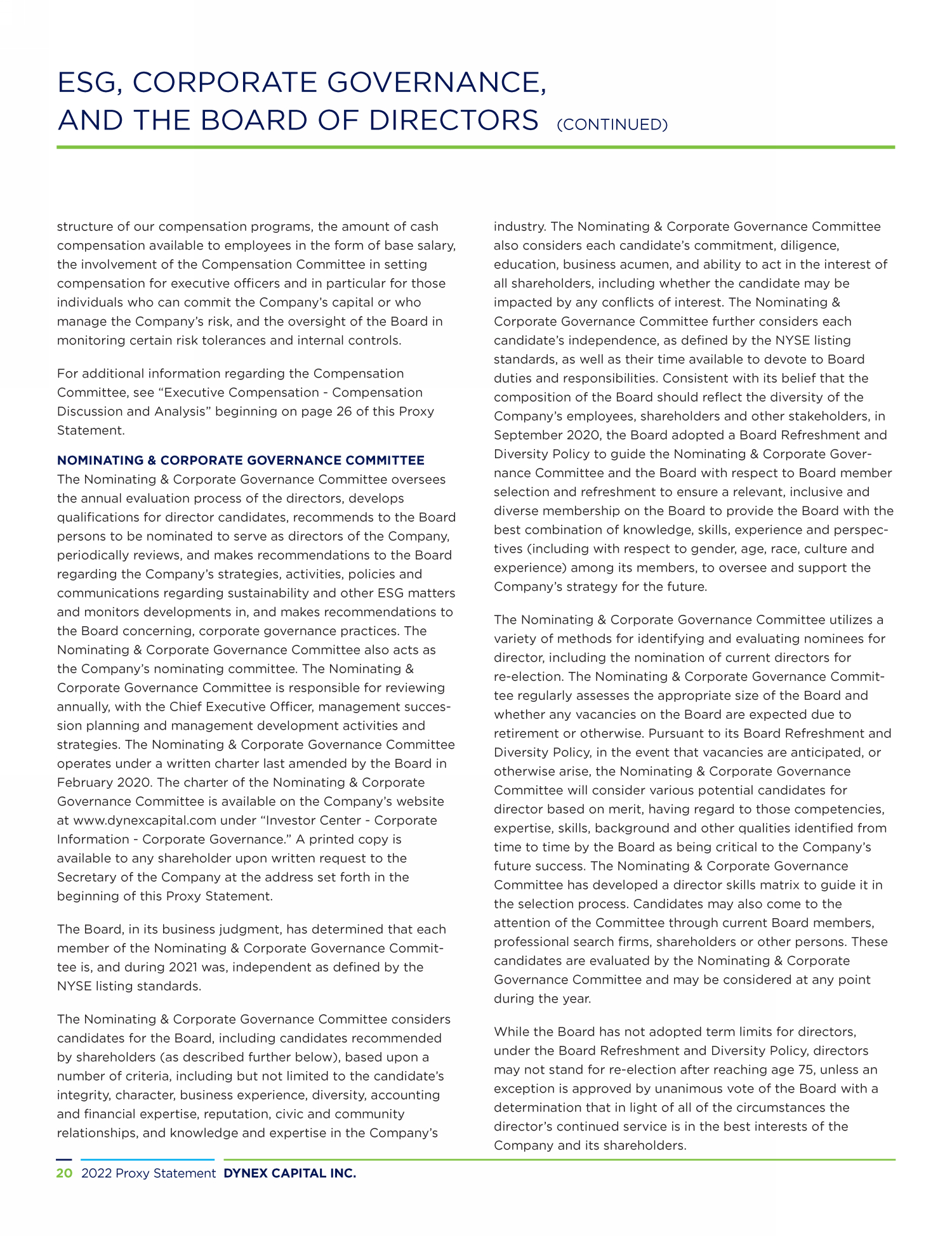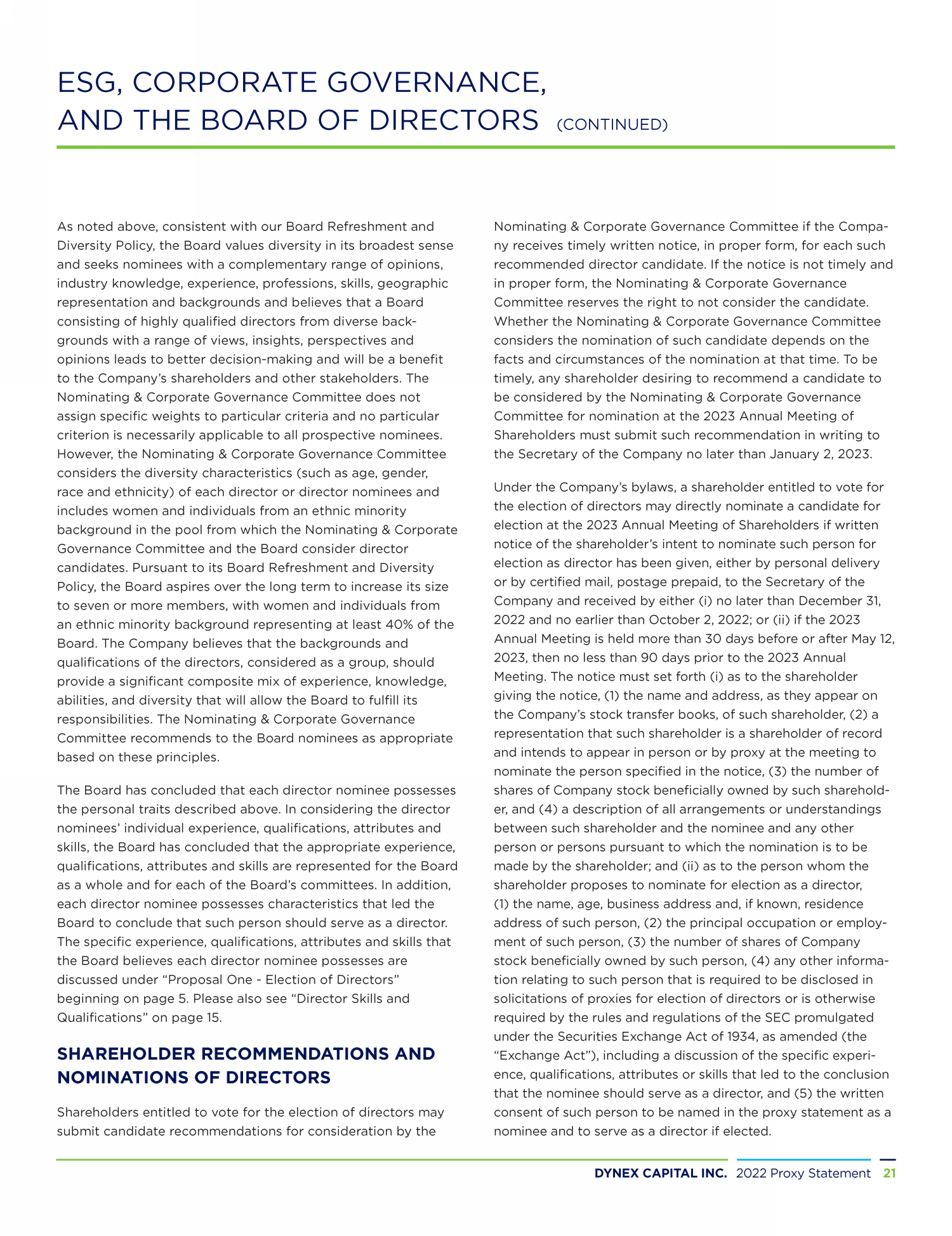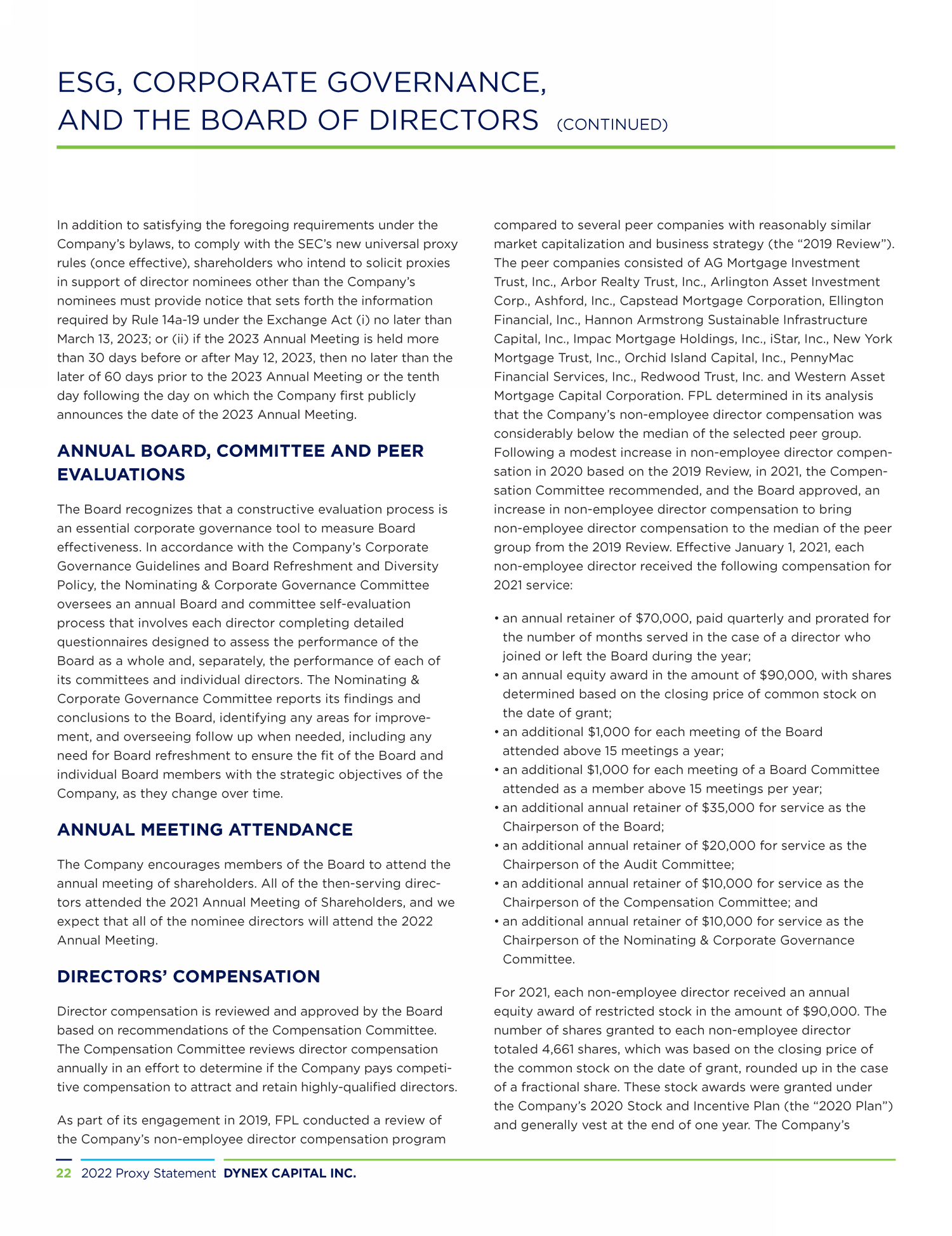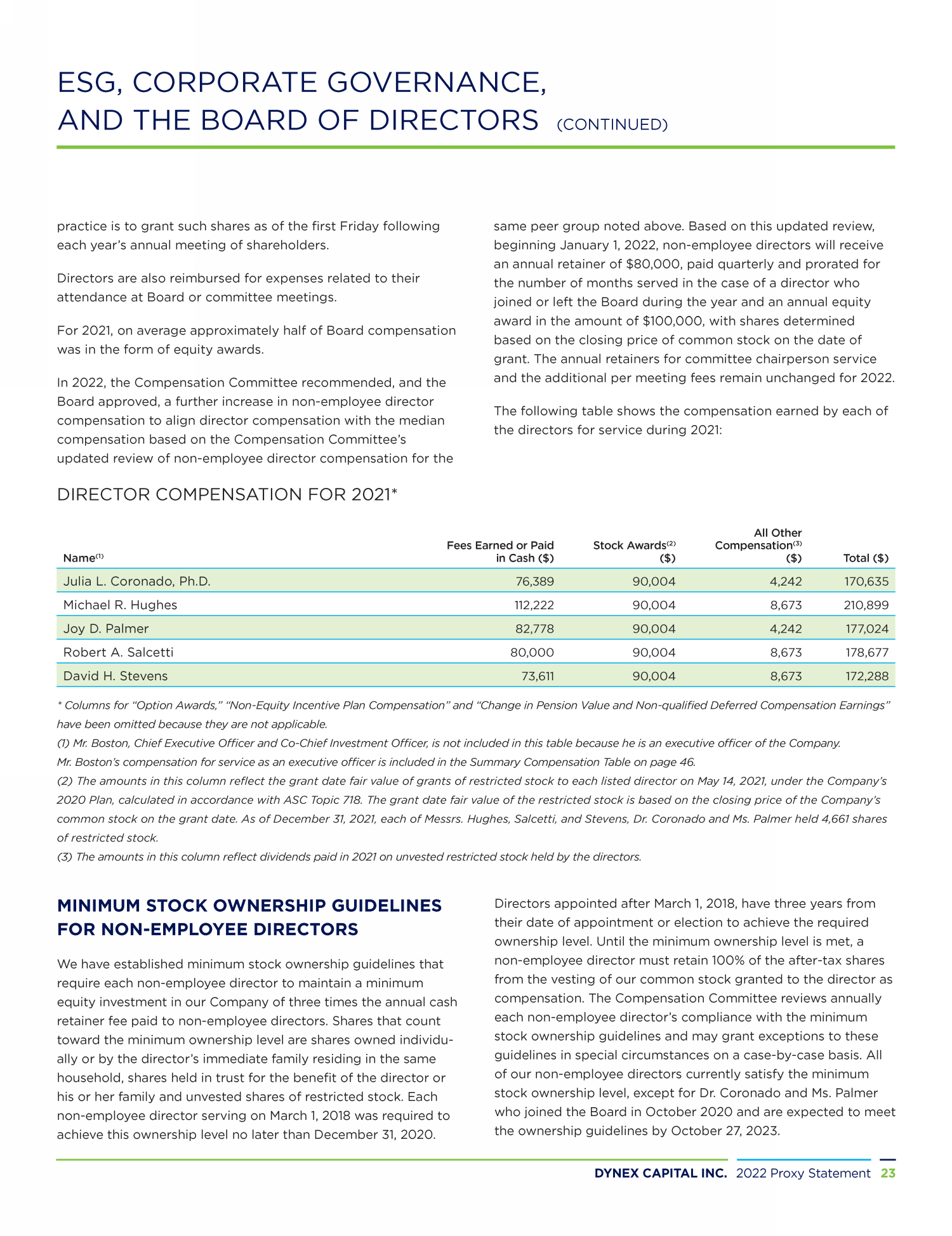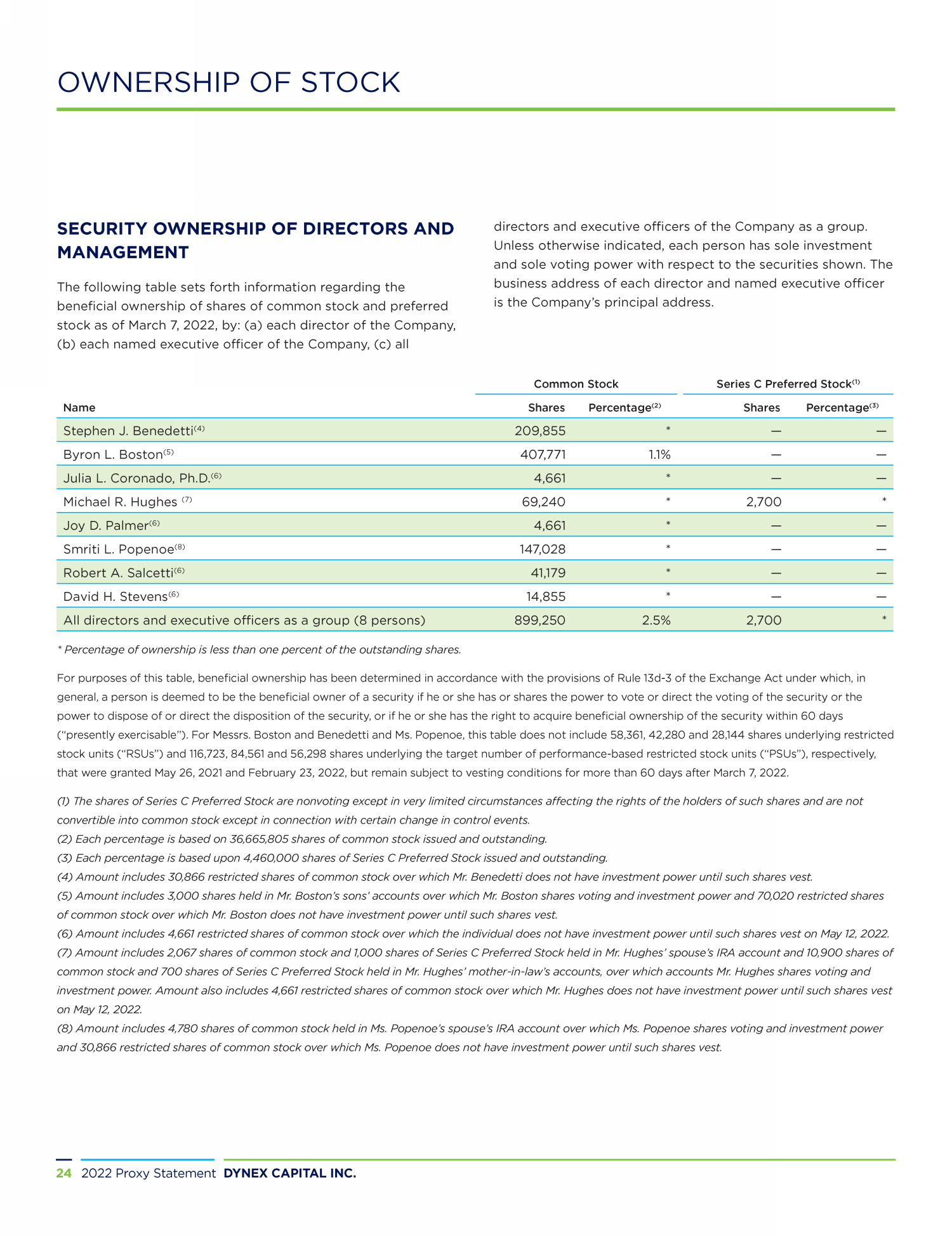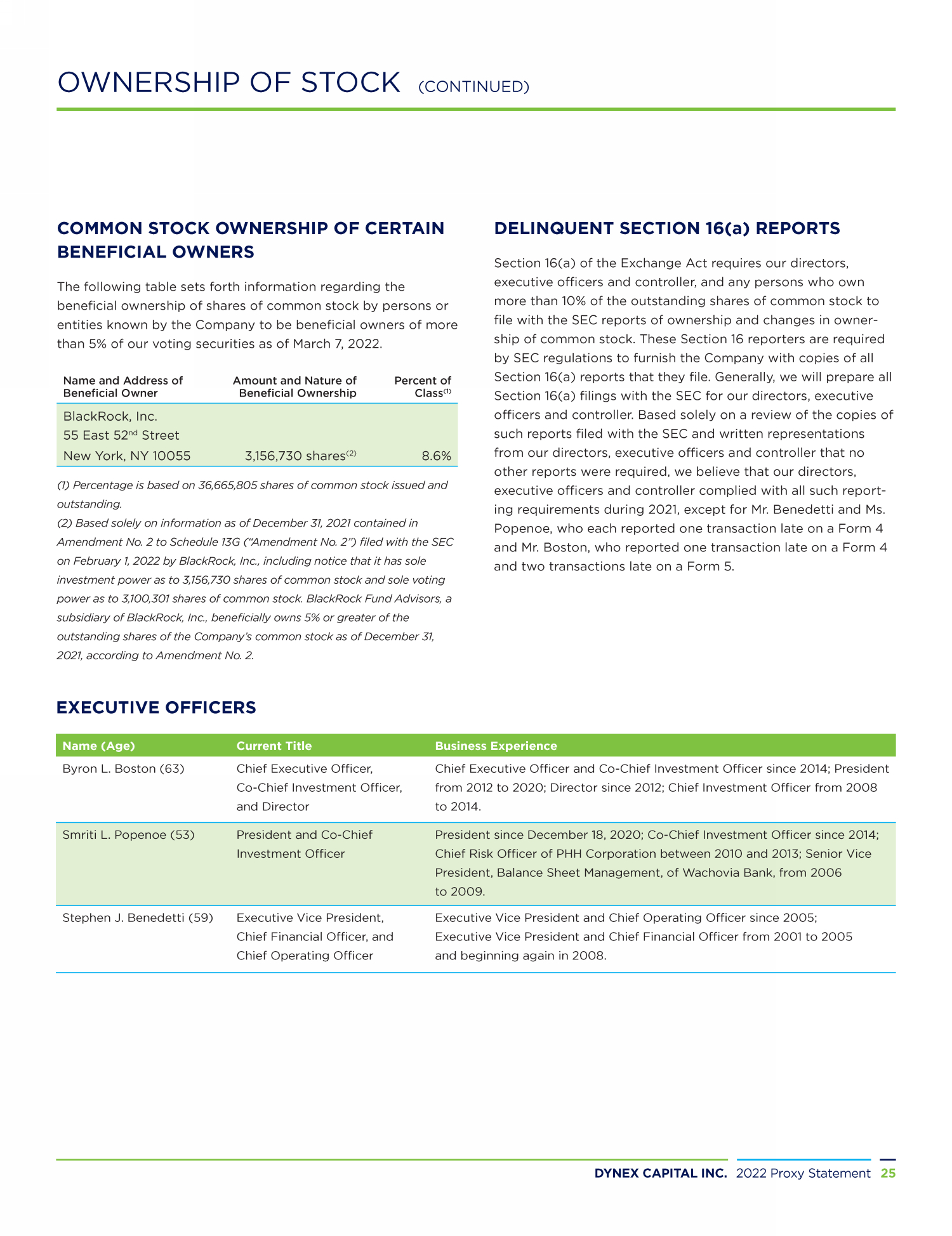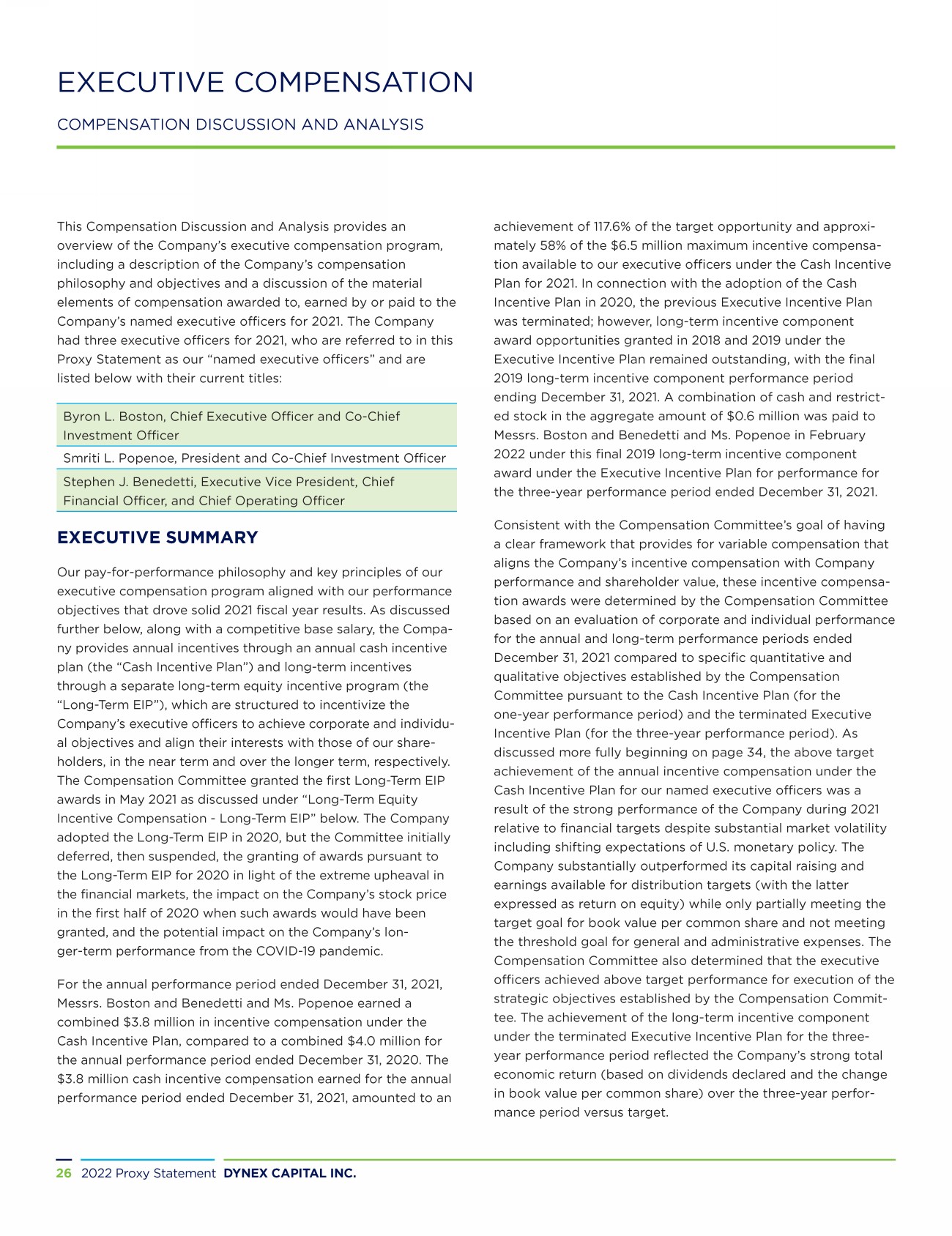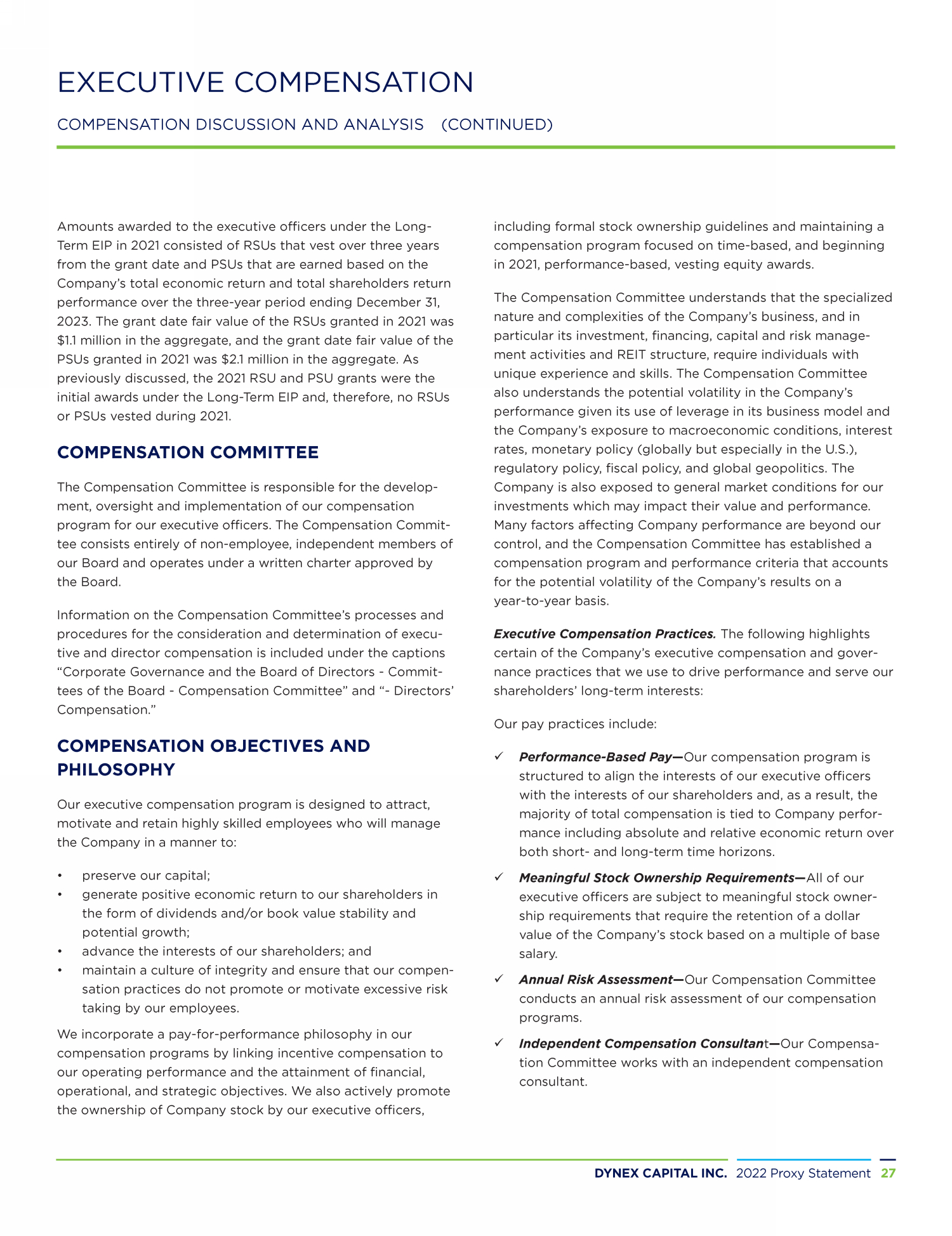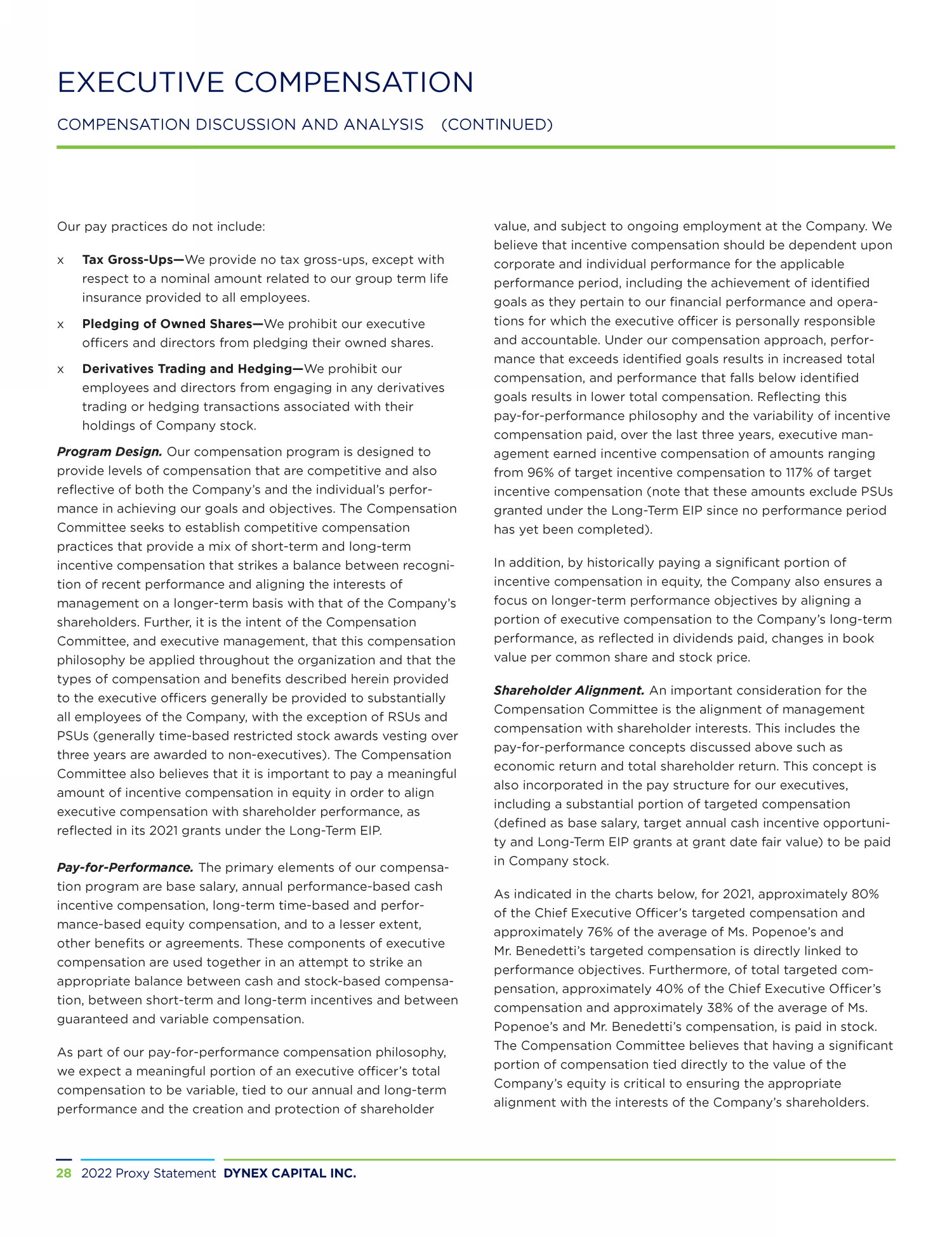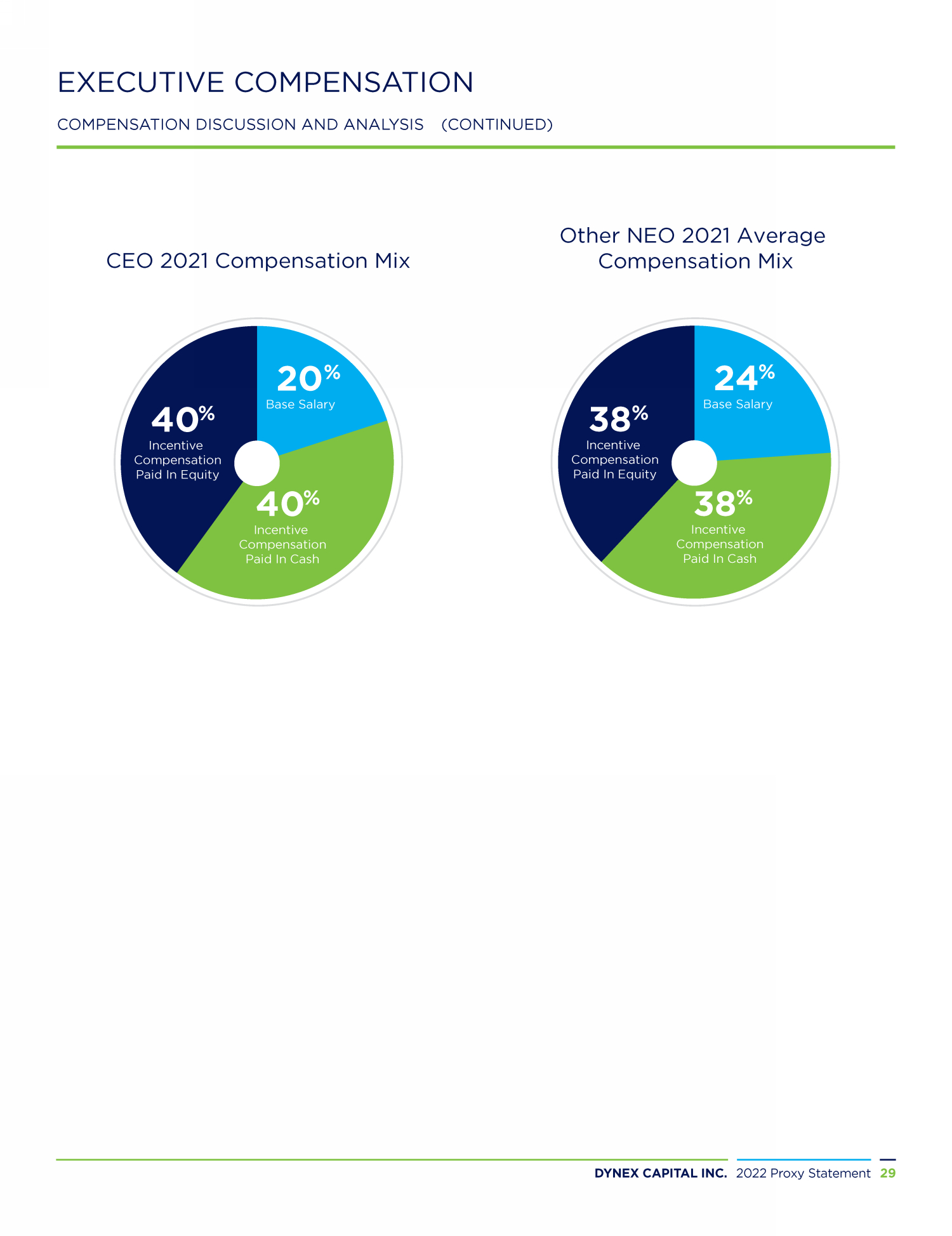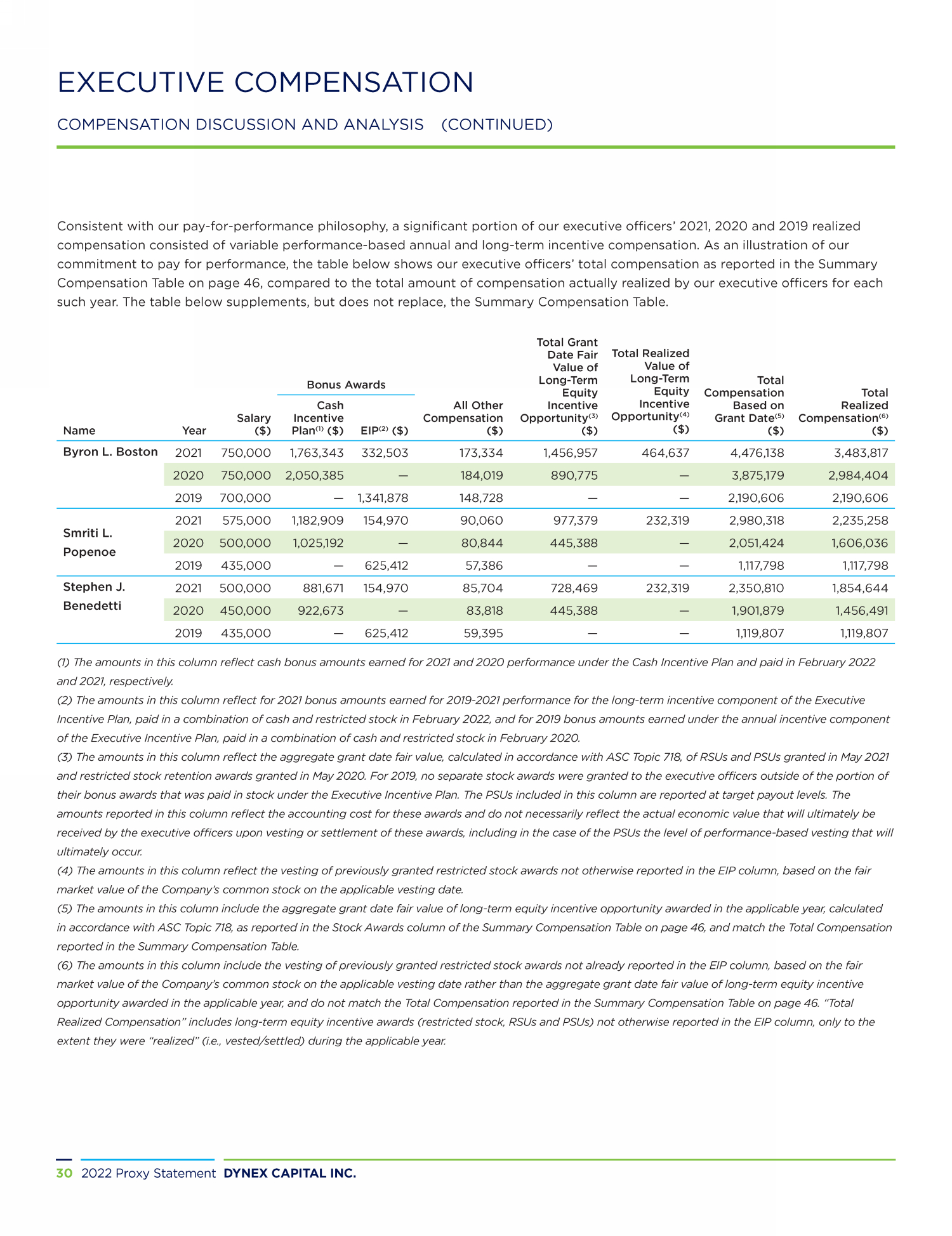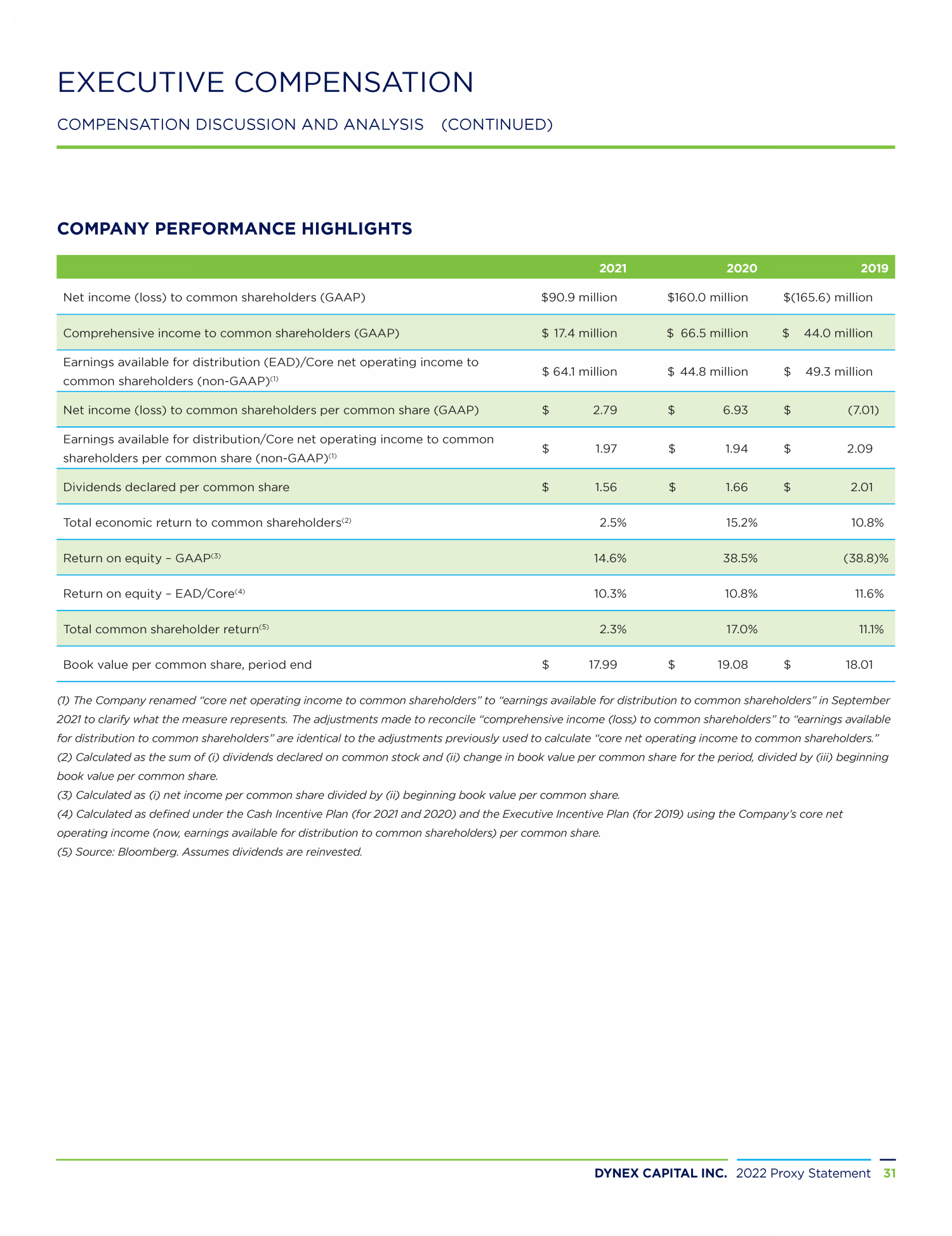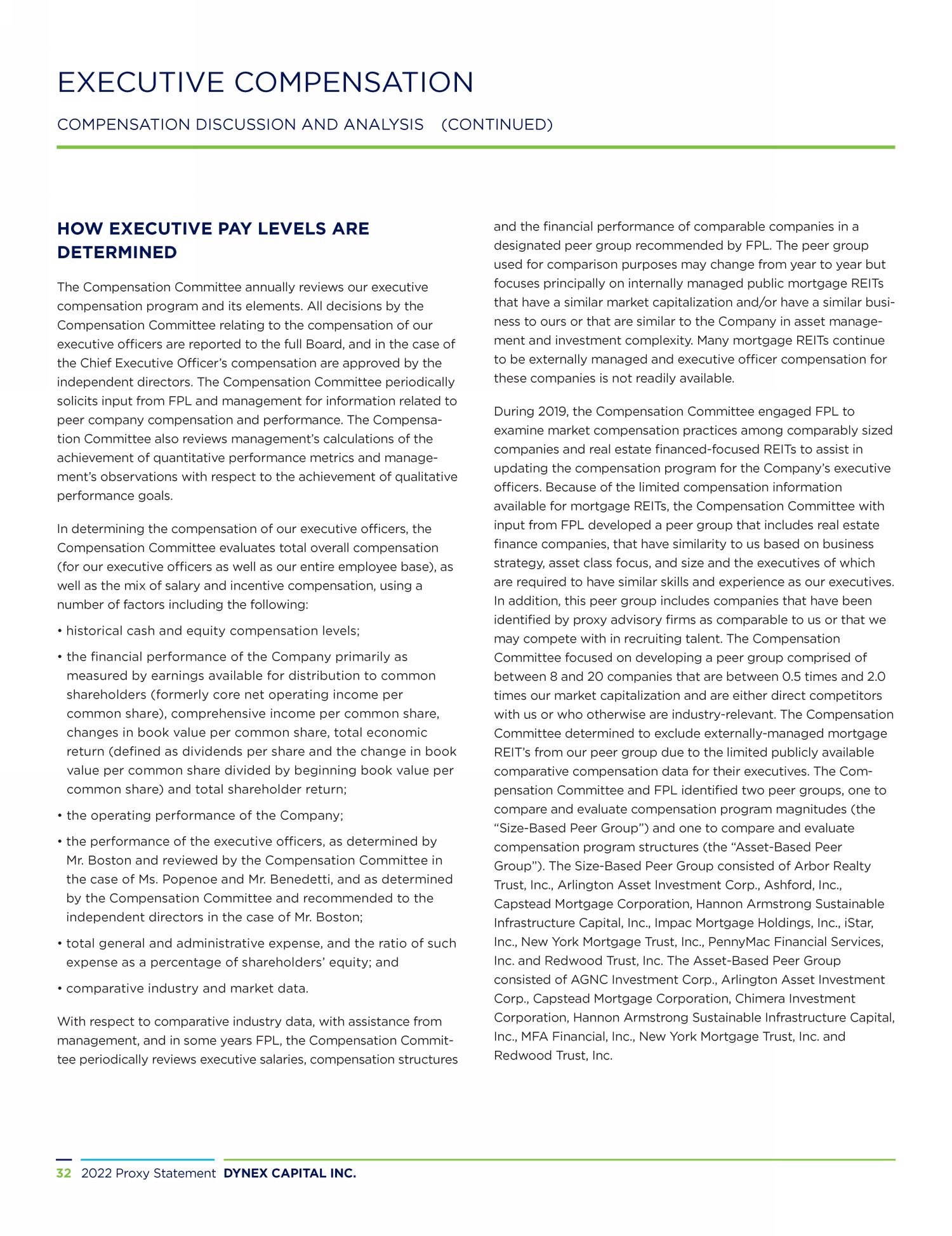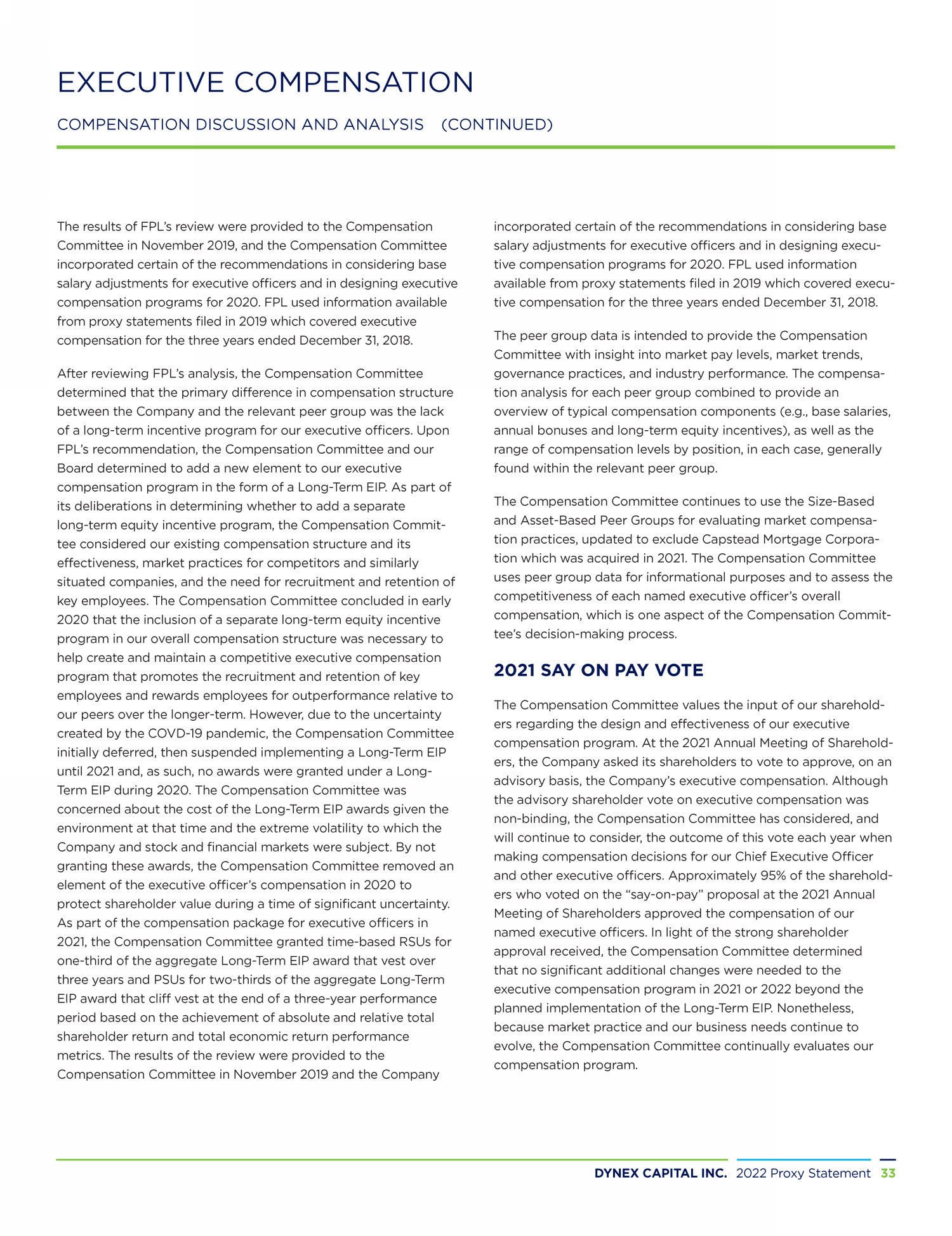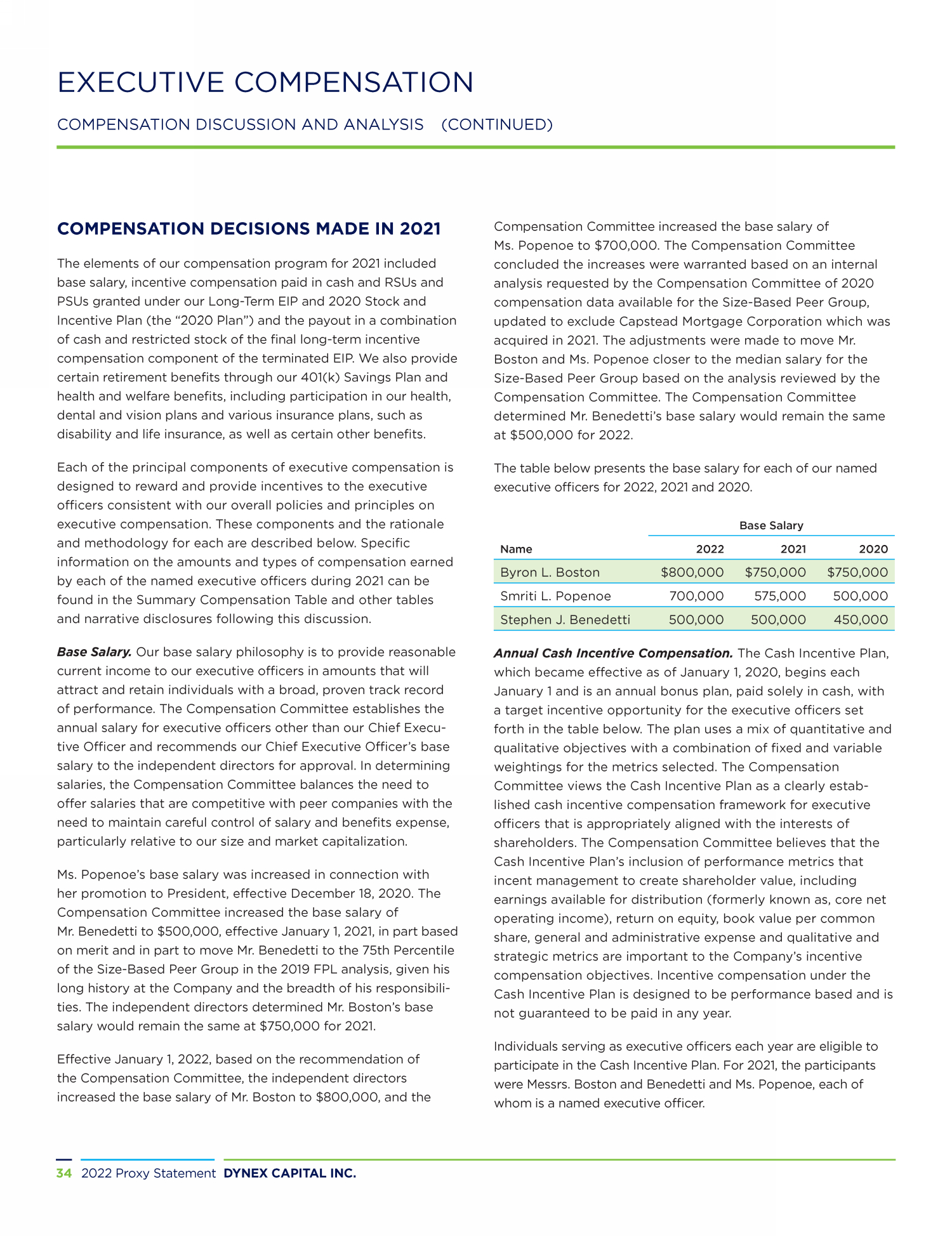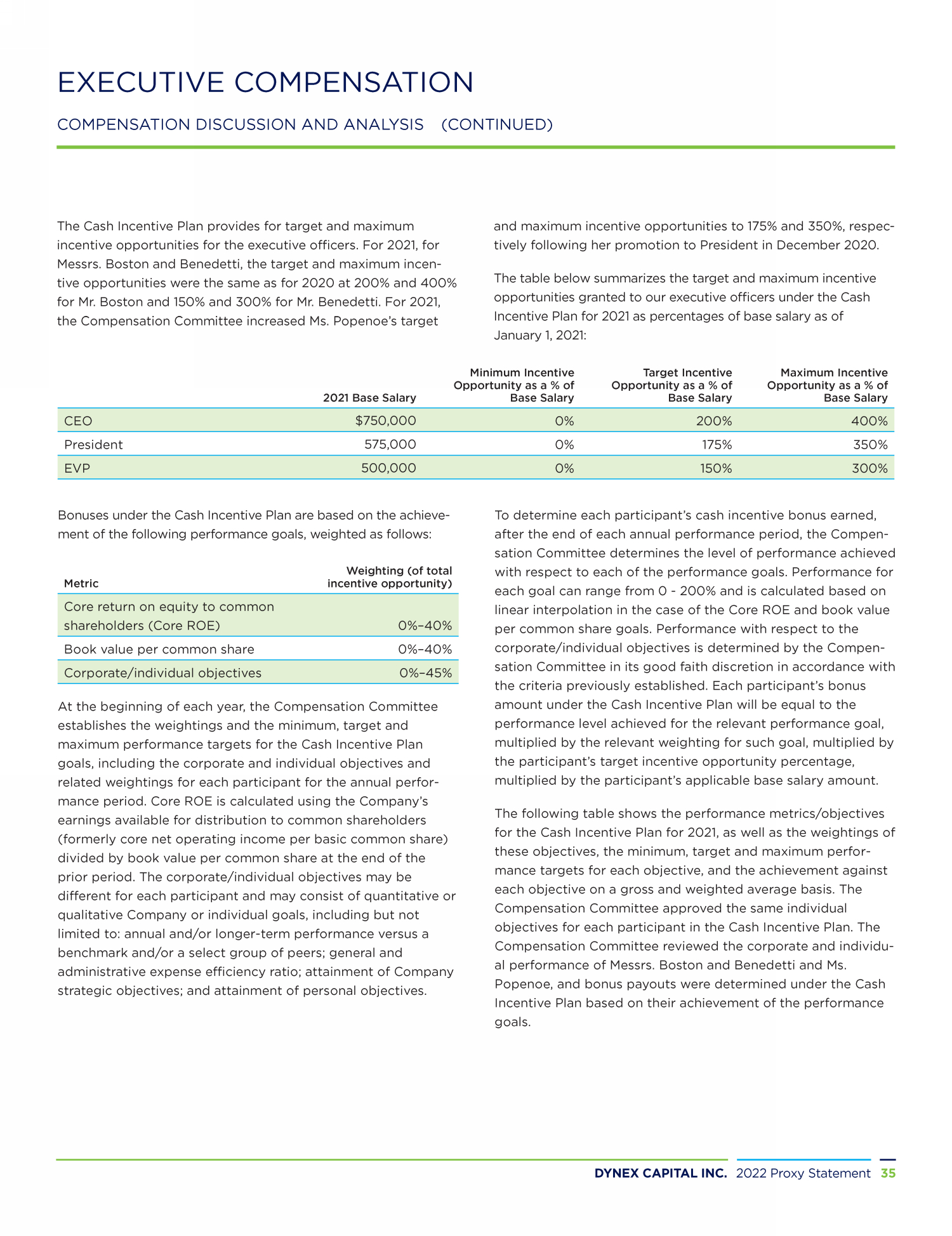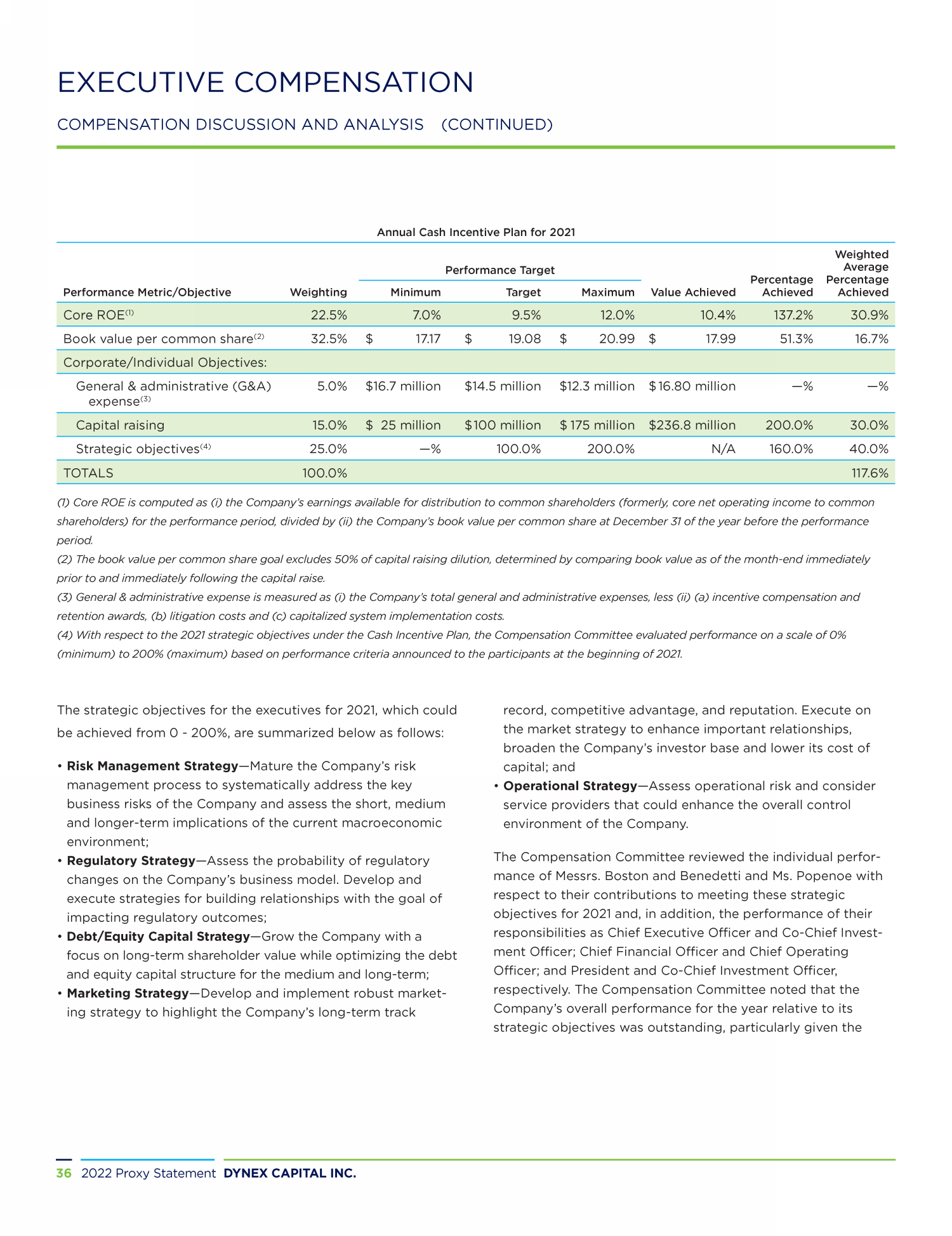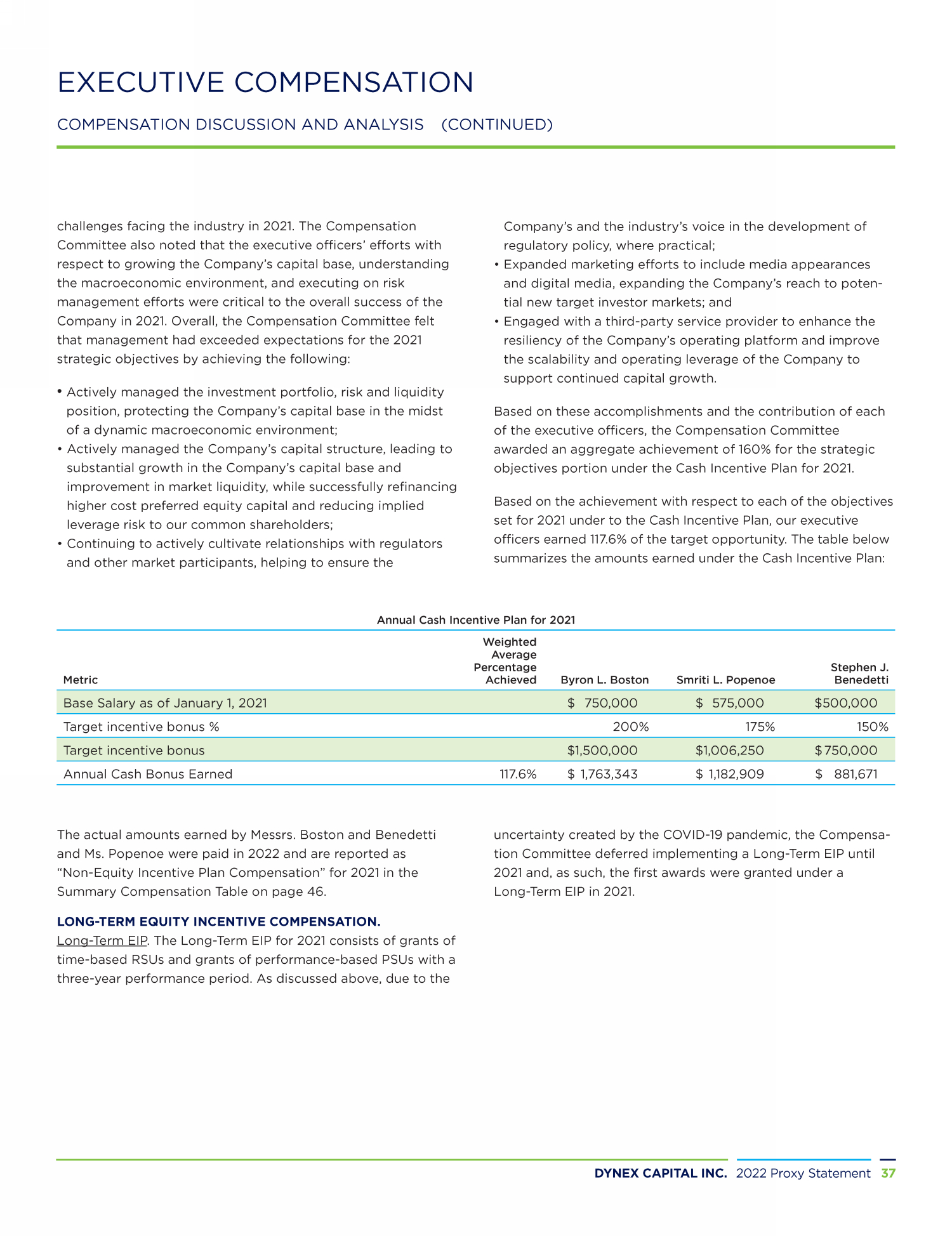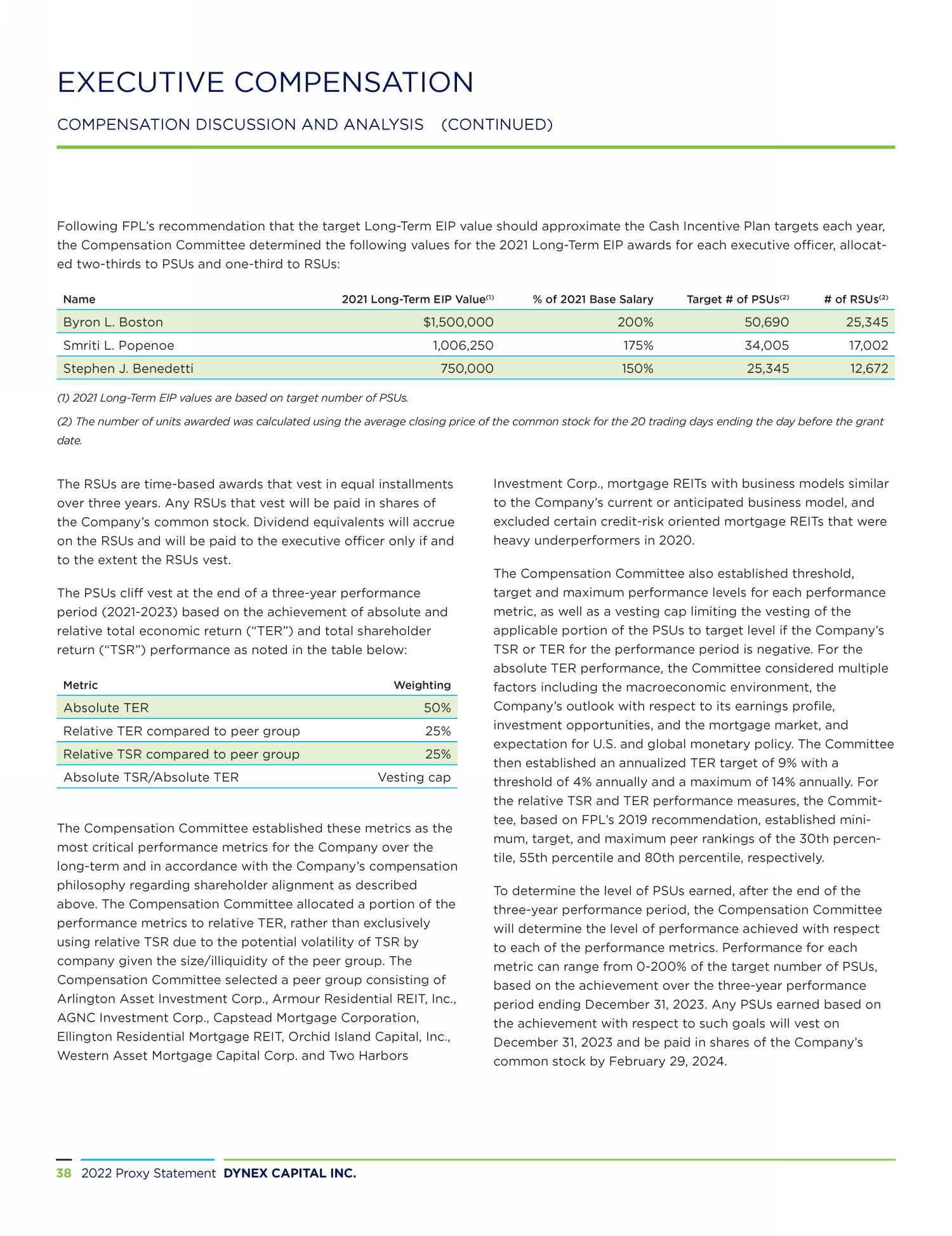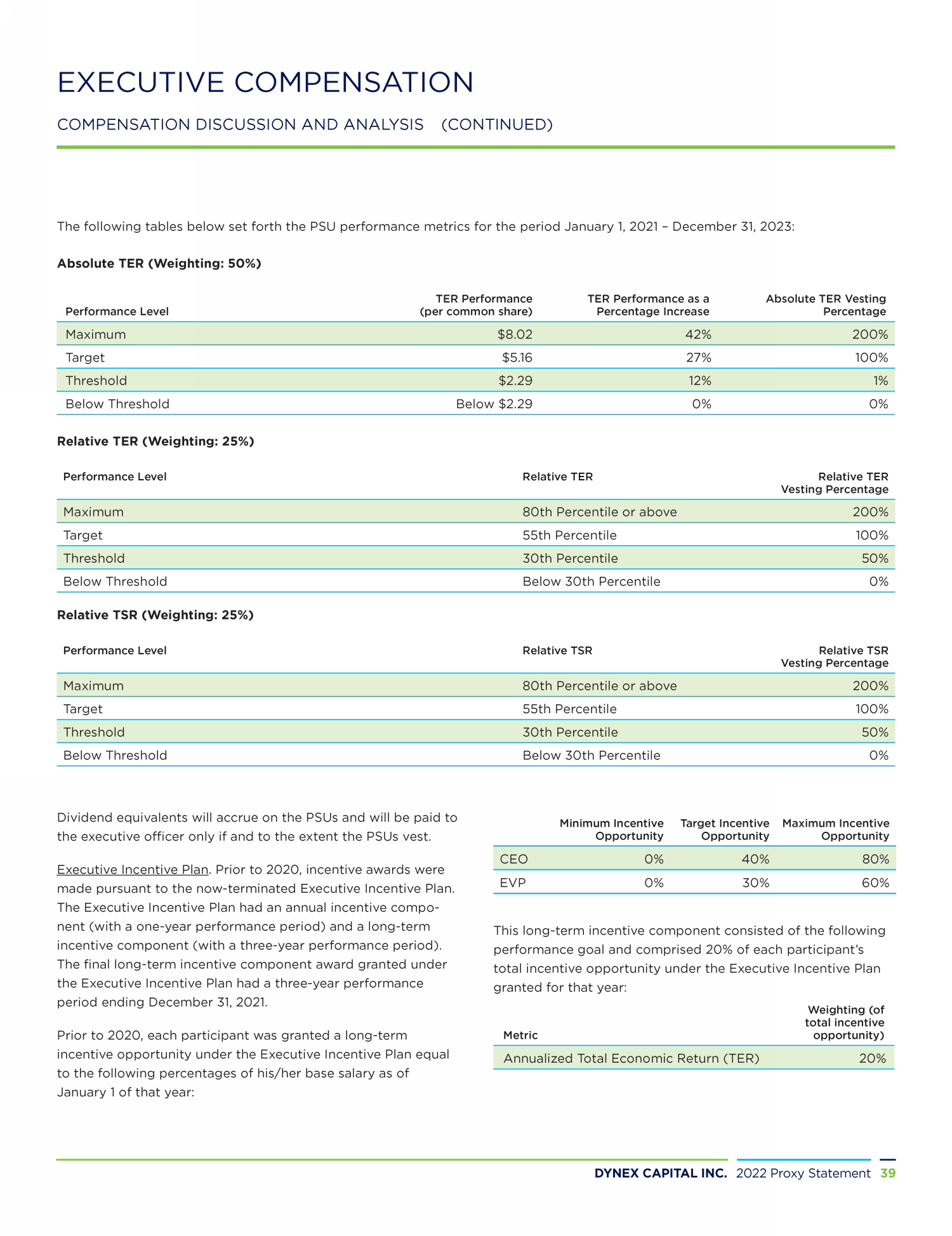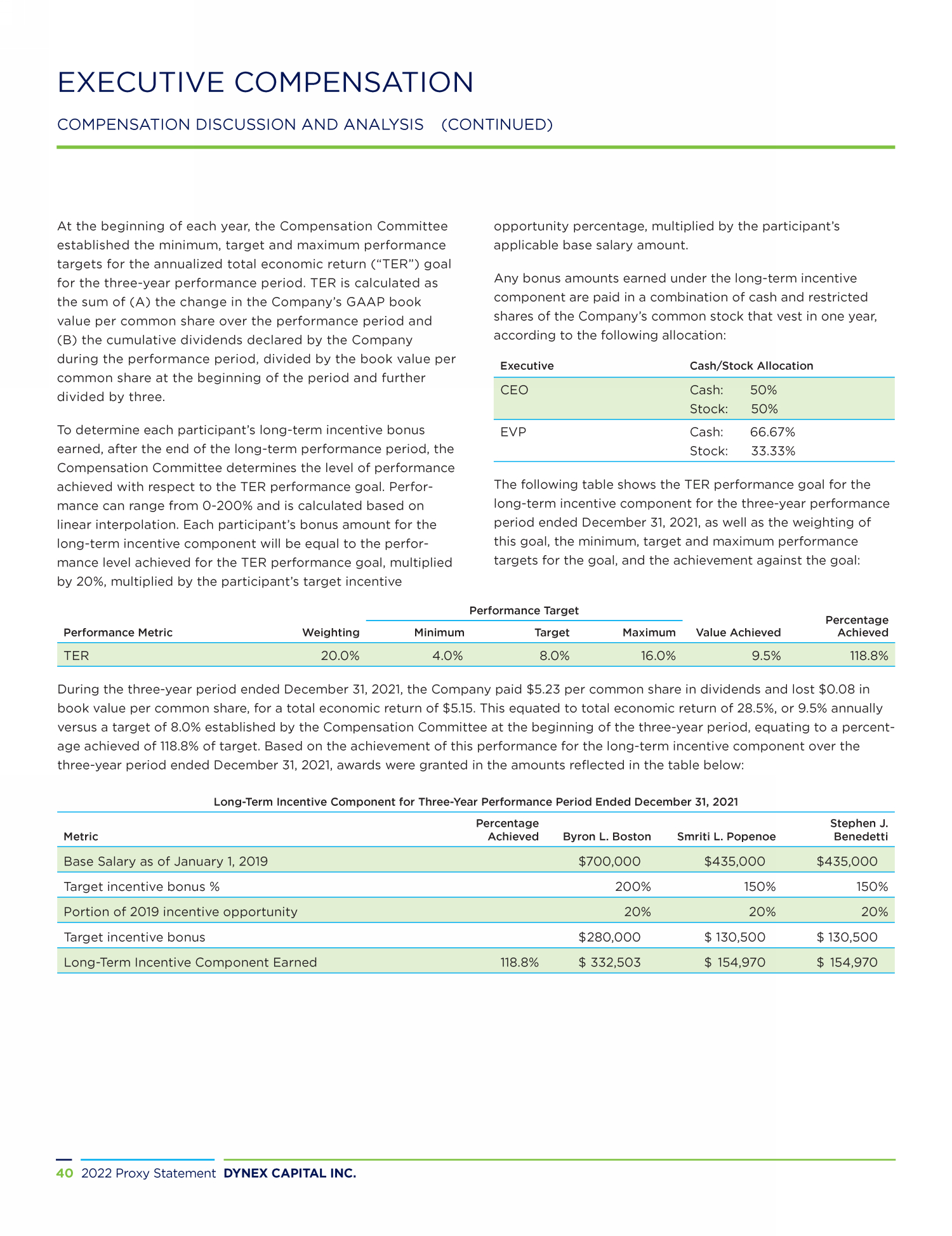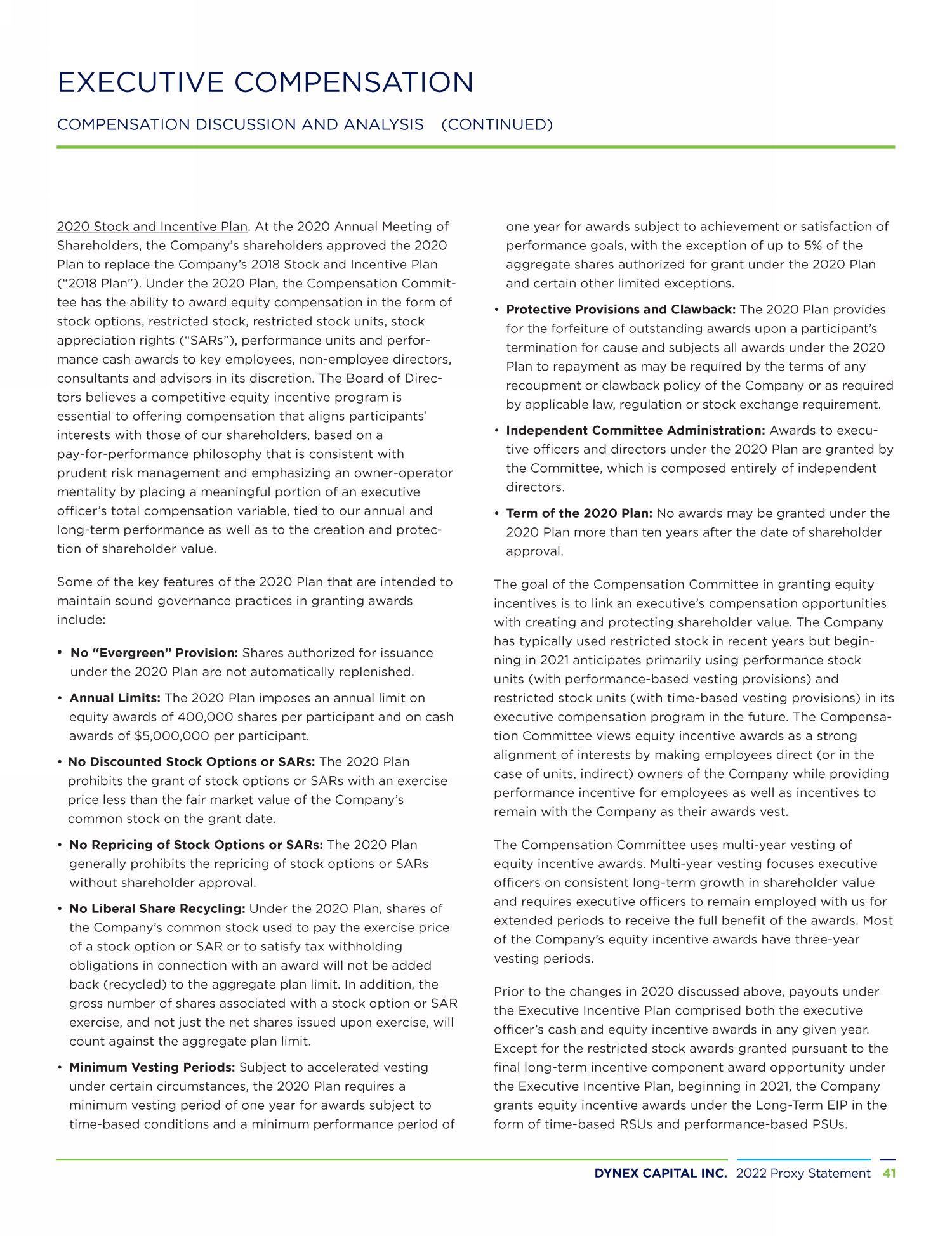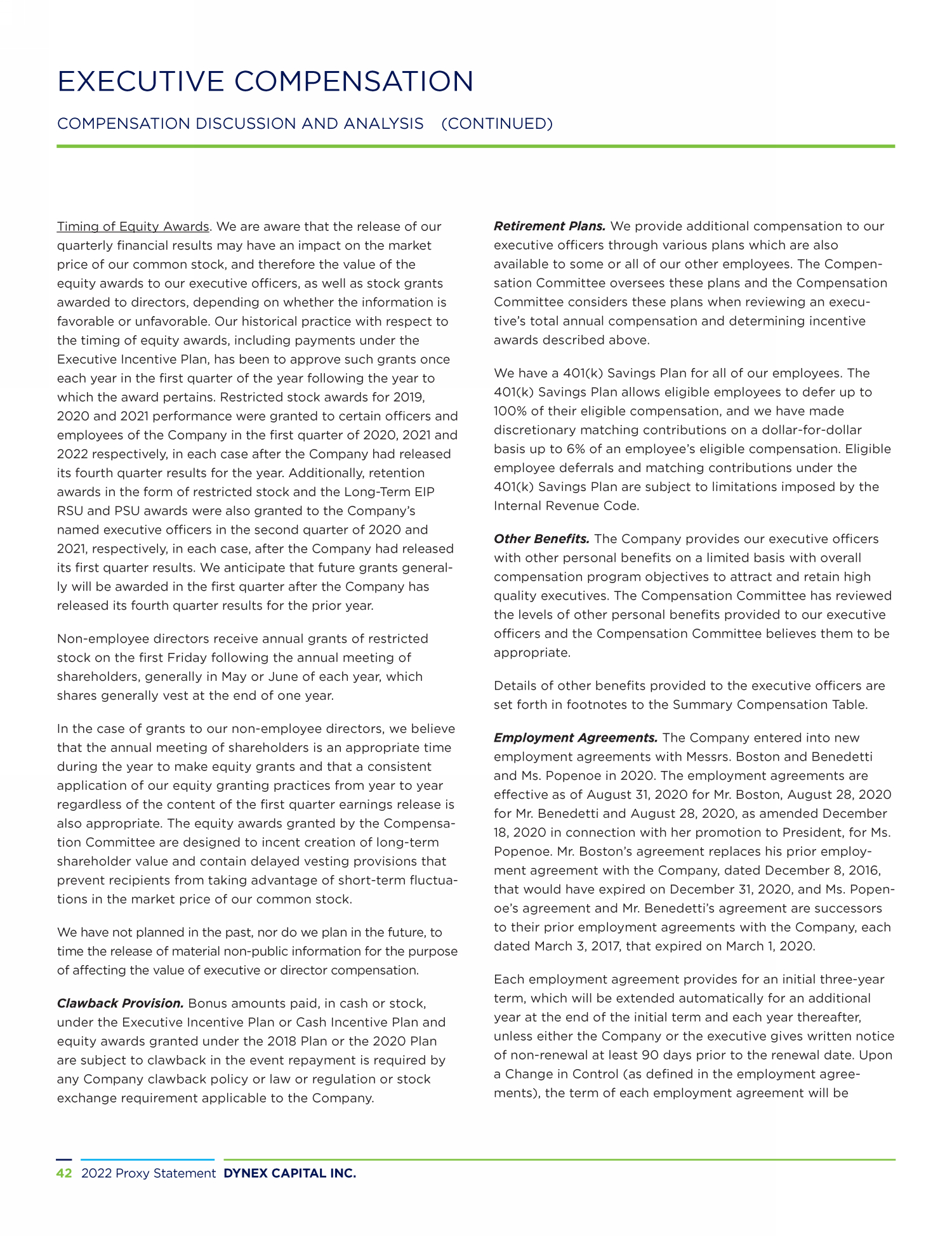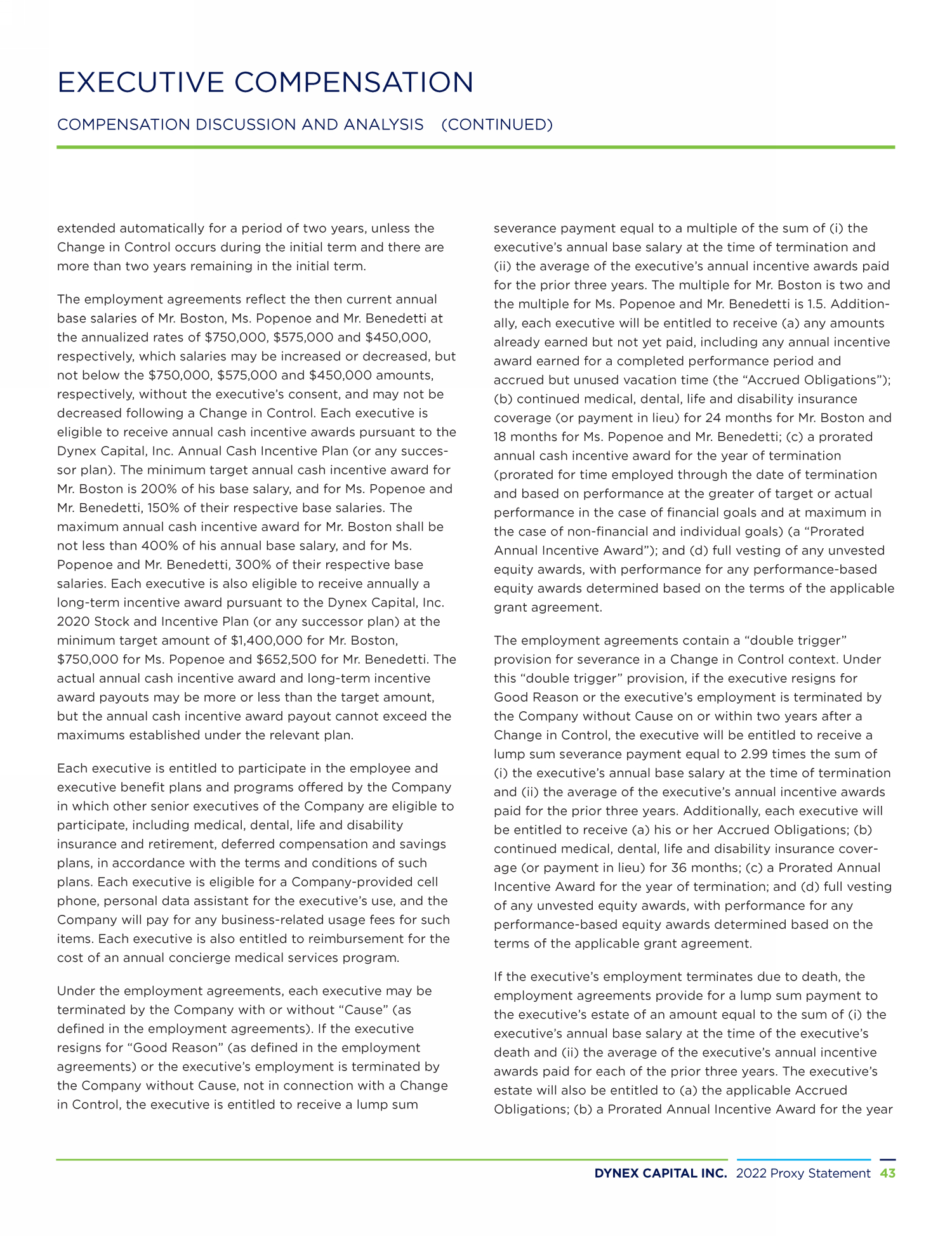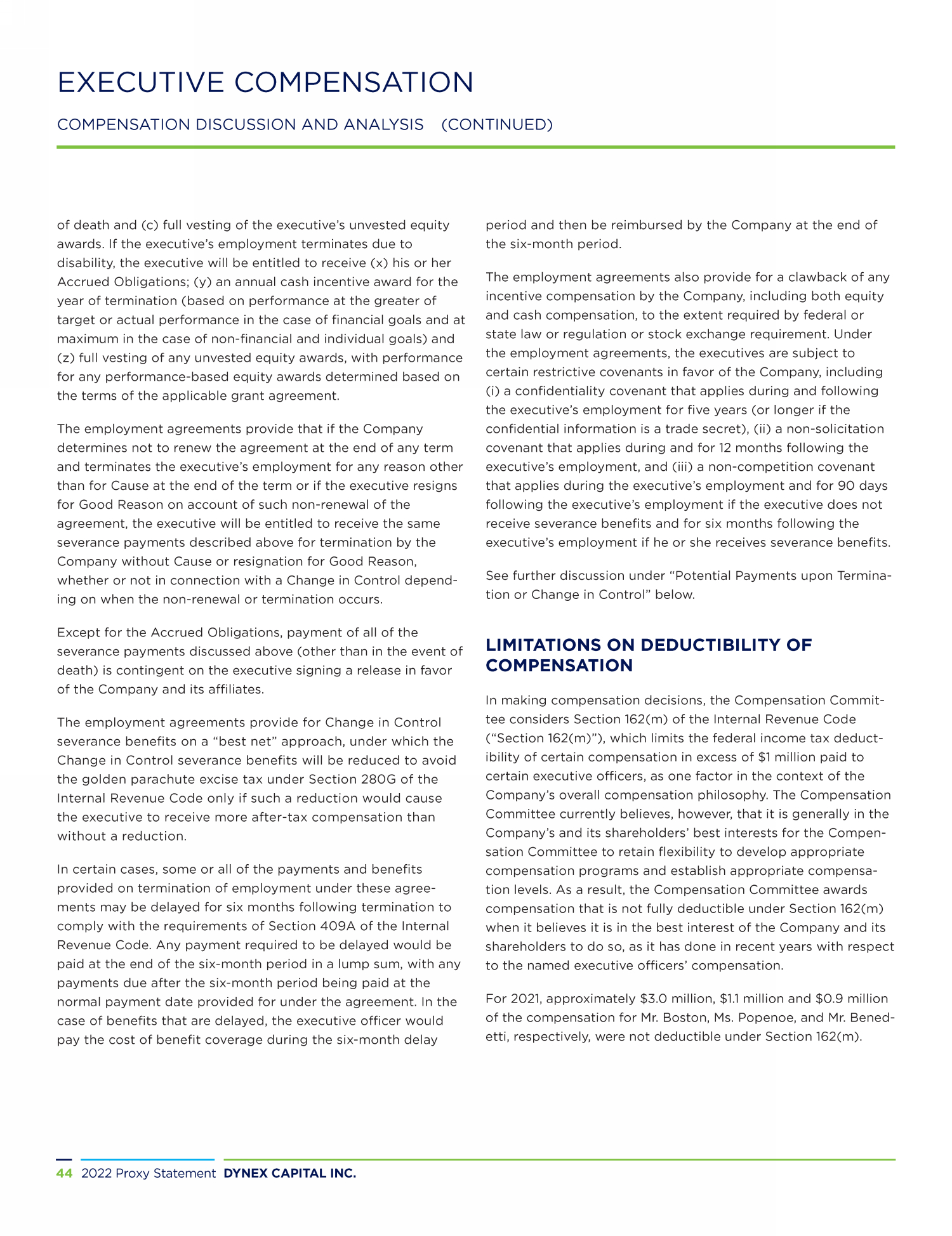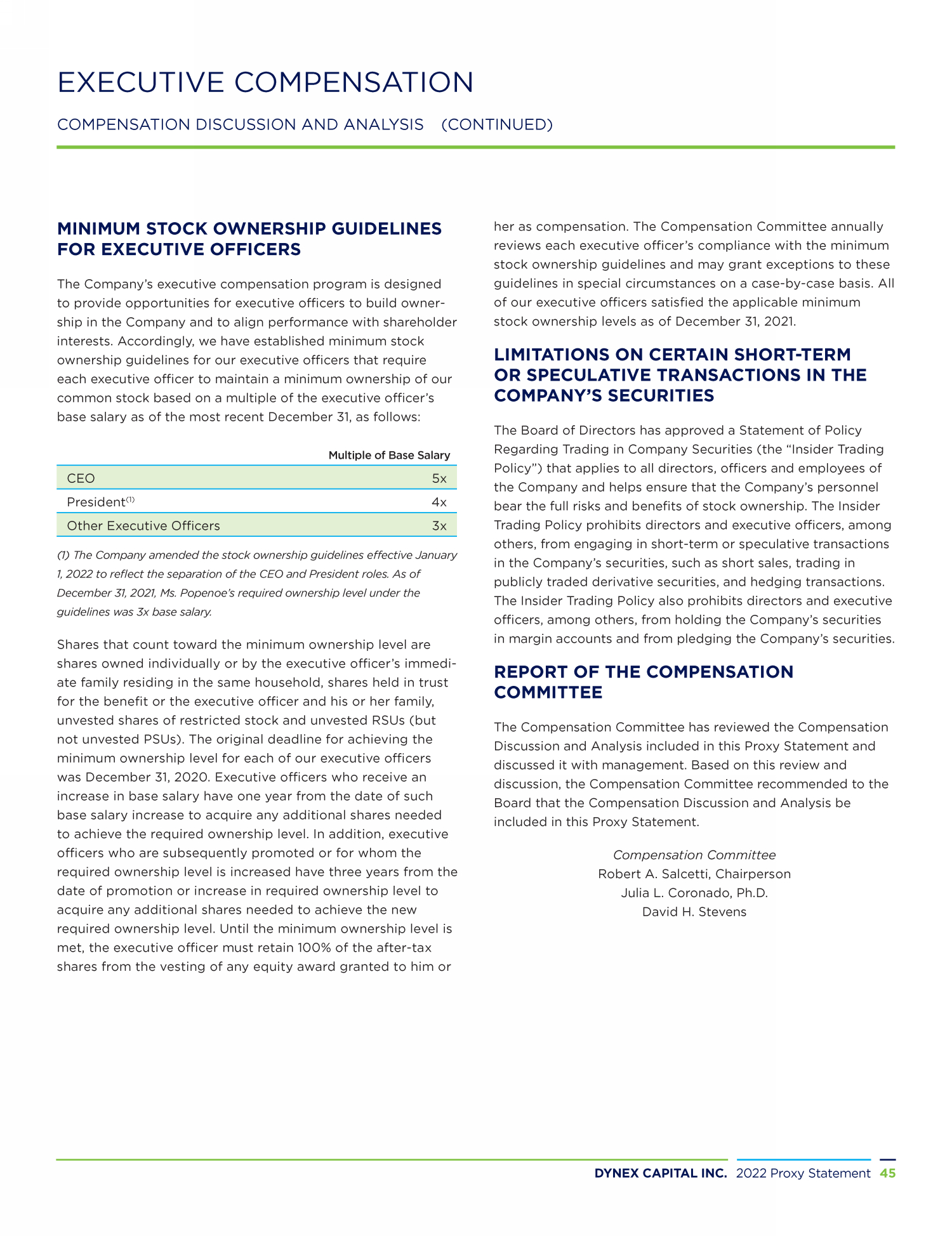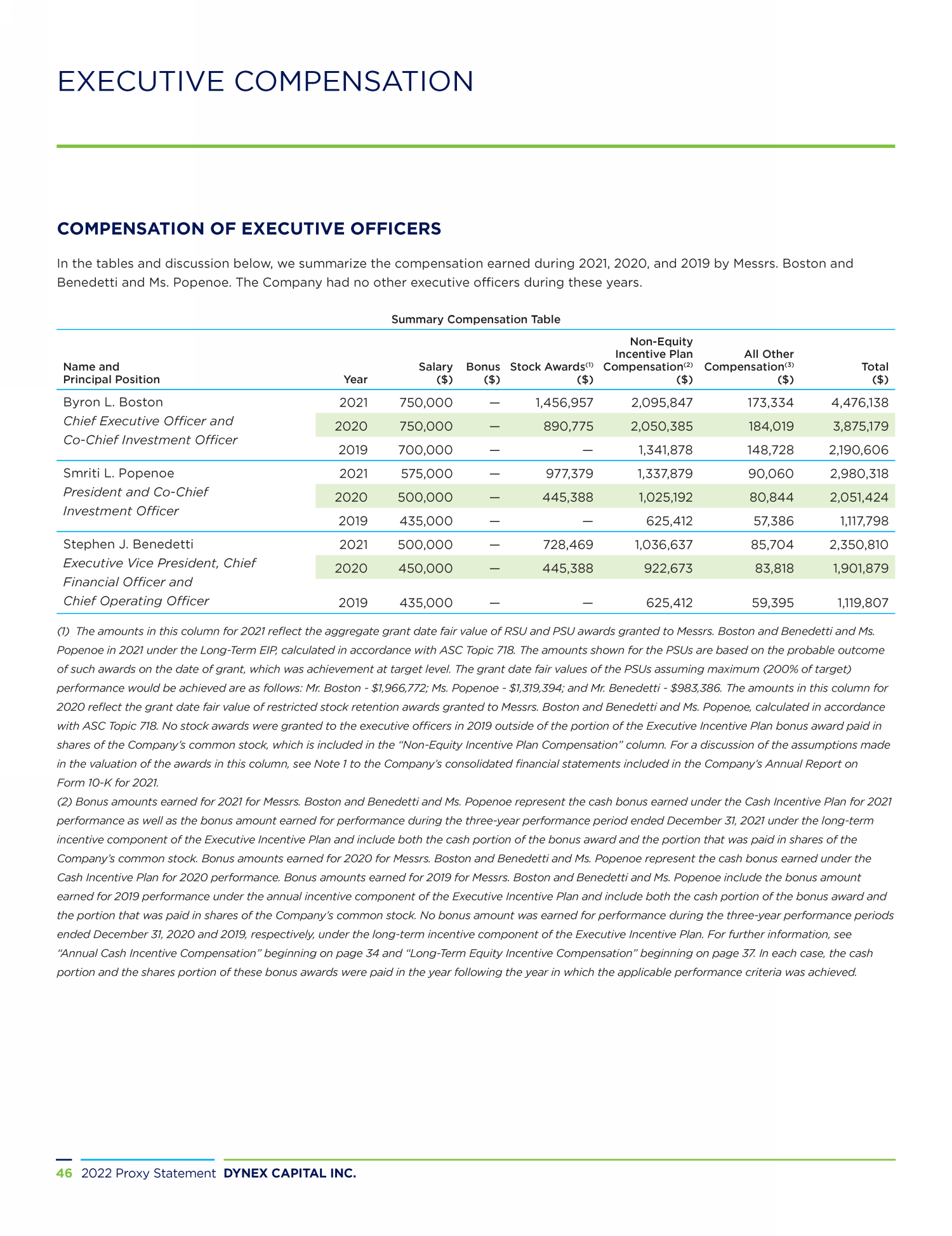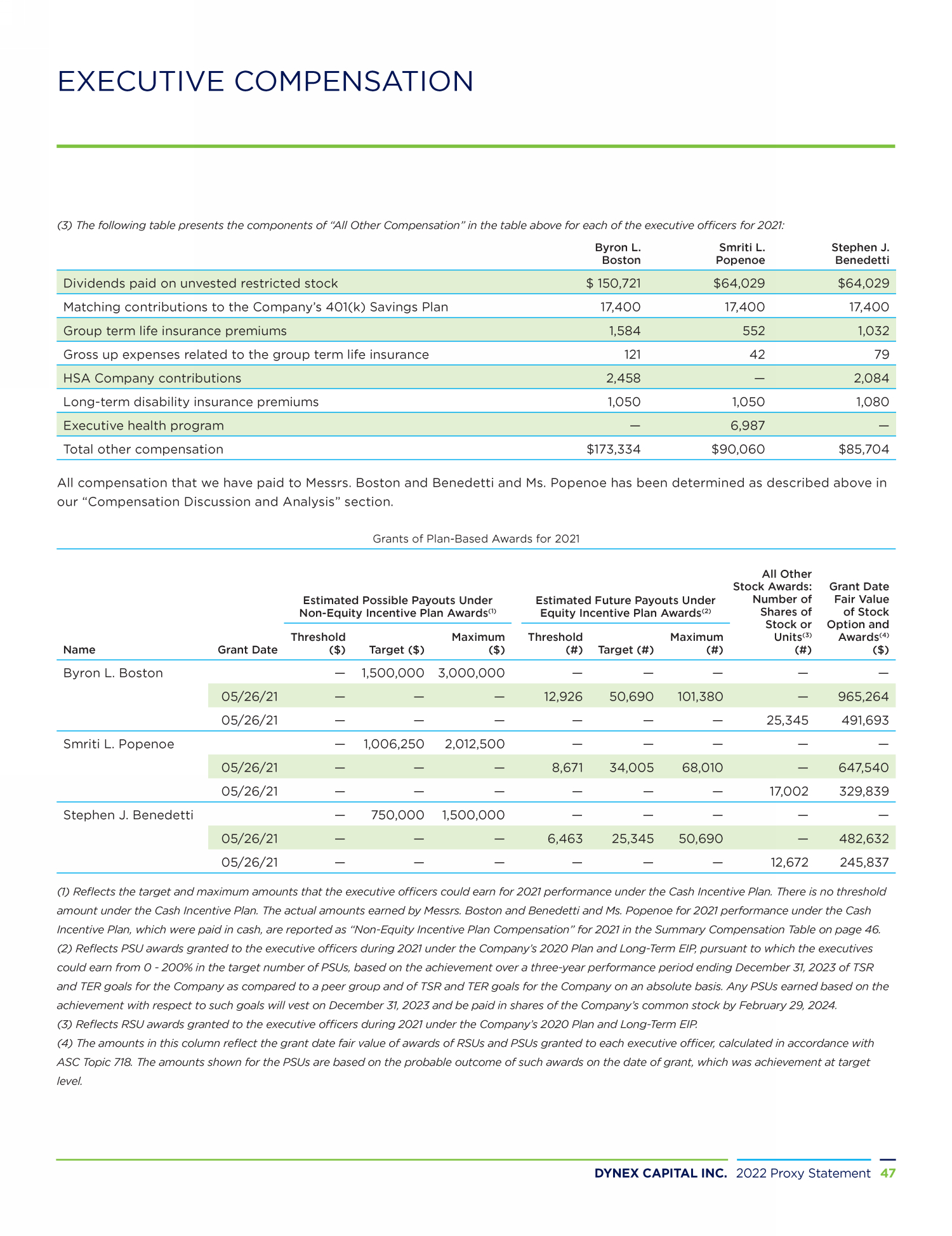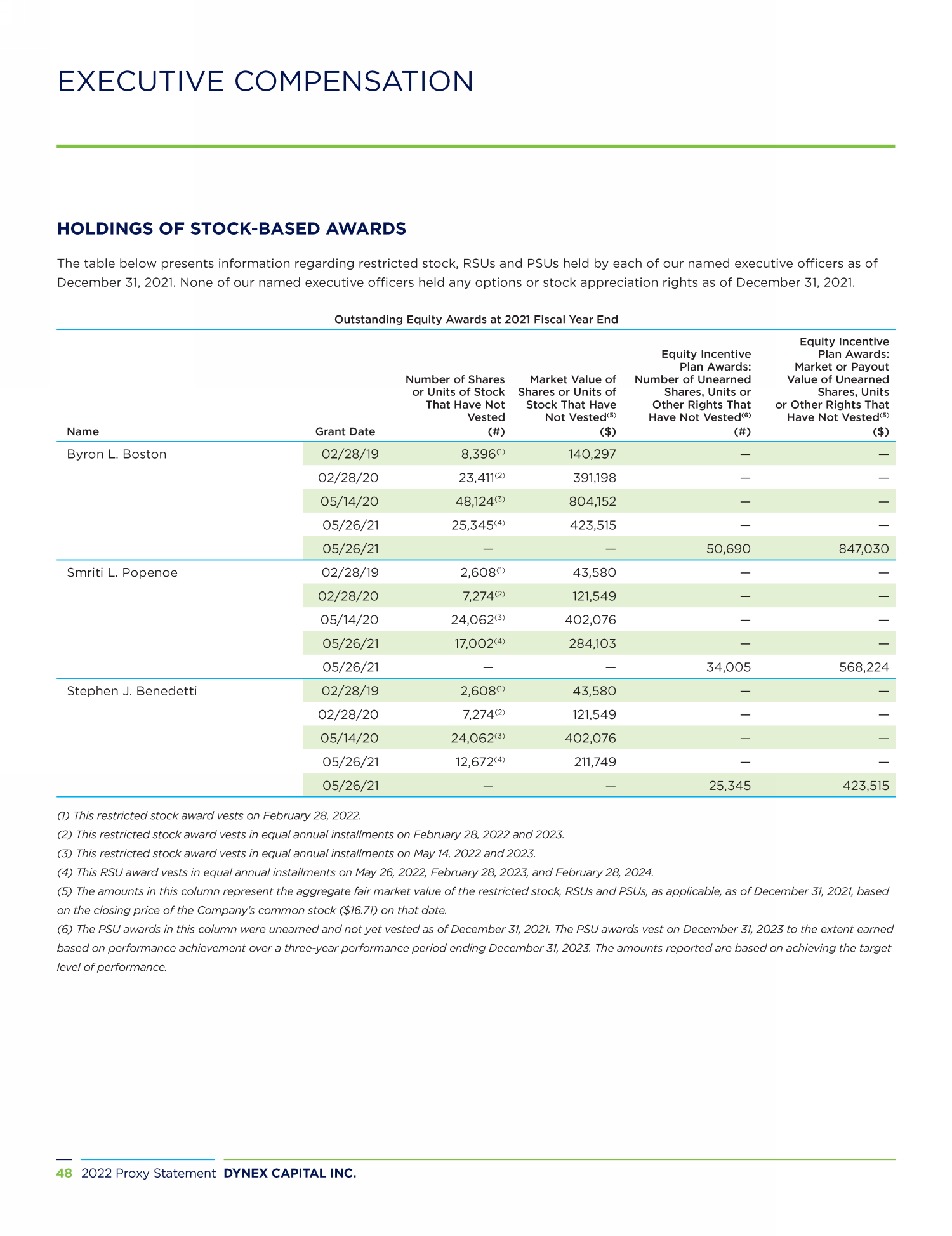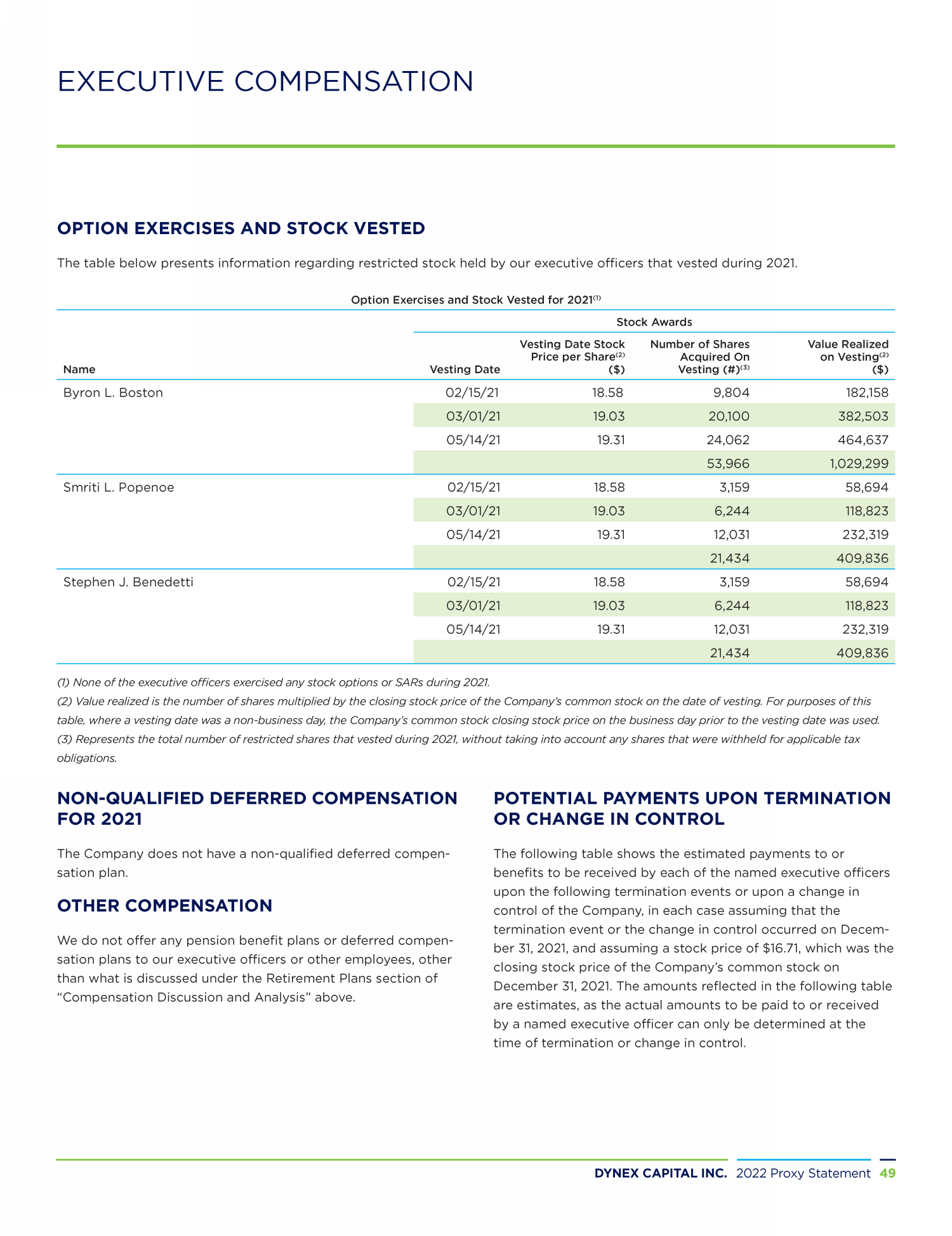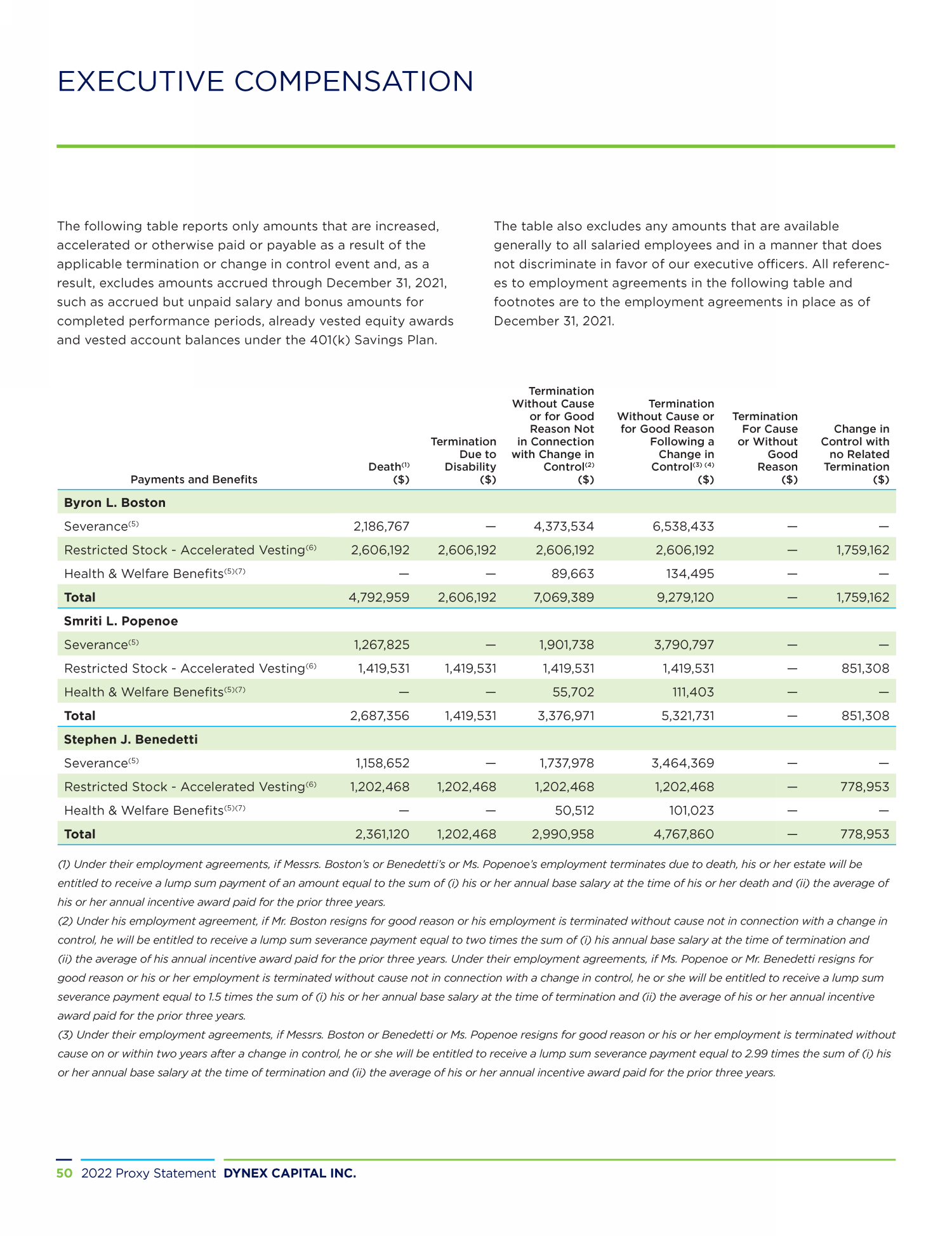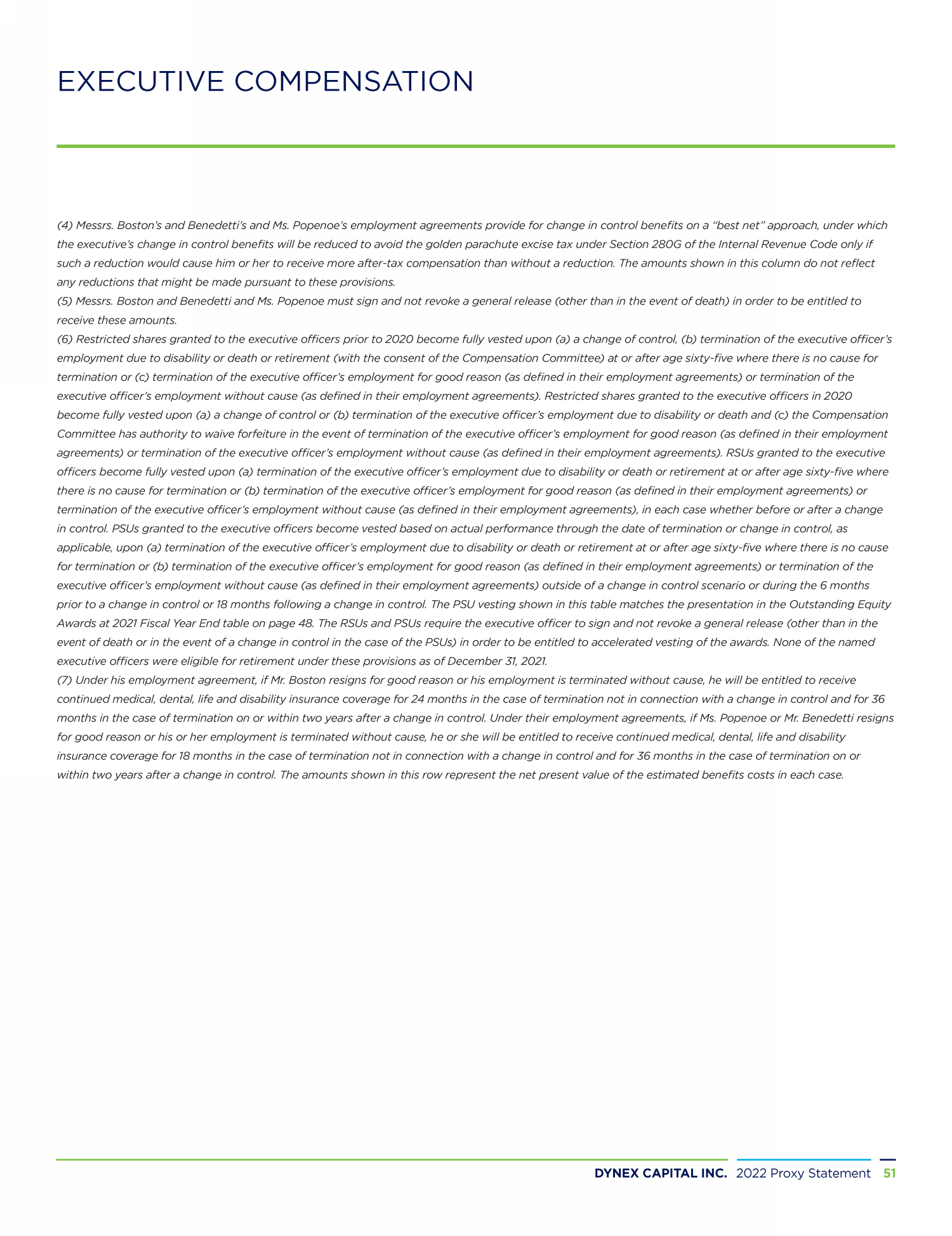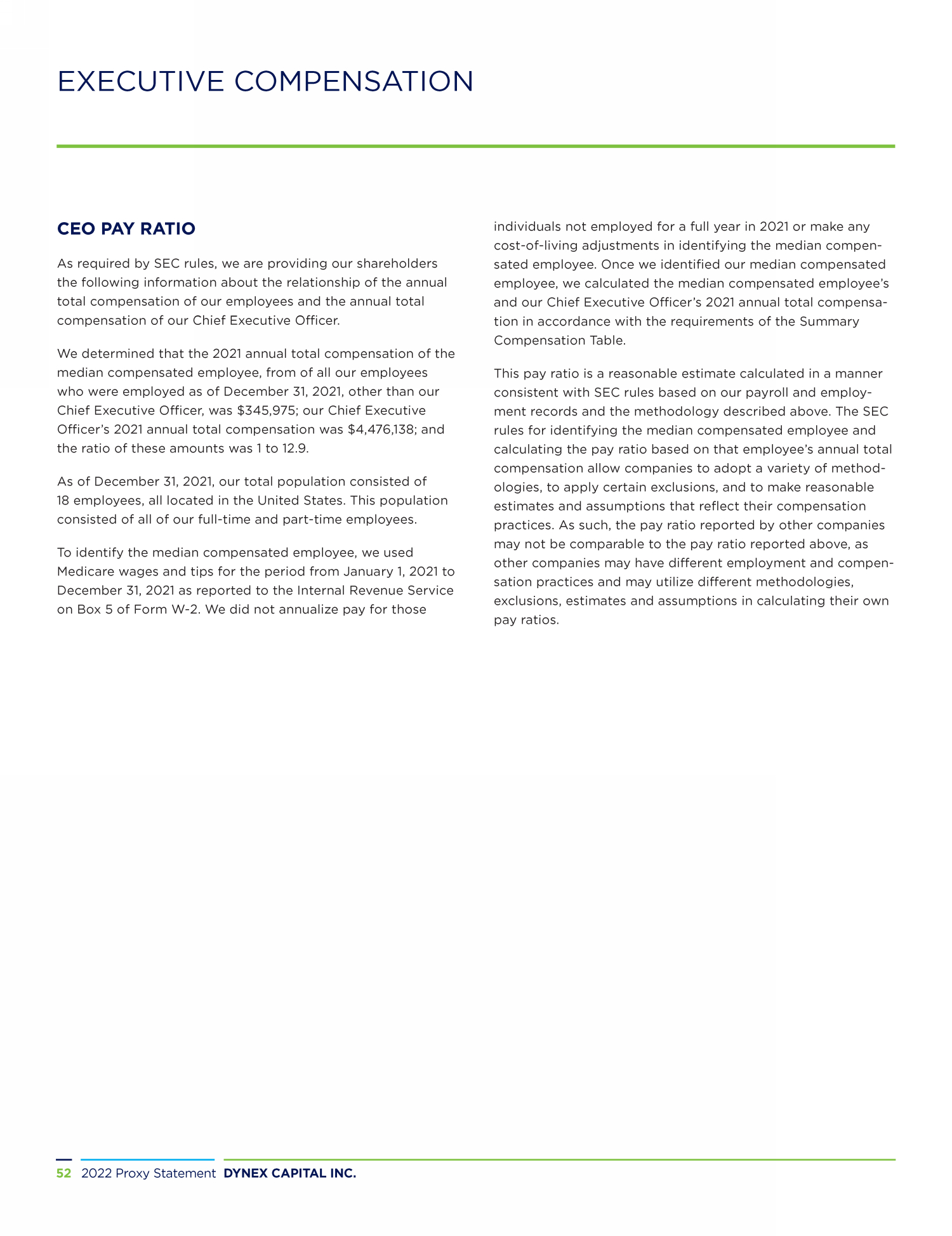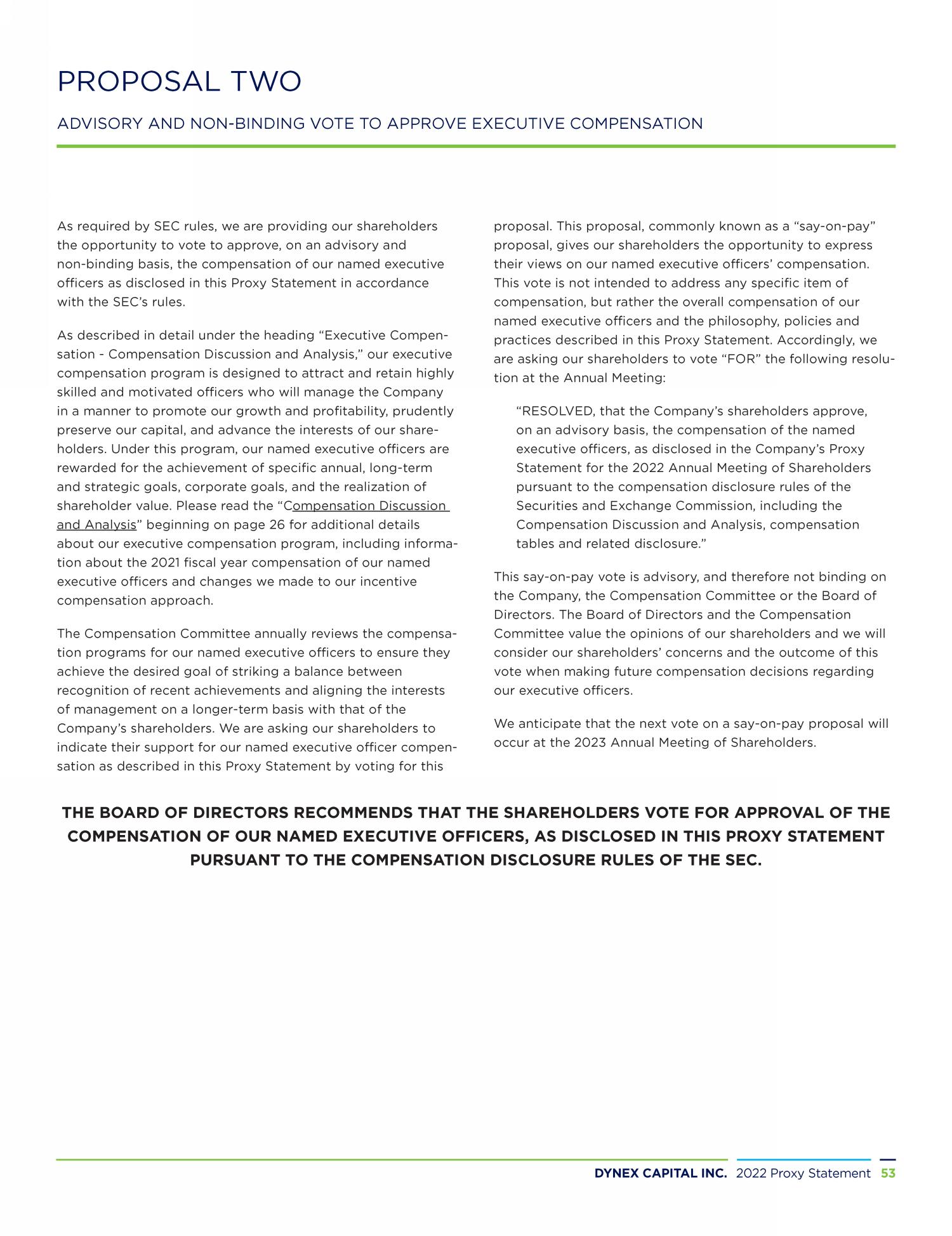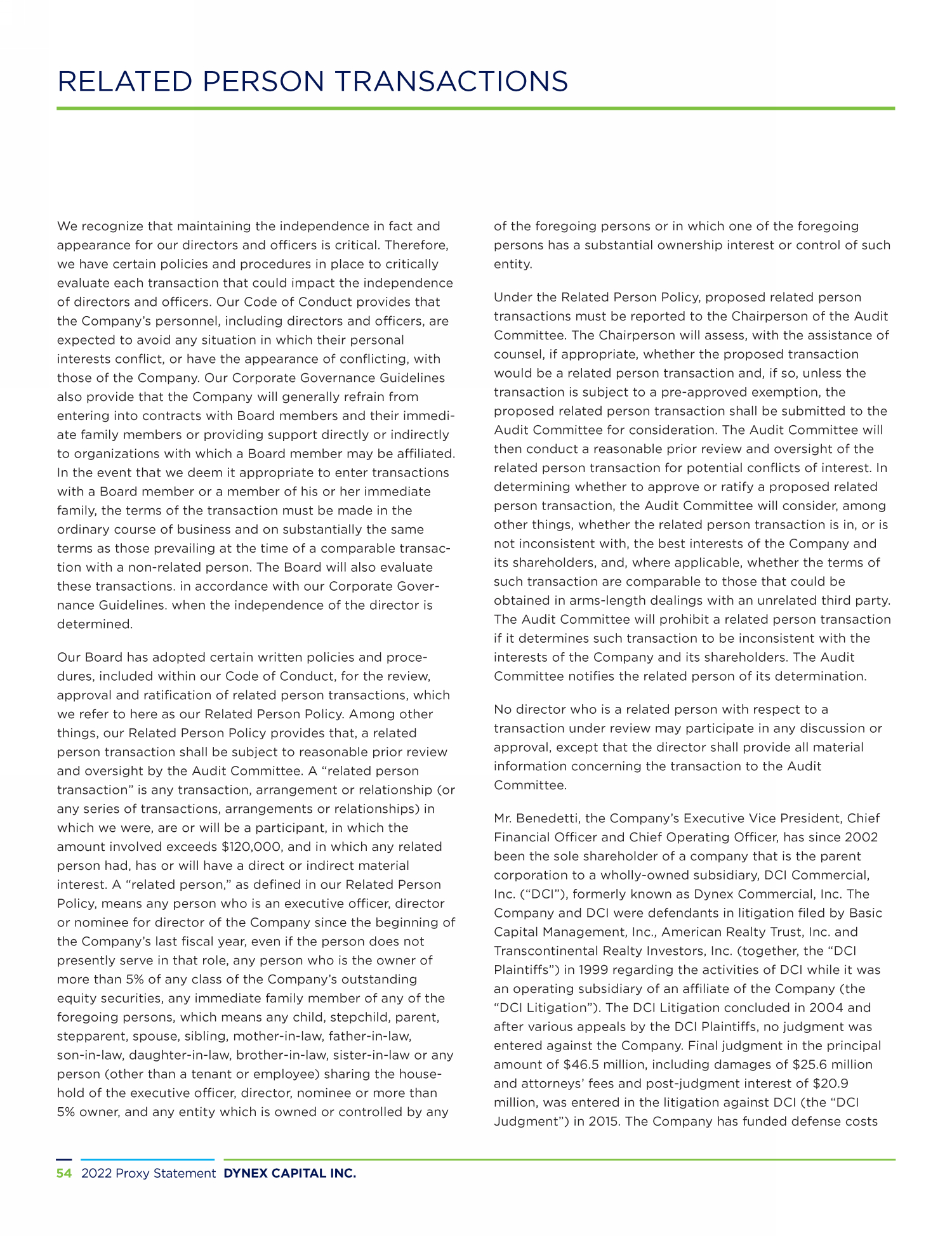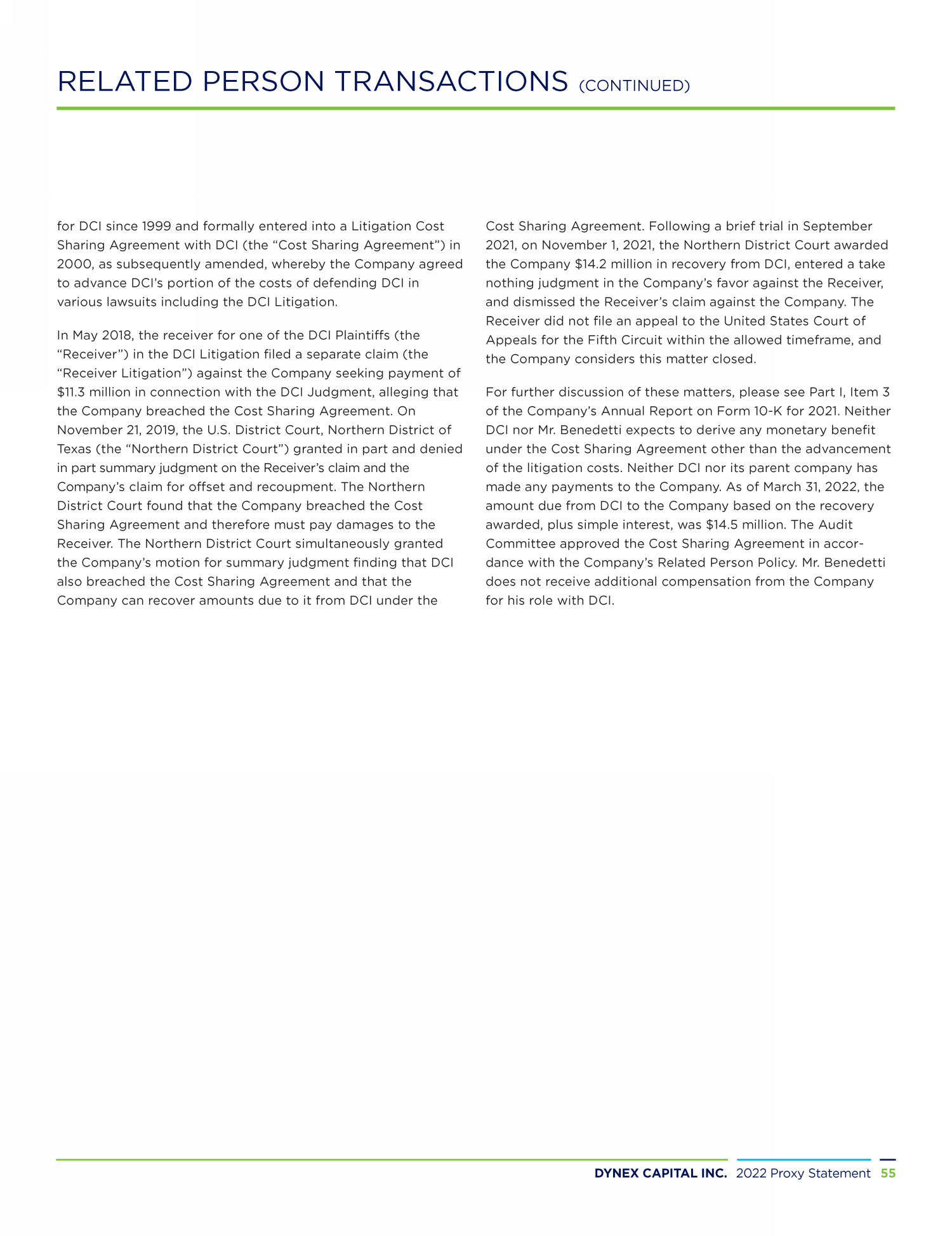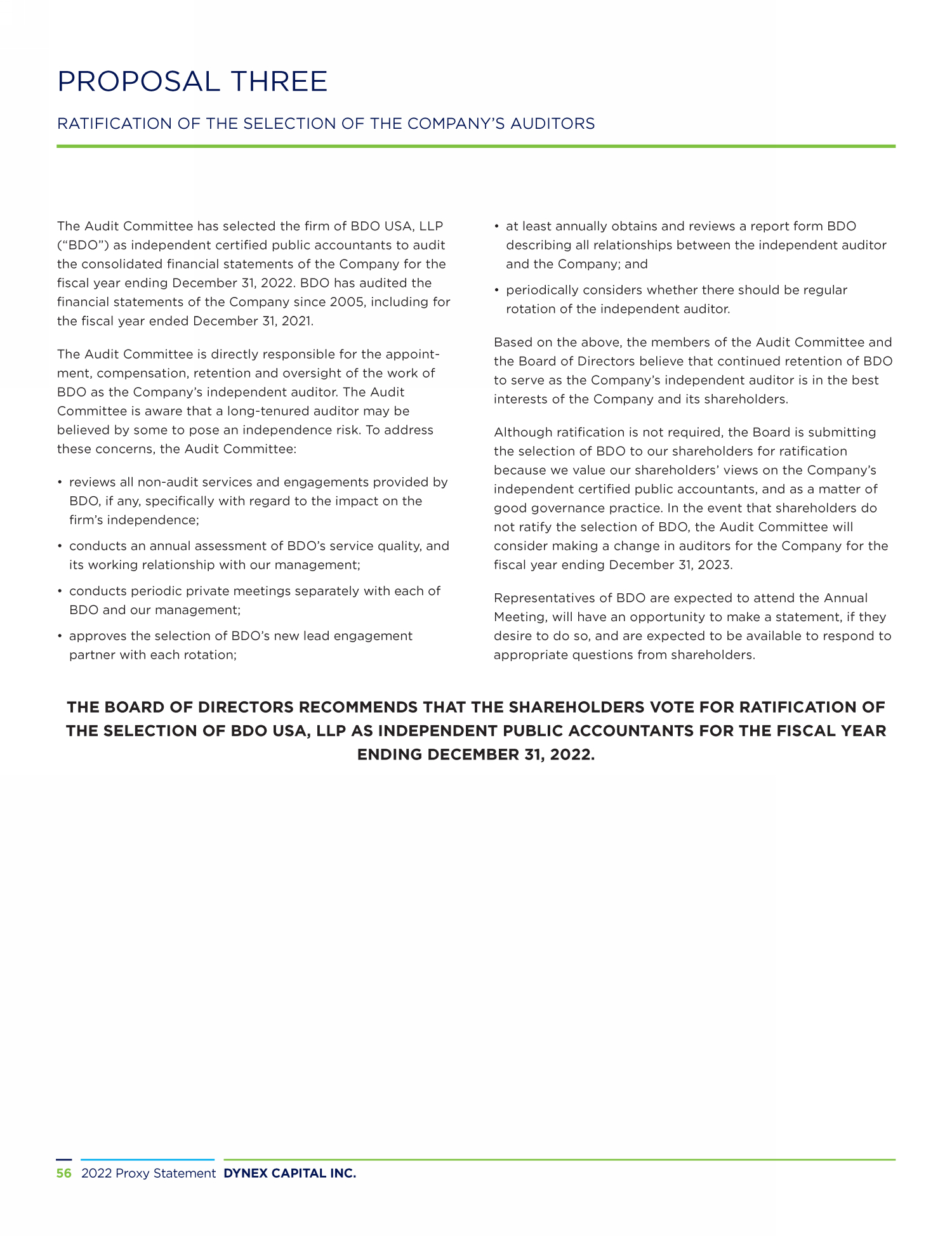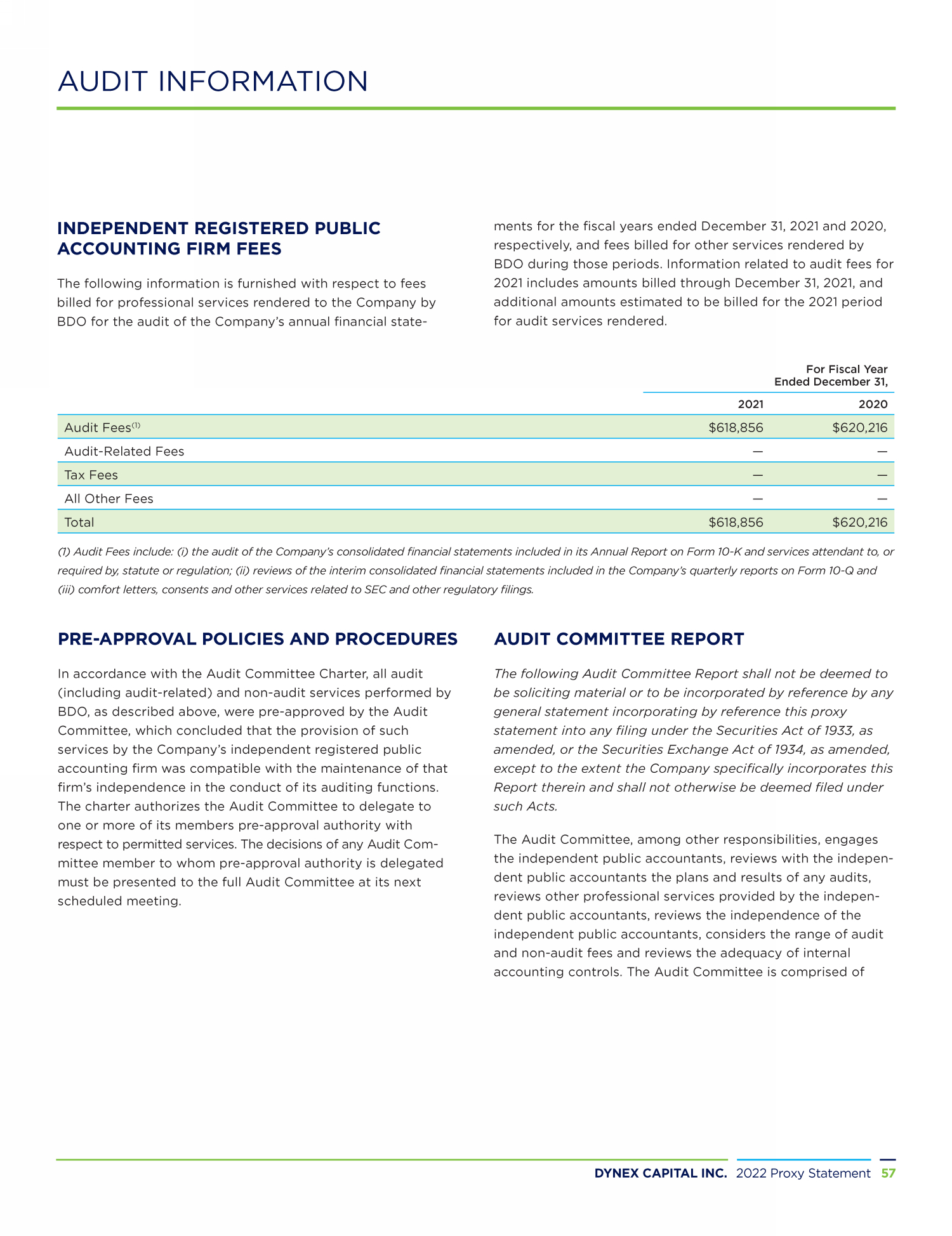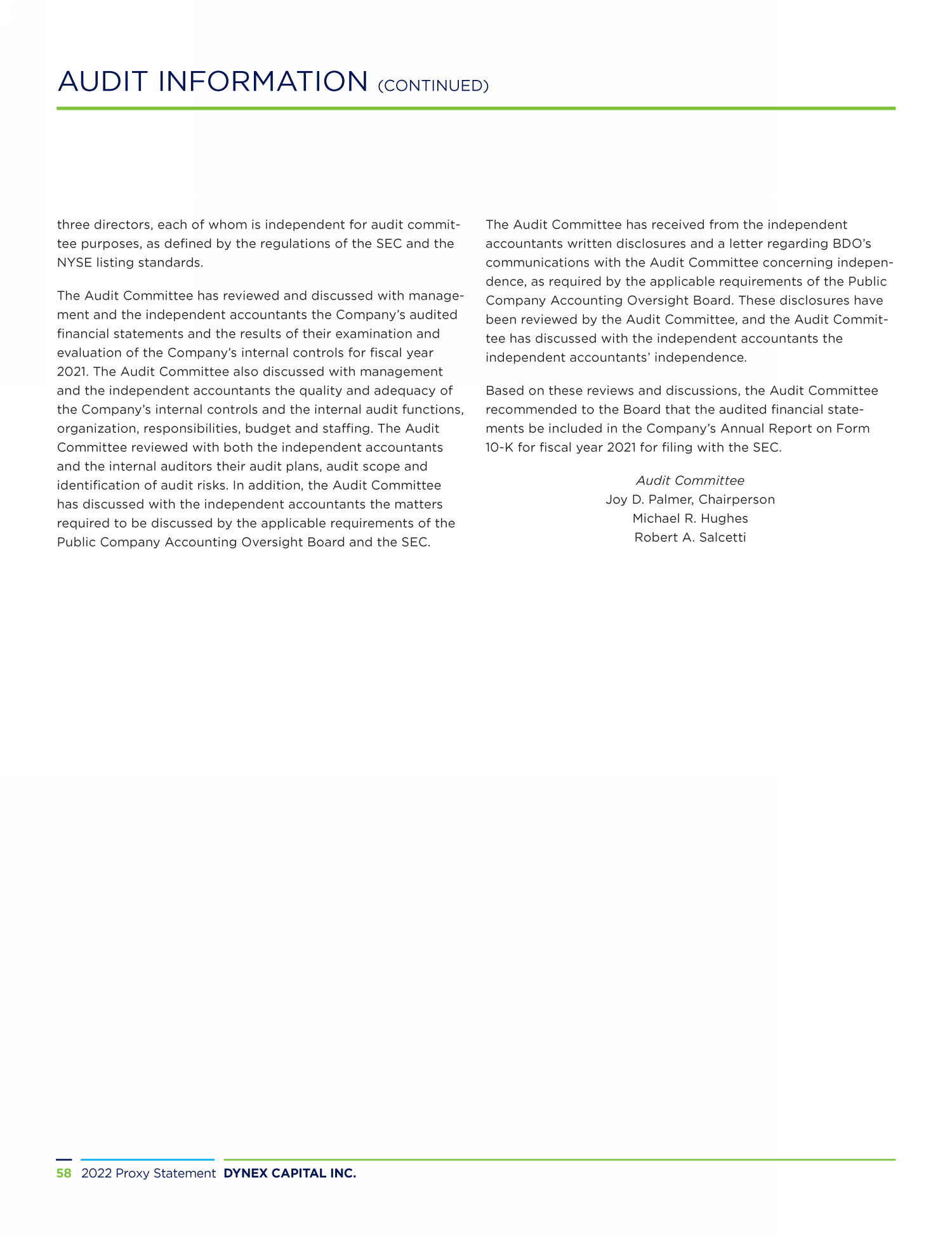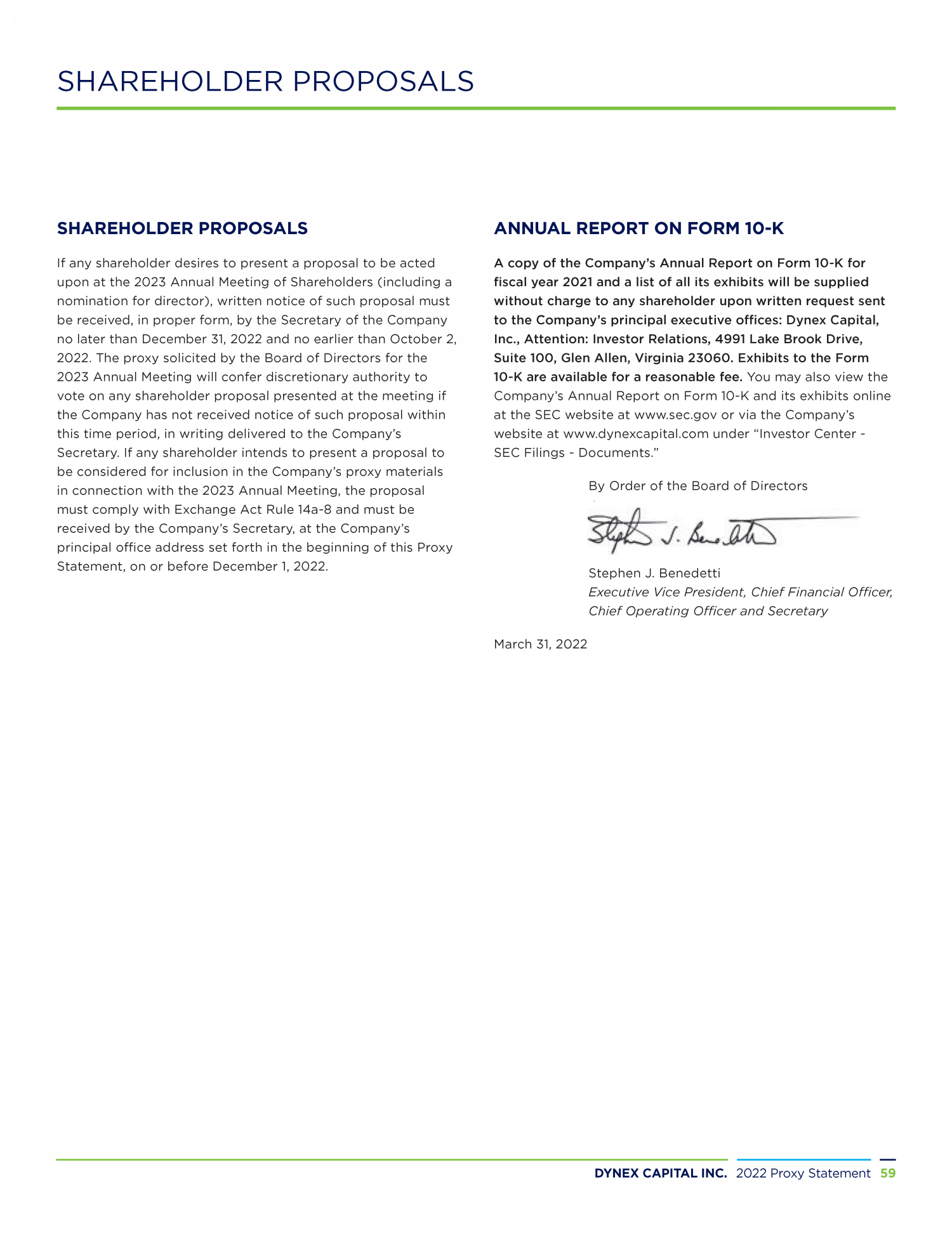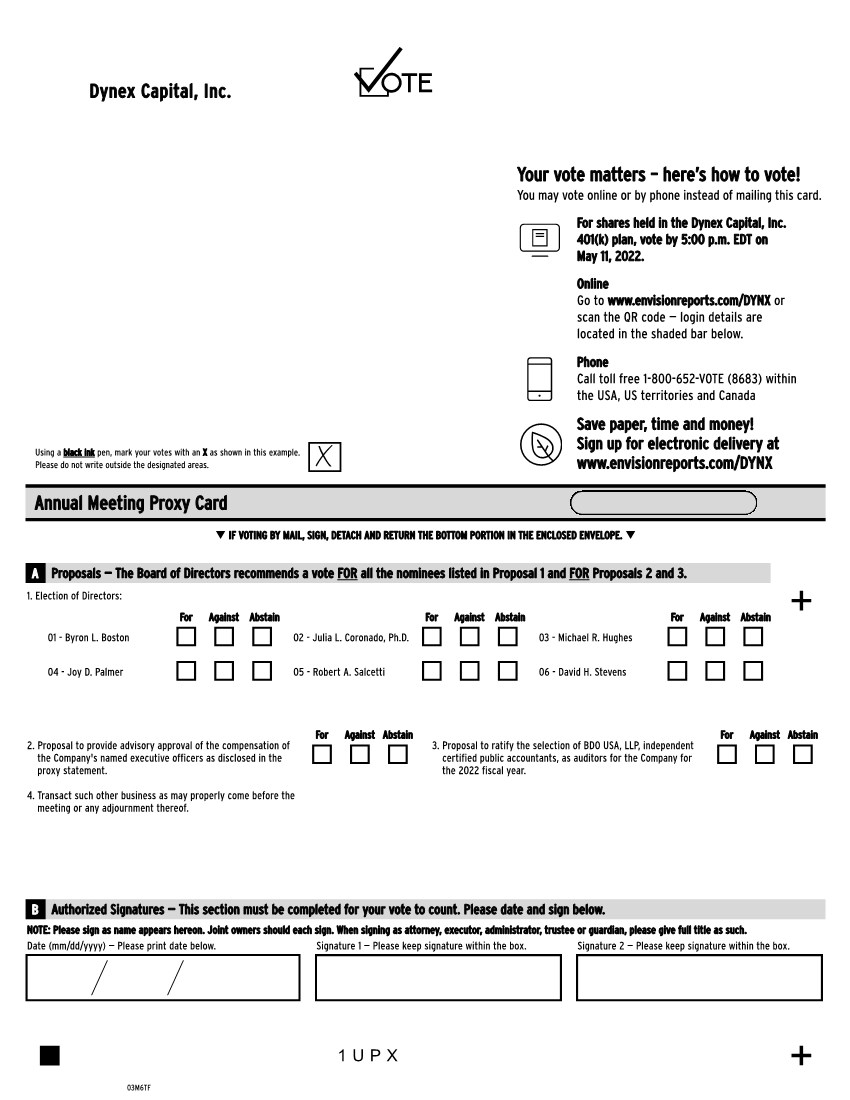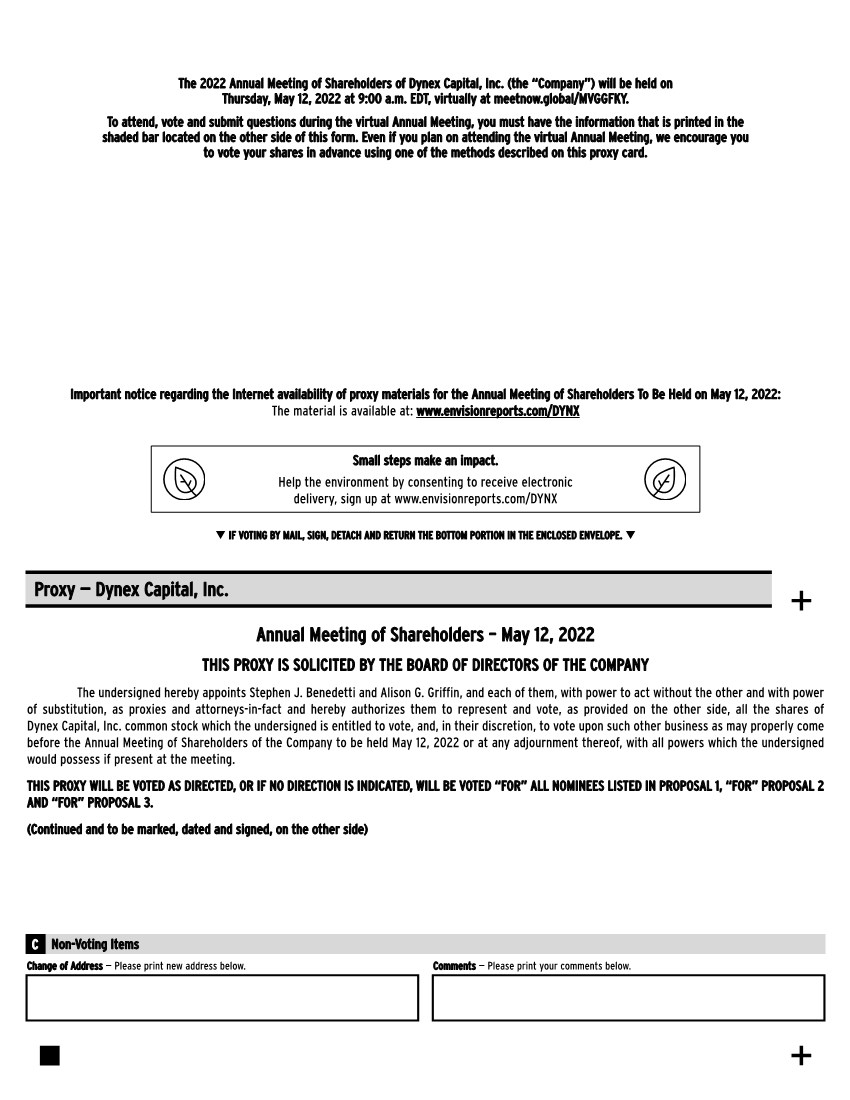DEF 14A: Definitive proxy statements
Published on March 31, 2022
UNITED STATES
SECURITIES AND EXCHANGE COMMISSION
Washington, D.C. 20549
SCHEDULE 14A
Proxy Statement Pursuant to Section 14(a) of
the Securities Exchange Act of 1934 (Amendment No. )
Filed by the Registrant x
Filed by a Party other than the Registrant ¨
Check the appropriate box:
¨ Preliminary Proxy Statement
¨ Confidential, for Use of the Commission Only (as permitted by Rule 14a-6(e)(2))
x Definitive Proxy Statement
¨ Definitive Additional Materials
¨ Soliciting Material under §240.14a-12
| Dynex Capital Inc | ||
| (Name of Registrant as Specified in Its Charter) | ||
| (Name of Person(s) Filing Proxy Statement, if other than the Registrant) |
Payment of Filing Fee (Check the appropriate box):
x No fee required.
¨ Fee paid previously with preliminary materials.
¨ Fee computed on table in exhibit required by Item 25(b) per Exchange Act Rules 14a6(i)(1) and 0-11.
|
NOTICE OF ANNUAL MEETING OF SHAREHOLDERS AND PROXY STATEMENT Annual Meeting of Shareholders May 12, 2022 2022 |
|
LETTER TO SHAREHOLDERS You are cordially invited to attend the Annual Meeting of Share- holders of Dynex Capital, Inc. (the “Company”) on Thursday, May 12, 2022 beginning at 9:00 a.m. Eastern Daylight Time. As with last year’s annual meeting, we will use a virtual meeting format, which means that you may attend virtually by accessing https://meetnow. global/MVGGFKY. We believe that this format facilitates expanded shareholder access and participation. Additionally, due to the ongoing public health concerns associated with the COVID-19 pandemic, we believe that using a virtual meeting format again this year will help protect the health, safety and well-being of our employees, directors, shareholders and the community at large, which continues to be our priority. The business of the meeting is to consider and act upon the election of directors; to approve, in an advisory and non-binding vote, the compensation of our named executive officers; and to ratify the selection of the auditors of the Company. As permitted by rules adopted by the Securities and Exchange Commission (the “SEC”), we are furnishing our proxy statement and 2021 Annual Report to Shareholders over the Internet to most of our shareholders. This means that most of our shareholders will initially receive only a notice containing instructions on how to access the proxy materials over the Internet. This approach lowers the cost of delivering the annual meeting materials and reduces the environmental impact of the meeting. If you would like to receive a paper copy of the proxy materials, the notice contains instructions on how you can request copies of these documents. Whether or not you plan to attend the meeting, your vote is important, and we encourage you to vote promptly. You may vote your shares via a toll-free telephone number or over the Internet. If you receive your proxy materials by mail, you may instead sign, date and mail the proxy card in the postage-paid envelope provided. Instructions regarding all three methods of voting are contained in the proxy card. If you mail the proxy card and desire to vote your shares of common stock in accordance with manage- ment’s recommendations, you need not mark your votes on the proxy but need only sign, date and return the proxy card in the envelope provided in order to record your vote. Sincerely, Michael R. Hughes Chairperson of the Board TO OUR COMMON SHAREHOLDERS: March 31, 2022 DYNEX CAPITAL INC. 2022 Proxy Statement |
|
NOTICE OF ANNUAL MEETING OF SHAREHOLDERS The Annual Meeting will be a virtual meeting, which means that shareholders may attend virtually by accessing https:// meetnow.global/MVGGFKY. Shareholders will be able to listen, vote and submit questions during the Annual Meeting online. There will be no physical location for shareholders to attend the Annual Meeting. Only shareholders of record of our common stock at the close of business on March 7, 2022, the record date, will be entitled to vote at the Annual Meeting. Management desires to have maximum representation at the Annual Meeting. Whether or not you plan to attend the meeting, we urge you to vote your shares via the toll-free telephone number or over the Internet, as described in the accompanying Proxy Statement. If you receive these materials by mail, you may instead sign, date and mail the proxy card in the postage-paid envelope provided. A proxy may be revoked by a shareholder prior to its use by notice in writing to the Secretary of the Company, by submitting a later-dated proxy to the Secretary of the Company, by changing your vote via the toll-free telephone number or over the Internet or by attending and voting during the Annual Meeting (provided that, if you hold your shares through a bank, broker or other holder of record and you wish to vote during the Annual Meeting, you must register prior to the Annual Meeting, as described in the Proxy Statement). By Order of the Board of Directors Stephen J. Benedetti Executive Vice President, Chief Financial Officer, Chief Operating Officer and Secretary Dated: March 31, 2022 WHEN: WHERE: RECORD DATE: Thursday, May 12, 2022 9:00 a.m. Eastern Daylight Time The Annual Meeting will be a virtual meeting which means that shareholders may attend virtually by accessing https://meetnow.global/ MVGGFKY Shareholders of record at the close of business on Monday, March 7, 2022 are entitled to vote. 4991 Lake Brook Drive, Suite 100 Glen Allen, Virginia 23060 (804) 217-5800 1 2 3 4 ITEMS OF BUSINESS To elect six (6) directors of the Company, to hold office until the next annual meeting and until their successors are elected and duly qualified; To approve, in an advisory and non-binding vote, the compensation of the Company’s named executive officers as disclosed in the accompanying Proxy Statement; To ratify the selection of BDO USA, LLP, independent certified public accountants, as auditors for the Company for the 2022 fiscal year; and To transact such other business as may properly come before the meeting or any adjournment thereof. For each director 5 53 56 Proposal Board Recommendation See Page TO OUR COMMON SHAREHOLDERS: 2022 Proxy Statement DYNEX CAPITAL INC. |
PROXY STATEMENT
TABLE OF CONTENTS
| DYNEX CAPITAL INC. | 2022 Proxy Statement |
|
2022 Proxy Statement DYNEX CAPITAL INC. (Intentionally Left Blank) |
|
PROXY STATEMENT ANNUAL MEETING OF SHAREHOLDERS To be held on May 12, 2022 TO OUR COMMON SHAREHOLDERS: This Proxy Statement is furnished to the holders of the common stock of Dynex Capital, Inc. (the “Company”) in connection with the solicitation by the Company’s Board of Directors (the “Board”) of proxies to be used at the Annual Meeting of Shareholders of the Company to be held virtually on Thursday, May 12, 2022, at 9:00 a.m. Eastern Daylight Time (the “Annual Meeting”). Shareholders may attend the Annual Meeting by accessing https://meetnow.global/MVGGFKY and following the instructions in the beginning of this Proxy Statement. Share- holders will be able to listen, vote and submit questions during the Annual Meeting online. There will be no physical location for shareholders to attend the Annual Meeting. The Annual Meeting is being held for the purposes set forth in the accompanying Notice of Annual Meeting of Shareholders. As permitted by rules adopted by the SEC, the Company is making this Proxy Statement and its 2021 Annual Report to Shareholders available to most of our shareholders electronical- ly over the Internet. On March 31, 2022, we commenced mailing to our shareholders a Notice of Internet Availability of Proxy Materials containing instructions on how to access this Proxy Statement and our Annual Report and vote over the Internet. Most shareholders will not receive a printed copy of the proxy materials in the mail, unless specifically requested. Instead, the Notice of Internet Availability of Proxy Materials instructs you on how to access and review over the Internet all of the important information contained in the Proxy Statement and Annual Report and on how you may submit your proxy over the Internet. If you would like to receive a printed copy of our proxy materials, you should follow the instructions for requesting such materials included in the Notice of Internet Availability of Proxy Materials. Important Notice Regarding the Availability of Proxy Materials for the Shareholder Meeting to Be Held on Thursday, May 12, 2022 The Proxy Statement and 2021 Annual Report to Shareholders are available online by visiting www.envisionreports.com/DYNX. 4991 Lake Brook Drive, Suite 100 Glen Allen, Virginia 23060 (804) 217-5800 DYNEX CAPITAL INC. 2022 Proxy Statement 1 |
|
2 2022 Proxy Statement DYNEX CAPITAL INC. GENERAL INFORMATION ATTENDING THE ANNUAL MEETING The Board believes that a virtual meeting format will provide the opportunity for full and equal participation by all sharehold- ers, from any location around the world, while also helping to protect the health, safety and well-being of our shareholders, directors, employees, and the community at large during the ongoing COVID-19 pandemic. A virtual meeting also substan- tially reduces the costs associated with hosting an in-person meeting. The Company has considered concerns raised by investor advisory groups and other shareholder rights advocates that virtual meetings may diminish shareholder voice or reduce accountability. Accordingly, we have sought to design our virtual meeting format to enhance, rather than constrain, shareholder access, participation and communication. Share- holders will be able to listen, vote and submit questions online during the Annual Meeting. The Company believes its virtual Annual Meeting will afford a greater number of our sharehold- ers the opportunity to attend the Annual Meeting while affording shareholders the same rights they would have had at an in-person meeting. If you plan to attend the virtual Annual Meeting, please follow the instructions in the following Questions and Answers: Q: How can I attend the Annual Meeting? A: The Annual Meeting will be a virtual meeting of sharehold- ers, which means that you may attend the meeting by accessing https://meetnow.global/MVGGFKY. There will be no physical location for shareholders to attend the Annual Meeting. You are entitled to attend, vote and submit questions prior to and during the Annual Meeting if you were a shareholder of the Company as of the close of business on March 7, 2022, the record date, or if you hold a valid proxy for the Annual Meeting. Guests may join the Annual Meeting in a listen-only mode. The Annual Meeting will begin promptly at 9:00 a.m. Eastern Daylight Time. We encourage you to access the meeting prior to the start time to leave ample time to log into the meeting and test your computer audio system. You should ensure that you have a strong Internet connection to support your virtual attendance at the Annual Meeting. Please follow the instructions as outlined below. Q: Do I need to register to attend the Annual Meeting? A: Registered Shareholders. If you are a registered sharehold- er (i.e., you hold your shares through our transfer agent, Computershare), then you do not need to register to attend the Annual Meeting. To attend the meeting, visit the Annual Meeting website at https://meetnow.global/MVGGFKY to log-in on the day of the meeting and enter your 15-digit control number located on your Notice of Internet Availability of Proxy Materials or proxy card. Beneficial Shareholders. If your shares are held in “street name” (i.e., you hold your shares through an intermediary, such as a bank or broker), then you must register in advance to attend the Annual Meeting. To register to attend the Annual Meeting you must submit proof of your proxy power (such as a legal proxy or broker’s proxy card) reflecting your common stock holdings, along with your name and email address to Computershare. Requests for registration should be directed to Computer- share by email to legalproxy@computershare.com (forward- ing the email from your broker, or attaching an image of your legal proxy) or by mail to: Computershare Dynex Capital, Inc. Legal Proxy P.O. Box 43001 Providence, RI 02940-3001 Requests for registration must be labeled as “Legal Proxy” and be received on or before May 2, 2022. You will receive a confirmation of your registration by email (or by mail, if no email address is provided) after Computer- share receives your registration materials. To attend the meeting, visit the Annual Meeting website at https://meetnow.global/MVGGFKY to log in on the day of the meeting and enter the 15-digit control number provided in the confirmation sent by Computershare. Q: How do I ask questions during the Annual Meeting? A: Shareholders of record may submit questions prior to or during the Annual Meeting by visiting https://meetnow. global/MVGGFKY and entering your 15-digit control number located on your Notice of Internet Availability of Proxy Materials or proxy card, and then following the instructions to submit a question. Questions submitted in advance of and during the meeting that are pertinent to meeting matters will be answered during the meeting, subject to time limitations. Substantial- ly similar questions will be answered once to avoid repeti- tion and allow for more time for other questions. If there are pertinent questions submitted that cannot be answered during the meeting due to time limitations, management will post answers to a representative set of such questions (after consolidating repetitive questions) to our website at www.dynexcapital.com under “Investor Center – Proxy Materials.” |
|
DYNEX CAPITAL INC. 2022 Proxy Statement 3 Q: What if I have trouble accessing the Annual Meeting? A: If you have difficulties logging into the Annual Meeting, you can use the technical resources available on the log-in page at https://meetnow.global/MVGGFKY, which will be available beginning at 8:30 a.m. Eastern Daylight Time on May 12, 2022 or contact 1-888-724-2416 for further assistance. If there are any technical issues in convening or hosting the Annual Meeting, we will promptly post information to our website at www.dynexcapital.com under “Investor Center – Proxy Materials,” including information on when the meeting will be reconvened. SOLICITATION You have received these proxy materials because the Board is soliciting your proxy to vote your shares at the Annual Meeting. The costs of this solicitation will be borne by the Company. Proxy solicitations will be made by the Internet and mail, and also may be made by personal interview, telephone and e-mail by directors and officers of the Company, acting without compensation other than their regular compensation. Brokerage houses and nominees will be requested to forward the proxy soliciting material to the beneficial owners of shares of common stock and to obtain authorization for the execution of proxies. The Company will, upon request, reimburse such parties for their reasonable expenses in forwarding these proxy materials to such beneficial owners. VOTING RIGHTS Our common stock is the Company’s only class of capital stock entitled to vote at the Annual Meeting. Holders of shares of common stock at the close of business on March 7, 2022, the record date, are entitled to notice of, and to vote at, the Annual Meeting. On that date, 36,665,805 shares of common stock were outstanding, with each outstanding share of common stock entitled to one vote for each of the six directors nominat- ed and one vote on each other matter presented at the Annual Meeting. QUORUM AND BROKER NON-VOTES The presence of a majority of the outstanding shares of common stock entitled to vote, in person or by proxy, will constitute a quorum for all matters presented at the Annual Meeting. Shares represented in person or by proxy at the Annual Meeting, includ- ing shares represented by proxies that reflect abstentions, will be counted as present in the determination of a quorum. Virtual attendance at the Annual Meeting constitutes presence “in person” for purposes of a quorum at the meeting. “Broker non-votes” (which are shares held by brokers or nominees as to which (i) instructions have not been received from the beneficial owner or the persons entitled to vote the shares, and (ii) the broker does not have discretionary voting power on a particular matter) will be treated in the same manner as absten- tions for purposes of a quorum. The election of directors and the advisory vote to approve the compensation of the Company’s named executive officers are not considered routine matters and, therefore, brokers do not have discretionary voting power with respect to these proposals. The ratification of the selection of BDO USA, LLP as the Company’s auditors for the 2022 fiscal year is considered a routine matter and, therefore, brokers do have discretionary voting power with respect to this proposal. VOTE REQUIRED Under the Company’s “majority vote” standard for uncontested director elections, with respect to each nominee, votes may be cast for or against, or you may abstain from voting. If a quorum is present, in order for a nominee to be elected in an uncontest- ed election, the votes cast for such nominee’s election must exceed the votes cast against such nominee’s election. Absten- tions or broker non-votes will not count as votes cast and will have no effect on the outcome of the election. If a nominee who is an incumbent director is not elected to the Board, he or she must offer his or her resignation promptly to the Board of Directors, which will then determine whether to accept or reject the offered resignation, or whether to take other action. The Company maintains a “plurality vote” standard in contested director elections (where the number of nominees exceeds the number of directors to be elected). For the advisory vote to approve the compensation of the Company’s named executive officers and the ratification of the selection of BDO USA, LLP as the Company’s auditors for the 2022 fiscal year, votes may be cast for or against, or you may abstain from voting. For these proposals, if a quorum is present, approval of the proposal requires that the number of votes cast for the proposal by holders entitled to vote exceeds the number of votes cast against the proposal. Abstentions or broker non-votes will not count as votes cast and will have no effect on the outcome of these proposals. INFORMATION ABOUT VOTING You will receive multiple Notices of Internet Availability of Proxy Materials or printed copies of the proxy materials if you hold your shares in different ways (e.g., joint tenancy, trusts, custodi- al accounts, etc.) or in multiple accounts. You should vote the shares represented by each Notice of Internet Availability of Proxy Materials and proxy card you receive to ensure that all of your shares are voted. Shareholders of record can vote during the Annual Meeting or by proxy. There are three ways for shareholders of record to vote by proxy: • By Telephone - you can vote by telephone toll-free by following the instructions on the proxy card (you will need the 15-digit control number on your Notice of Internet Availability of Proxy Materials or proxy card); • By Internet - you can vote over the Internet by following the instructions on the Notice of Internet Availability of Proxy Materials or proxy card (you will need the 15-digit control number on your Notice of Internet Availability of Proxy Materials or proxy card); or |
|
4 2022 Proxy Statement DYNEX CAPITAL INC. • By Mail - if you received these proxy materials by mail, you can vote by mail by signing, dating and mailing the proxy card in the postage-paid envelope provided. If you hold shares in the Dynex Capital, Inc. 401(k) Plan, your voting instructions for those shares must be received by 5:00 p.m. Eastern Daylight Time on May 11, 2022 to allow sufficient time for voting by the trustee of the plan. If you hold your shares through an intermediary, such as a bank or broker, you will receive voting instructions from the holder of record and you must register in advance to attend the Annual Meeting. REVOCABILITY OF PROXY If you are a shareholder of record, you may change or revoke your proxy at any time before your shares are voted at the Annual Meeting, by any of the following methods: • By submitting a written notice of revocation to the Secretary of the Company by the close of business on May 11, 2022; • By submitting by the close of business on May 11, 2022 a completed proxy card bearing a later date than any other proxy submitted by you; • By toll-free telephone by following the instructions on the proxy card (you will need the 15-digit control number on your Notice of Internet Availability of Proxy Materials or proxy card); • By visiting the website listed on the Notice of Internet Availability of Proxy Materials or proxy card and following the instructions (you will need the 15-digit control number on your Notice of Internet Availability of Proxy Materials or proxy card); or • By attending the Annual Meeting and voting during the Annual Meeting. Your latest proxy card, telephone vote, or Internet vote with respect to the same shares is the one that will be counted. If you hold your shares through an intermediary, such as a bank or broker, you should contact the holder of record to change your vote. Voting your shares by telephone or over the Internet or sending in a proxy card will not affect your right to attend and vote during the Annual Meeting. However, if you hold your shares through an intermediary, such as a bank or broker and you plan to vote during the Annual Meeting, you must register in advance of the Annual Meeting. If you vote in time for the Annual Meeting by proxy, the individuals named on the proxy (your “proxies”) will vote your shares of common stock in accordance with the choices you specified. If you properly submit a proxy without indicating your instructions, the shares of common stock represented by such proxy will be voted FOR the election of the nominees named in this Proxy Statement as directors, FOR the approval of the compensation of the Company’s named executive officers, and FOR the ratification of the selection of BDO USA, LLP as the Company’s auditors for the 2022 fiscal year. OTHER MATTERS Management and the Board know of no other matters to come before the Annual Meeting other than those stated in the Notice of Annual Meeting of Shareholders. However, if any other matters are properly presented to the shareholders for action, it is the intention of the individuals named in the proxy to vote in their discretion on all matters on which the shares represented by such proxy are entitled to vote. ANNUAL REPORT ON FORM 10-K The Company’s Annual Report on Form 10-K, including financial statements for the year ended December 31, 2021, which is available on the Internet as set forth in the Notice of Internet Availability of Proxy Materials and is being mailed together with this Proxy Statement to shareholders who receive the proxy materials by mail, contains financial and other information about the activities of the Company, but is not incorporated into this Proxy Statement and is not to be considered a part of these proxy soliciting materials. |
|
DYNEX CAPITAL INC. 2022 Proxy Statement 5 PROPOSAL ONE ELECTION OF DIRECTORS Pursuant to Virginia law and our Restated Articles of Incorpo- ration (the “Articles of Incorporation”), directors of the Company are to be elected by the holders of shares of common stock at the Annual Meeting to serve until the next annual meeting and until their successors are elected and duly qualified. On the recommendation of the Nominating & Corporate Governance Committee, the Board nominated Byron L. Boston, Julia L. Coronado, Michael R. Hughes, Joy D. Palmer, Robert A. Salcetti and David H. Stevens for election by the holders of shares of common stock to the Board at the Annual Meeting. Unless otherwise indicated, a proxy will be voted FOR the election of Messrs. Boston, Hughes, Salcetti and Stevens and Dr. Coronado and Ms. Palmer to the Board. Each director nominee has agreed to serve if elected. Selected biographical information regarding each director nominee is set forth below. Although it is anticipated that each director nominee will be able to serve, should any nominee become unavailable to serve, the shares represented by each proxy may be voted for another person or persons designated by the Board. In no event will a proxy be voted for more than six directors. The following information sets forth the names, ages, principal occupations and business experience for the Company’s director nominees as of March 31, 2022. In addition to the information presented below regarding each director nominee’s specific experience, qualifications, attributes and skills that led our Board to the conclusion that he or she should serve as a director, we also believe that all of our director nominees have a reputation for integrity, honesty and adherence to high ethical standards. They each have demonstrated business acumen and an ability to exercise sound judgment, as well as a commitment of service to the Company and our Board. Finally, we value their significant experience on other public company boards of direc- tors and board committees. Unless otherwise indicated, the business experience and principal occupations shown for each director has extended five or more years. GENERAL BOARD OF DIRECTORS NOMINEES BOARD COMPOSITION AND ATTRIBUTES DEMOGRAPHICS BOSTON CORONADO HUGHES PALMER SALCETTI STEVENS Age 63 53 61 64 67 65 Gender Diverse • • Racially or Ethnically Diverse • Tenure 10 years 1 year 11 years 1 year 8 years 3 years Independent • • • • • |
|
6 2022 Proxy Statement DYNEX CAPITAL INC. BOARD COMPOSITION AND ATTRIBUTES AGE TENURE 50-55 Years Old • 1-5 Years • • • 56-60 Years Old 6-10 Years • • 61-65 Years Old • • • • 11-15 Years • 66-70 Years Old • GENDER DIVERSITY 33% FEMALE 67% MALE INDEPENDENT 83% YES 17% NO RACIALLY OR ETHNICALLY DIVERSE 17% AFRICAN AMERICAN 83% CAUCASIAN |
|
DYNEX CAPITAL INC. 2022 Proxy Statement 7 COMMITTEES • Investment BYRON L. BOSTON Chief Executive Officer Byron L. Boston (63) became a director of the Company in March 2012. Mr. Boston has served as Chief Executive Officer and Co-Chief Investment Officer since January 1, 2014. He also served as Presi- dent from March 1, 2012 to December 18, 2020. Prior to January 1, 2014, Mr. Boston served as President and Chief Investment Officer since March 1, 2012 and held the position of Chief Investment Officer since April 2008. Prior to joining the Company, Mr. Boston served as Executive Vice President of Sunset Financial Resources, Inc. (“Sunset Financial”), a mortgage REIT located in Jacksonville, Florida. Prior to Sunset Financial, Mr. Boston served as a senior officer for the Freddie Mac Corporation. Mr. Boston has also held banking and trading positions at New York investment banking firms. Mr. Boston currently serves on the board of directors of the Mortgage Bankers Association (“MBA”) and the Salzburg Global Seminar (“Salzburg”), as well as on the National Association of Real Estate Investment Trusts (“NAREIT”) Advisory Board. Mr. Boston holds an A.B. in Economics and Government from Dartmouth College and an M.B.A. in Finance and Accounting from the Booth School of Business, University of Chicago. We believe Mr. Boston’s qualifications to serve on our Board of Directors include his experience gained as our Chief Executive Officer, President (until December 2020) and Co-Chief Investment Officer. In addition, he has substantial experience investing in and managing portfolios of mortgage assets gained in his years at Freddie Mac Corporation, Sunset Financial and various large financial institutions. He also has substantial experience in debt and equity capital markets. His participation on the MBA and Salzburg boards and the NAREIT Advisory Board exposes him to important developments in housing finance and global regulation of financial institu- tions and financial services firms. These experiences allow Mr. Boston to offer a different perspective on the Company’s current and future business operations regarding investments, which is a valuable resource for our Board of Directors. |
|
8 2022 Proxy Statement DYNEX CAPITAL INC. COMMITTEES • Compensation • Investment • Nominating & Corporate Governance (Chair) JULIA L. CORONADO, Ph.D. COMMITTEES • Audit • Investment (Chair) • Nominating & Corporate Governance MICHAEL R. HUGHES Chairperson of the Board Julia L. Coronado, Ph.D. (53) joined the Board in October 2020. Since 2017, Dr. Coronado has served as the President and Founder of MacroPolicy Perspectives, an economic consultancy focusing on monetary policy and global macroeconom- ic developments. Dr. Coronado is also a member of the New York Federal Reserve’s Economic Advisory Panel. Previously, she served as Chief Global Economist at Graham Capital Management, an institu- tional asset management firm, from 2014 to 2017, as Chief Economist North America, Managing Director at BNP Paribas, a global financial services company, from 2009 to 2014, and as Senior U.S. Economist and Director at Barclays Capital from 2006 to 2009. Prior to these roles, Dr. Coronado served as Economist at the Federal Reserve Board of Governors from 1997 to 2005. Dr. Coronado serves on the board of directors of Robert Half, an international staffing and consulting firm, where she serves on the nominating & governance committee. She also served as a director of MTGE Investment Corp., a hybrid mortgage real estate investment trust, from 2016 to 2018, where she served on the audit, compensation and corporate governance committees, and as an advisory director at Protiviti Consulting from 2017 to 2019. Dr. Coronado received her Ph.D. in Econom- ics at the University of Texas at Austin and holds a B.A. in Economics from the University of Illinois at Urbana-Champaign. She has served as Clinical Associate Professor of Finance at the McCombs School of Business, University of Texas since 2018. Dr. Coronado brings to our Board extensive experience and expertise in international and domestic market economics, fiscal and monetary policy, and global economic forecasting. We believe her experience in these areas, as well as her service on other public company and advisory boards, enable her to offer significant insights with respect to the Company’s business strategy and make her a valuable member of our Board. Michael R. Hughes (61) became a director of the Company in November 2010 and is currently the Chairperson of the Board. Mr. Hughes joined Switchmate Home, LLC as Chief Financial Officer in March 2017, and in July 2021, he became President. Previously, he had served as Portfolio Manager at Ascend Capital Management since 2012. He also serves on the board of trustees and is the current board president of the Bentley School in Oakland, California. Mr. Hughes was a partner and portfolio manager of Osterweis Capital Management from 2005 to 2008 and was the First Vice President of Merrill Lynch Financial Institutions Research from 1989 to 2005. Mr. Hughes began his career as an equity analyst at Dean Witter Reynolds in 1986. Mr. Hughes holds an A.B. from the University of California at Berkeley in Geophysics. Mr. Hughes was awarded the Chartered Financial Analyst (CFA) designa- tion in 1991. We believe Mr. Hughes’ qualifications to serve on our Board include his background as a portfolio manager of financial institu- tions and his extensive experience as a securities analyst. In these roles, he oversaw the investment in and/or the equity analysis of mortgage companies, mortgage REITs, consumer and commercial finance, and government agencies including Fannie Mae and Freddie Mac. These experiences, coupled with Mr. Hughes’ CFA designation and substantial financial expertise, allow him to offer significant insights and advice, thus making him a valuable addition to our Board. |
|
DYNEX CAPITAL INC. 2022 Proxy Statement 9 COMMITTEES • Audit (Chair) • Investment JOY D. PALMER COMMITTEES • Audit • Compensation (Chair) • Investment ROBERT A. SALCETTI Joy D. Palmer (64) joined the Board in October 2020. Ms. Palmer is a former Deputy Chief Accountant for the Office of the Comptroller of the Currency (the “OCC”), a position that she held from 2018 until March 2020. Prior to that, she served as a national bank regulator in various positions at the OCC from 2002 until 2018 and Director, Equity Research at Merrill Lynch from 1996 to 2002, focused on companies in the financial services sector. Ms. Palmer holds an M.B.A from the NYU Stern School of Business in Finance, as well as a B.S. in Accounting from Montclair State University and an Associates in Arts in Business Administration from County College of Morris. We believe Ms. Palmer’s qualifications to serve on our Board include her experience as a policy accountant for the Comptroller of the Currency. In connection with this role, she has subject matter expertise on GAAP and regulatory trends at national banks with a specific focus on large banks, as well as expertise in mortgage investing, origination and servicing and related hedging practices, which are skills and experiences that are valuable to our Board. Additionally, from her 34-year career in a variety of accounting, finance, treasury and investor relations roles, Ms. Palmer is knowledgeable regarding operational and organizational best practic- es, which is a valuable resource for our Board. Robert A. Salcetti (67) joined the Board in December 2013. Mr. Salcetti served as a managing director at JPMorgan Chase from 2000 until his retirement in 2008. Prior to his tenure at JPMorgan Chase, Mr. Salcetti held the position of managing director at Chase Manhattan Bank from 1996 to 2000, senior vice president of TCB/Chemical Bank from 1992 to 1996, division manager of TCB/Chemical Bank from 1986 to 1992, vice president and section manager of Texas Commerce Bank, the predecessor to TCB/Chemical Bank, from 1980 to 1986, and vice president of American Mortgage Company from 1976 to 1979. Mr. Salcetti earned a degree of B.S. in business administration from Carlow College in 1976. Mr. Salcetti served as a director of Ocwen Financial Corpora- tion (“Ocwen”) from January 2011 to July 2019. While on the board of Ocwen, he served on its audit, compliance, executive and independent review committees and as co-chairman of its risk and compliance committee. Additionally, Mr. Salcetti served as a director of Cherry Hill Mortgage Investment Corporation from October 2013 until June 2015 and served on its audit, compensation and nomination/governance committees during all or part of that time. We believe Mr. Salcetti’s qualifications to serve on our Board include his background in operational and strategic management, including over 40 years of experience in the financial services and mortgage industry sectors. With his extensive experience, which includes leading operations that designed, provided and managed credit facilities for loan warehousing financing, advances and mortgage servicing rights financing, Mr. Salcetti is able to offer guidance to our Board from both an operational and strategic perspective. |
|
10 2022 Proxy Statement DYNEX CAPITAL INC. COMMITTEES • Compensation • Investment • Nominating & Corporate Governance DAVID H. STEVENS We are not aware of any family relationship among any director or executive officer; nor are we aware of any involvement of any director or executive officer, currently or in the past ten years, in any legal proceedings that would be material to an evaluation of the ability or integrity of any director or executive officer. THE BOARD OF DIRECTORS RECOMMENDS THAT THE SHAREHOLDERS VOTE FOR THE DIRECTOR NOMINEES LISTED ABOVE. David H. Stevens (65) joined the Board in January 2019. Mr. Stevens is a 39-year industry veteran with in-depth experience in the real estate finance and mortgage banking industry. He began his career as a loan officer with World Savings Bank in Colorado in 1983 and progressed into branch, regional, divisional, and national management roles in the same company over 16 years. He then spent seven years as the Senior Vice President and head of the single-family business at Freddie Mac, and then ran the wholesale lending business nationally as Executive Vice President for Wells Fargo. In July of 2006, he accepted a position as President and Chief Operating Officer of the Long & Foster Companies, including the core real estate company and all affiliated businesses of mortgage, settlement services, and insurance. Mr. Stevens served in the Obama Adminis- tration as Assistant Secretary of Housing and FHA Commissioner, from 2009 until March 31, 2011. Mr. Stevens retired as President and CEO of the MBA in Washington D.C. in September 2018, where he had served since May 2011. In addition, he is currently focused on advisory efforts in real estate finance and providing technical and strategic consultation to financial institutions and intermediaries. Mr. Stevens previously served as a director of Radian Group Inc. a diversified mortgage and real estate services business, from March to April 2019. We believe Mr. Stevens’s qualifications to serve on our Board include his background in the real estate finance sector, including over 30 years of mortgage finance, capital markets and housing policy experience. His association with Freddie Mac, Wells Fargo Home Mortgage, the U.S. Department of Housing and Urban Development and the MBA, among others, has given Mr. Stevens insight into the mortgage finance industry for both residential and commercial real estate. His knowledge of housing finance policy issues and the relationships that he has developed in various housing policy institutions is also very valuable to the Board and the Company. With his extensive experience, Mr. Stevens is deeply knowl- edgeable of all aspects of the industry and is able to provide this industry knowledge to our Board. |
|
DYNEX CAPITAL INC. 2022 Proxy Statement 11 ESG, CORPORATE GOVERNANCE, AND THE BOARD OF DIRECTORS The business and affairs of the Company are managed under the direction of the Board in accordance with the Virginia Stock Corporation Act and the Company’s Articles of Incorporation and Amended and Restated Bylaws. Members of the Board are kept informed of the Company’s business through discussions with the Chief Executive Officer and other officers by reviewing materials provided to them and by participating in meetings of the Board and its committees. The corporate governance practices followed by the Company, including with respect to environmental and social considerations, are summarized below. ENVIRONMENTAL, SOCIAL AND GOVERNANCE (“ESG”) INITIATIVES We believe that ESG practices and initiatives are important in sustaining and growing the Company. Our ESG practices seek to create value by improving the environment and the lives of our employees, shareholders, business partners, and the community and we recognize that understanding our efforts on ESG practices is increasingly important to those key relationships. Our Board has formal oversight of our ESG strategies, policies, activities, and communications, including overseeing risk management related to the foregoing. The Board formally amended the Nominating & Corporate Governance Committee Charter in 2020 to memorialize the committee’s primary oversight of our efforts in ESG strategies, policies, activities, and communications. Together, the Board and Nominating & Corporate Governance Committee monitor and assess our prac- tices to work toward further ESG improvements. A management committee has been established to oversee the ESG guidelines and the Company’s measurable ESG goals as well as the implementation of the Sustainability Accounting Standards Board (“SASB”) Conceptual Framework, which we adopted in 2020. The Company published its inaugural disclo- sure in accordance with the Financials Sector standards of SASB on its website at www.dynexcapital.com in 2021. The Company has historically operated in a partially-virtual environment, which helps limit its carbon footprint. The Company continues to strive to improve its ESG practices and to that end is seeking to offset its measurable carbon footprint in the next two years. In 2022, the Company is continuing to evaluate its governance practices to monitor its environmental impact and carry out its carbon footprint reduction goals, as more fully described below. We continue to search for opportunities in pursuit of the long-term success of our business and to enhance the commu- nities where we operate through corporate giving, employee volunteering, human capital development, and environmental sustainability programs. Additional information regarding our efforts to implement environmental and social factors in the operation of our business is available in the Corporate Responsibility section of our website at www.dynexcapital.com. GENERAL |
|
12 2022 Proxy Statement DYNEX CAPITAL INC. ESG, CORPORATE GOVERNANCE, AND THE BOARD OF DIRECTORS (CONTINUED) The following are notable ESG policies we had in place as of December 31, 2021: As an asset management and investment firm with approximately 18 employees, our business operations have a relatively modest environmental impact. However, energy conservation and environmental sustainability efforts are a priority at the Company. Our corporate efforts to reduce our environmental impact include: • Purchasing carbon offsets for Company business air travel; • Using specific green products for office cleaning and pest control; • Recycling of paper and aluminum cans; • Recycling of electronic equipment and ink cartridges; and • Eliminating single use plastics such as coffee pods, straws, utensils, and water bottles. OUR ENVIRONMENTAL COMMITMENT Our primary social considerations and impacts relate to our investment activity, serving our community, and human capital management, all of which are critical to our success as an organization. INVESTMENT ACTIVITY We have been a leader for over 30 years in providing private capital to the U.S. housing finance system and in support of affordable housing in communities across the United States. Our business enhances liquidity in residential and commercial real estate mortgage markets and, in turn, facilitates home ownership and affordable housing in the United States. HUMAN CAPITAL MANAGEMENT We strive to have highly engaged employees committed to looking out for each other and our shareholders. The Company views its employees as its most important asset and as the key to fulfilling our goals of making people’s lives better, strengthening the communities we serve, and managing a successful business for the benefit of all of our stakeholders. Our human capital strategy is designed to create an environment where our employees can grow professionally and contribute to the success of the Company. We believe a supportive, collaborative, engaging, and equitable culture is key to attracting and retaining skilled, experienced, and talented employees as well as fostering the development of the Company’s next generation of leaders. DIVERSITY AND INCLUSION We promote diversity within our workforce and believe diversity extends beyond gender, race, ethnicity, age or sexual orientation to include different perspectives, skills, and experiences and socioeconomic backgrounds. We hire based on qualifications and evaluate, recognize, reward and promote employees based on performance without regard to race, religion, color, national origin, disability, gender, gender identity, sexual orientation, stereotypes or assumptions based thereon. In addition, equity is fundamental to our philosophy of fair and equitable treatment. We regularly review and analyze our compensation practices and engage in ongoing efforts to ensure pay equity within all levels of employment. We strive to maintain a corporate culture that is welcoming, inclusive and respectful to all. As of December 31, 2021, 53% of our employees were women or self-identified minorities. OUR SOCIAL COMMITMENT |
|
DYNEX CAPITAL INC. 2022 Proxy Statement 13 HEALTH, SAFETY, AND WELLNESS We strive to offer our employees a healthy work-life balance and an open environment in which they are encouraged to offer thoughts and opinions. Employees have a wide selection of resources available to protect their health, well-being, financial security, safety, and work- life balance, including an onsite gym (with limited access as necessary as a precaution during the COVID-19 pandemic), coverage of a substantial portion of their health insurance, and a competitive 401(k) Company match. We provide our employees with access to flexible, comprehensive and convenient medical coverage intended to meet their needs and the needs of their families. In addition to standard medical coverage, we offer employees dental and vision coverage, health savings and flexible spending accounts, paid time off, employee assistance programs, voluntary short-term and long-term disability insurance, term life insurance, and other benefits. We also offer flexible working arrangements to accommodate the individual needs of our employees. Since the beginning of the COVID-19 pandemic, we have taken precautionary measures and implemented procedures aligned with the Centers for Disease Control and Prevention to protect, manage, and communicate with our workforce to contain the impacts of the virus. Like many companies, COVID-19 has increased our focus on health and safety efforts to protect our employ- ees and their families from potential virus exposure, while ensuring that our critical operations remain fully supported. A substantial number of our employees work from home on a full or part-time basis, as they deem necessary and appropriate for their well-being and health. During the COVID-19 pandemic, we have not experienced any material inefficiencies or inabilities of our employees to continue to work in a professional, effective manner to carry out our day-to-day operations and business. EMPLOYEE DEVELOPMENT Recognizing the vital role that human capital management serves in the long-term success of the Company, we have initiated a Human Capital Strategy Planning process, overseen by our Board, to formalize the process for management and development of employees. In addition to talent management and development initiatives, the Human Capital Strategy Planning process has included the following: • development of organizational core values and a plan to integrate these values into a variety of human capital processes and practices; • offering of a personal development program for employees; • formalized process for determining current and future human capital requirements; and • implementation of improved performance measures designed to better determine individual and team developmental needs. ESG, CORPORATE GOVERNANCE, AND THE BOARD OF DIRECTORS (CONTINUED) |
|
14 2022 Proxy Statement DYNEX CAPITAL INC. We believe good corporate governance is critical to achieving long-term shareholder value. We are committed to governance practices and policies that serve the long-term interests of the Company and its shareholders. Highlights of our governance practices include: • Our Board represents a well-rounded and diverse combination of skills, knowledge, experience and perspectives. • All of our directors are independent, other than the Chief Executive Officer. • The Board regularly meets in executive sessions with its independent directors. • All of the members of our key committees are independent. • All three members of our Audit Committee qualify as “audit committee financial experts.” • One-third of our directors are female. • We separate the Chairperson of the Board and Chief Executive Officer roles. • Incumbent directors up for re-election to our Board who fail to receive a majority of the votes cast in an uncontested election must tender their resignation for consideration. • Our Board is fully declassified, and directors are elected annually. • Each share of our common stock has equal voting rights with one vote per share. • Our Board has adopted a Board Refreshment and Diversity Policy to (i) ensure a relevant, inclusive and diverse membership on the Board, (ii) provide the Board with the best combination of knowledge, skills, experience, and perspectives among its members (including with respect to gender, age, race, culture, and experience), and (iii) oversee and support our strategy for the future. • The Company has not established term limits for directors. Pursuant to its Board Refreshment and Diversity Policy, the Nominating & Corporate Governance Committee evaluates the qualifica- tions and contributions of each incumbent director before recommending the nomination of such director for re-election. • We have succession plans for the CEO and are in the process of designing such plans for senior management. • We are dedicated to thoughtful director succession planning. • The Company has not adopted a “poison pill” or other similar shareholder rights provisions in its governance documents. • Key risks are overseen by Board committees, including enterprise-wide risk management (Audit Committee), investment related risks (Investment Committee), executive compensation risks (Compensation Committee) and our ESG risks, strategies, policies, activities, and communica- tions (Nominating & Corporate Governance Committee). • During 2021, our directors continued to be engaged, with director attendance for Board and committee meetings greater than 75% for each director. • The Company has a Code of Business Conduct and Ethics (“Code of Conduct”) that applies to all of our employees, officers and directors and covers a wide range of business practices and procedures designed to foster the highest ethical standards in all business relationships. This pol- icy covers, among other things, compliance with applicable laws, conflicts of interest, confidenti- ality, fair dealing, discrimination and harassment, health and safety, reporting of suspected violations, and enforcement of our Code of Conduct. • Our Whistleblower Policy provides a structured and formal process to facilitate confidential, anonymous submissions by employees of the Company and others with concerns or complaints regarding the Company’s accounting, internal accounting controls, auditing matters or violations of the Company’s Code of Conduct. • Our Board and each of our key committees annually conduct a substantive self-evaluation. • We require that executives and directors own a meaningful amount of Company stock. • We prohibit our executive officers and directors from hedging and pledging Company stock. OUR GOVERNANCE COMMITMENT ESG, CORPORATE GOVERNANCE, AND THE BOARD OF DIRECTORS (CONTINUED) |
|
DYNEX CAPITAL INC. 2022 Proxy Statement 15 DIRECTOR SKILLS AND QUALIFICATIONS The Board believes that its directors collectively have the level and balance of skills, experience, diversity, and character to execute the Board’s responsibilities. The table below reflects some of the key skills that our Board has identified as particularly valuable to the effective oversight of the Company and the execution of our corporate strategy, along with the number of directors that have these skills. This director skills matrix is not intended to be an exhaustive list of each of our director’s skills or contributions to our Board. All of our directors also exhibit high integrity, an appreciation for diversity of background and thought, innovative thinking, a proven record of success, and deep knowledge of corporate governance requirements and best practices. Additional information on each director, including some of their specific experience, qualifications, attributes and skills, is set forth above under “Proposal One – Election of Directors”. Boston Coronado Hughes Palmer Salcetti Stevens Senior Leadership ü ü ü ü ü ü Financial Services Industry ü ü ü ü ü ü M&A ü ü ü ü ü ü Capital Markets ü ü ü ü ü ü Business Operations ü ü ü ü ü Information Technology and Cybersecurity ü ü Risk Management and Compliance ü ü ü ü ü ü Government Policy and Regulatory ü ü ü ü Mortgage Industry ü ü ü ü ü ü Investment Management ü ü ü Corporate Governance ü ü ü ü ü ü Public Company and Financial Reporting ü ü ü ü ü ü Business Development and Strategy ü ü ü ü ü Ethics and Social Responsibility ü ü ü ü ü ü Finance ü ü ü ü ü Audit Committee Financial Expert ü ü ü Human Capital Management/Executive Compensation ü ü ü ü ü ü ESG, CORPORATE GOVERNANCE, AND THE BOARD OF DIRECTORS (CONTINUED) |
|
16 2022 Proxy Statement DYNEX CAPITAL INC. DIRECTOR INDEPENDENCE The Board has adopted Corporate Governance Guidelines that set forth the practices of the Board with respect to its size, criteria for membership and selection to the Board, committees of the Board, meetings and access to management, director compensation, director orientation and continuing education, annual performance evaluation of the Board, director responsibili- ties, annual review of performance of the Chief Executive Officer, management succession and ethics and conduct. The Guidelines are available on the Company’s website at www.dynexcapital.com under “Investor Center - Corporate Information - Corporate Governance.” A printed copy is available to any shareholder upon written request to the Secretary of the Company, 4991 Lake Brook Drive, Suite 100, Glen Allen, Virginia 23060. The Board in its business judgment has determined that Messrs. Hughes, Salcetti, and Stevens, Dr. Coronado, and Ms. Palmer are independent as defined by the NYSE listing standards. In reaching these conclusions, the Board considered whether the Company and its subsidiaries conduct business and have other relationships with organizations of which certain members of the Board or members of their immediate families are or were directors or officers. In addition, the Board considered all relevant facts and circumstances, including relationships that a director may have due to his or her status as an investor in an entity that may have a relationship with the Company. As permitted by the NYSE, the Company’s Corporate Gover- nance Guidelines establish categorical standards under which, except with respect to members of the Audit Committee and the Compensation Committee, the following relationships between a non-employee director and the Company will not be considered material: • if during any twelve-month period within the last three years, the director or any immediate family member of the director received $120,000 or less in direct compensation from the Company, excluding director and committee fees and pension or other forms of deferred compensation for prior service (provided such compensation is not contingent in any way on continued service); • if during each of the current fiscal year and three most recent fiscal years, the director is, or was, an executive officer or an employee (or has, or had, an immediate family member who is, or was, an executive officer) of another company that made payments to, or received payments from, the Company for property or services in an amount which, in each of the last three fiscal years, did not exceed the greater of $1 million or 2% of such other company’s consolidated gross revenues; or • if the director serves as an executive officer of a charitable organization to which the Company made charitable contribu- tions that did not exceed the greater of $1 million, or 2% of such charitable organization’s consolidated gross revenues in each of the last three fiscal years. None of the Company’s directors, their immediate family members, or organizations in which they are a partner, share- holder or officer, are engaged in any material relationships with the Company, except Mr. Boston, who serves as Chief Executive Officer and Co-Chief Investment Officer of the Company. CODE OF BUSINESS CONDUCT AND ETHICS The Board has approved our Code of Conduct for directors, offi- cers and employees of the Company and each of its subsidiaries including the Company’s Chief Executive Officer and Chief Financial Officer. The Code of Conduct addresses such topics as compliance with applicable laws, conflicts of interest, use and protection of Company assets, confidentiality, dealings with the press and communications with the public, accounting and financial reporting matters, fair dealing, discrimination and harassment and health and safety. It is available on the Compa- ny’s website at www.dynexcapital.com under “Investor Center - Corporate Information - Corporate Governance.” A printed copy of the Code of Conduct is available to any shareholder upon written request to the Secretary of the Company at the address set forth in the beginning of this Proxy Statement. We intend to provide any required disclosure of an amendment to or waiver from the Code that applies to our principal executive officer, principal financial officer, principal accounting officer or controller, or persons performing similar functions, on the Company’s website at www.dynexcapital.com under “Investor Center - Corporate Information - Corporate Governance” prompt- ly following the amendment or waiver. We may elect to disclose any such amendment or waiver in a report on Form 8-K filed with the SEC either in addition to or in lieu of the website disclosure. BOARD AND COMMITTEE MEETING ATTENDANCE In 2021, there were five meetings of the Board. Each director attended at least 75% of the total number meetings of the Board and of the committees on which he or she served during 2021. ESG, CORPORATE GOVERNANCE, AND THE BOARD OF DIRECTORS (CONTINUED) |
|
DYNEX CAPITAL INC. 2022 Proxy Statement 17 BOARD LEADERSHIP STRUCTURE Under the Company’s Corporate Governance Guidelines, the Board has the responsibility to determine the most appropriate leadership structure for the Company, including whether it is best for the Company at a given point in time for the roles of Chair- person of the Board and Chief Executive Officer to be separate or combined. Since 2014, these roles have been separated. Mr. Hughes, as Chairperson of the Board, is independent as defined by the NYSE listing standards. As Chairperson, Mr. Hughes’ primary responsibilities include setting the agenda for Board meetings, chairing Board meetings and participating in strategic planning efforts at the Company. He also provides feedback and counsel to Mr. Boston on important Company issues including business strategy, investment strategy, capital management, risk management and stakeholder management efforts. Additionally, the Chairperson of the Board generally chairs the executive sessions of the Board. The Board believes that it is in the best interest of the Company’s shareholders for the positions of Chairperson of the Board and Chief Executive Officer to be separated. Mr. Hughes has extensive knowledge of the Company from his tenure as a director and from his working relationship with Mr. Boston. This has allowed him to guide the Board’s agenda in setting priori- ties for the Company and addressing the risks and challenges the Company faces, but with management insight into the execution of the Company’s strategy. The Board periodically reviews the Company’s corporate governance structure to ensure that it remains the most appropriate structure for the Company and its shareholders. As a result, although the Board has determined that the current structure works best for the Company at this time, the Board may implement another structure if deemed to be appropriate in the future. BOARD OVERSIGHT OF RISK MANAGEMENT The Company’s executive officers are responsible for the day-to- day management of risks the Company faces, while the Board, as a whole and through its committees, has responsibility for the oversight of risk management. Directors are expected to devote sufficient time and apply themselves to understanding the Company’s business and its significant risks. The Board has an Investment Committee that oversees the investment activities of the Company and the risks related to these activities. The Investment Committee regularly receives presentations from senior management regarding the Company’s investment portfolio, its risk profile and its investment and risk management strategies. As part of that process, the Investment Committee oversees the Company’s compliance with the investment and investment risk policies of the Company, including notification to the Board if these risk limits are approached or exceeded. Management reviews these risk limits with the Investment Committee generally quarterly. In addition, the Audit Committee, comprised solely of independent directors, oversees the Company’s enterprise risk management program, which includes, among other items, non-investment related risks such as strategic risk, operational risk, reputational risk, and cybersecurity risk. In conducting this oversight, the Audit Committee reviews and discusses with management and the Company’s risk and control personnel the Company’s policies and practices with respect to risk assessment and risk management for all non-investment risks identified by management. The Audit Committee also specifically reviews and discusses with management, the independent auditor, and risk and control personnel the risks related to financial reporting and controls on at least a quarterly basis. Additionally, the Compensation Committee, comprised solely of independent directors, reviews and discusses with management the extent to which the Company’s compensation policies and practices create or mitigate risks for the Company. In addition, the Nominating & Corporate Governance Committee, also comprised solely of independent directors, reviews and discusses with management the extent to which the Company’s ESG policies and practices create or mitigate risks for the Company. The Company believes that its leadership structure promotes effective Board oversight of risk management as the Audit, Compensation, Investment and Nominating & Corporate Governance Committees of the Board are comprised primarily of independent directors and actively monitor the Company’s policies and practices with respect to risk assessment and risk management, and the directors are provided with the information necessary to evaluate the Company’s significant risks and strategies for addressing them. Although each committee is responsible for evaluating certain risks and overseeing the management of such risks, the entire Board is regularly informed through committee reports about such risks as well as through regular reports directly from the executive officers responsible for management of particular risks to the Company. EXECUTIVE SESSIONS Executive sessions where independent or non-management directors meet on an informal basis are held regularly without management participation. At least once a year, the Board schedules an executive session including only independent directors. Such sessions are generally chaired by the Chairperson of the Board. ESG, CORPORATE GOVERNANCE, AND THE BOARD OF DIRECTORS (CONTINUED) |
|
18 2022 Proxy Statement DYNEX CAPITAL INC. COMMUNICATIONS WITH DIRECTORS Any director, including the Chairperson of the Board, may be contacted by writing to such director c/o the Secretary of the Company at the address set forth in the beginning of this Proxy Statement. Communications to the non-management directors as a group may be sent to the Chairperson of the Board c/o the Secretary of the Company at the same address. The Company promptly forwards, without screening, any correspondence to a specified director to such director. COMMITTEES OF THE BOARD The Board has a standing Audit Committee, Compensation Committee, Investment Committee, and Nominating & Corporate Governance Committee. The members of these committees and the number of meetings held during 2021 are identified in the table below. The Investment Committee meets between scheduled Board meetings as necessary when more frequent discussions of investment and related activities are warranted. A description of the principal responsibilities of the Audit, Compensation, and Nominating & Corporate Governance Committees follows. Name Audit Compensation Investment Nominating & Corporate Governance Byron L. Boston X Julia L. Coronado, Ph.D. X X Chair Michael R. Hughes X Chair X Joy D. Palmer Chair X Robert A. Salcetti X Chair X David H. Stevens X X X Number of meetings in 2021 6 4 4 2 AUDIT COMMITTEE The Audit Committee assists the Board in fulfilling the Board’s oversight responsibility to the shareholders relating to the integrity of the Company’s financial statements, the Company’s compliance with legal and regulatory requirements, the qualifications, independence and performance of the Compa- ny’s independent auditor, and the qualifications, independence and performance of the internal audit function. The Audit Committee is directly responsible for the appointment, com- pensation, retention and oversight of the work of the indepen- dent auditor engaged for the purpose of preparing or issuing an audit report or performing other audit, review or attestation services for the Company. The Audit Committee operates under a written charter last amended by the Board in February 2020. The Audit Committee Charter is available on the Company’s website at www.dynexcapital.com under “Investor Center - Corporate Information - Corporate Governance.” A printed copy is available to any shareholder upon written request to the Secretary of the Company at the address set forth in the beginning of this Proxy Statement. The Board, in its business judgment, has determined that each member of the Audit Committee is, and during 2021 was, independent for audit committee purposes as defined by regulations of the SEC and the NYSE listing standards. The Board also has determined that all of the Audit Committee ESG, CORPORATE GOVERNANCE, AND THE BOARD OF DIRECTORS (CONTINUED) |
|
DYNEX CAPITAL INC. 2022 Proxy Statement 19 members are financially literate as such term is used in the NYSE listing standards and that the members of the Board who qualify as an audit committee financial expert as defined by regulations of the SEC include Messrs. Hughes and Salcetti and Ms. Palmer. For additional information regarding the Audit Committee, see “Audit Information - Audit Committee Report” beginning on page 57 of this Proxy Statement. COMPENSATION COMMITTEE The Compensation Committee performs the responsibilities of the Board relating to compensation of the Company’s executive officers. The Compensation Committee’s responsibilities include reviewing and approving corporate goals and objectives relevant to compensation of the Company’s Chief Executive Officer, evaluating the Chief Executive Officer’s performance annually in light of those goals and objectives and determining and recommending the Chief Executive Officer’s compensation level to the independent directors based on this evaluation; reviewing and approving the compensation for executive officers, including their corporate goals and objectives; review- ing and discussing the Compensation Discussion and Analysis required by the rules of the SEC with senior management and based upon such review and discussion, recommending to the Board that the Compensation Discussion and Analysis be included in the Company’s Annual Report on Form 10-K or proxy statement, as applicable; producing a Compensation Committee Report as required by the rules of the SEC to be included in the Company’s annual proxy statement; overseeing an annual review of the Company’s policies and practices of compensating its employees, including non-executive officers, as they relate to risk management practices and risk-taking incentives, and, based on the review, making any changes to such policies and practices that the Committee deems appro- priate; reviewing and approving any employment-related agreement or other compensation arrangement, or transaction with senior management; making recommendations to the Board with respect to annual and long-term incentive compen- sation and equity-based plans; administering the Company’s equity-based, deferral and other compensation plans approved by the Board from time to time; monitoring compliance with the Company’s stock ownership guidelines; reviewing any signifi- cant changes in the Company’s tax-qualified employee benefit plans; and recommending to the Board for approval non-em- ployee director compensation. Under its charter, the Compensation Committee has authority to retain and terminate outside compensation consultants, including authority to approve the consultant’s fees and other retention terms. The Compensation Committee from time to time engages the services of FPL Associates L.P. (“FPL”) as a compensation consultant to assist the Committee in determin- ing appropriate compensation levels for the executive officers and provide recommendations for the executive compensation program framework, evaluate non-employee director compen- sation and provide recommendations regarding employment, severance and change in control policies and agreements. The Compensation Committee most recently engaged FPL in 2019 to conduct a comprehensive update review of our executive compensation programs and non-employee director compensa- tion, including our short- and long-term incentive compensation programs, executive employment agreements, and severance and change in control policies and agreements. In 2019, the Compensation Committee assessed the indepen- dence of FPL pursuant to SEC rules and concluded that the advice it receives from FPL is objective and not influenced by any relationships that would be viewed as conflicts of interest. See further discussion at “Executive Compensation - Compen- sation Discussion and Analysis” beginning on page 26 of this Proxy Statement. The Compensation Committee operates under a written charter last amended by the Board in June 2018. The charter of the Compensation Committee is available on the Company’s website at www.dynexcapital.com under “Investor Center - Corporate Information - Corporate Governance.” A printed copy is available to any shareholder upon written request to the Secretary of the Company at the address set forth in the beginning of this Proxy Statement. The Board, in its business judgment, has determined that each member of the Compensation Committee is, and during 2021 was, independent and otherwise eligible for compensation committee service as defined by the NYSE listing standards. ANALYSIS OF RISK ASSOCIATED WITH COMPENSATION POLICIES AND PRACTICES The Compensation Committee oversees an annual review of our compensation programs to determine whether such programs encourage excessive risk-taking by our employees. The most recent review was conducted in February 2022. Management and the Compensation Committee participated in the review, which included identification of the relevant compensation policies and practices, review of potential related risks, and analysis of risk-mitigating factors, including the Company’s system of internal controls and oversight. The Compensation Committee determined that the potential risks arising from our compensation programs are not reasonably likely to have a material adverse effect on the Company. In making this deter- mination, the Compensation Committee took into account the ESG, CORPORATE GOVERNANCE, AND THE BOARD OF DIRECTORS (CONTINUED) |
|
20 2022 Proxy Statement DYNEX CAPITAL INC. structure of our compensation programs, the amount of cash compensation available to employees in the form of base salary, the involvement of the Compensation Committee in setting compensation for executive officers and in particular for those individuals who can commit the Company’s capital or who manage the Company’s risk, and the oversight of the Board in monitoring certain risk tolerances and internal controls. For additional information regarding the Compensation Committee, see “Executive Compensation - Compensation Discussion and Analysis” beginning on page 26 of this Proxy Statement. NOMINATING & CORPORATE GOVERNANCE COMMITTEE The Nominating & Corporate Governance Committee oversees the annual evaluation process of the directors, develops qualifications for director candidates, recommends to the Board persons to be nominated to serve as directors of the Company, periodically reviews, and makes recommendations to the Board regarding the Company’s strategies, activities, policies and communications regarding sustainability and other ESG matters and monitors developments in, and makes recommendations to the Board concerning, corporate governance practices. The Nominating & Corporate Governance Committee also acts as the Company’s nominating committee. The Nominating & Corporate Governance Committee is responsible for reviewing annually, with the Chief Executive Officer, management succes- sion planning and management development activities and strategies. The Nominating & Corporate Governance Committee operates under a written charter last amended by the Board in February 2020. The charter of the Nominating & Corporate Governance Committee is available on the Company’s website at www.dynexcapital.com under “Investor Center - Corporate Information - Corporate Governance.” A printed copy is available to any shareholder upon written request to the Secretary of the Company at the address set forth in the beginning of this Proxy Statement. The Board, in its business judgment, has determined that each member of the Nominating & Corporate Governance Commit- tee is, and during 2021 was, independent as defined by the NYSE listing standards. The Nominating & Corporate Governance Committee considers candidates for the Board, including candidates recommended by shareholders (as described further below), based upon a number of criteria, including but not limited to the candidate’s integrity, character, business experience, diversity, accounting and financial expertise, reputation, civic and community relationships, and knowledge and expertise in the Company’s industry. The Nominating & Corporate Governance Committee also considers each candidate’s commitment, diligence, education, business acumen, and ability to act in the interest of all shareholders, including whether the candidate may be impacted by any conflicts of interest. The Nominating & Corporate Governance Committee further considers each candidate’s independence, as defined by the NYSE listing standards, as well as their time available to devote to Board duties and responsibilities. Consistent with its belief that the composition of the Board should reflect the diversity of the Company’s employees, shareholders and other stakeholders, in September 2020, the Board adopted a Board Refreshment and Diversity Policy to guide the Nominating & Corporate Gover- nance Committee and the Board with respect to Board member selection and refreshment to ensure a relevant, inclusive and diverse membership on the Board to provide the Board with the best combination of knowledge, skills, experience and perspec- tives (including with respect to gender, age, race, culture and experience) among its members, to oversee and support the Company’s strategy for the future. The Nominating & Corporate Governance Committee utilizes a variety of methods for identifying and evaluating nominees for director, including the nomination of current directors for re-election. The Nominating & Corporate Governance Commit- tee regularly assesses the appropriate size of the Board and whether any vacancies on the Board are expected due to retirement or otherwise. Pursuant to its Board Refreshment and Diversity Policy, in the event that vacancies are anticipated, or otherwise arise, the Nominating & Corporate Governance Committee will consider various potential candidates for director based on merit, having regard to those competencies, expertise, skills, background and other qualities identified from time to time by the Board as being critical to the Company’s future success. The Nominating & Corporate Governance Committee has developed a director skills matrix to guide it in the selection process. Candidates may also come to the attention of the Committee through current Board members, professional search firms, shareholders or other persons. These candidates are evaluated by the Nominating & Corporate Governance Committee and may be considered at any point during the year. While the Board has not adopted term limits for directors, under the Board Refreshment and Diversity Policy, directors may not stand for re-election after reaching age 75, unless an exception is approved by unanimous vote of the Board with a determination that in light of all of the circumstances the director’s continued service is in the best interests of the Company and its shareholders. ESG, CORPORATE GOVERNANCE, AND THE BOARD OF DIRECTORS (CONTINUED) |
|
DYNEX CAPITAL INC. 2022 Proxy Statement 21 As noted above, consistent with our Board Refreshment and Diversity Policy, the Board values diversity in its broadest sense and seeks nominees with a complementary range of opinions, industry knowledge, experience, professions, skills, geographic representation and backgrounds and believes that a Board consisting of highly qualified directors from diverse back- grounds with a range of views, insights, perspectives and opinions leads to better decision-making and will be a benefit to the Company’s shareholders and other stakeholders. The Nominating & Corporate Governance Committee does not assign specific weights to particular criteria and no particular criterion is necessarily applicable to all prospective nominees. However, the Nominating & Corporate Governance Committee considers the diversity characteristics (such as age, gender, race and ethnicity) of each director or director nominees and includes women and individuals from an ethnic minority background in the pool from which the Nominating & Corporate Governance Committee and the Board consider director candidates. Pursuant to its Board Refreshment and Diversity Policy, the Board aspires over the long term to increase its size to seven or more members, with women and individuals from an ethnic minority background representing at least 40% of the Board. The Company believes that the backgrounds and qualifications of the directors, considered as a group, should provide a significant composite mix of experience, knowledge, abilities, and diversity that will allow the Board to fulfill its responsibilities. The Nominating & Corporate Governance Committee recommends to the Board nominees as appropriate based on these principles. The Board has concluded that each director nominee possesses the personal traits described above. In considering the director nominees’ individual experience, qualifications, attributes and skills, the Board has concluded that the appropriate experience, qualifications, attributes and skills are represented for the Board as a whole and for each of the Board’s committees. In addition, each director nominee possesses characteristics that led the Board to conclude that such person should serve as a director. The specific experience, qualifications, attributes and skills that the Board believes each director nominee possesses are discussed under “Proposal One - Election of Directors” beginning on page 5. Please also see “Director Skills and Qualifications” on page 15. SHAREHOLDER RECOMMENDATIONS AND NOMINATIONS OF DIRECTORS Shareholders entitled to vote for the election of directors may submit candidate recommendations for consideration by the Nominating & Corporate Governance Committee if the Compa- ny receives timely written notice, in proper form, for each such recommended director candidate. If the notice is not timely and in proper form, the Nominating & Corporate Governance Committee reserves the right to not consider the candidate. Whether the Nominating & Corporate Governance Committee considers the nomination of such candidate depends on the facts and circumstances of the nomination at that time. To be timely, any shareholder desiring to recommend a candidate to be considered by the Nominating & Corporate Governance Committee for nomination at the 2023 Annual Meeting of Shareholders must submit such recommendation in writing to the Secretary of the Company no later than January 2, 2023. Under the Company’s bylaws, a shareholder entitled to vote for the election of directors may directly nominate a candidate for election at the 2023 Annual Meeting of Shareholders if written notice of the shareholder’s intent to nominate such person for election as director has been given, either by personal delivery or by certified mail, postage prepaid, to the Secretary of the Company and received by either (i) no later than December 31, 2022 and no earlier than October 2, 2022; or (ii) if the 2023 Annual Meeting is held more than 30 days before or after May 12, 2023, then no less than 90 days prior to the 2023 Annual Meeting. The notice must set forth (i) as to the shareholder giving the notice, (1) the name and address, as they appear on the Company’s stock transfer books, of such shareholder, (2) a representation that such shareholder is a shareholder of record and intends to appear in person or by proxy at the meeting to nominate the person specified in the notice, (3) the number of shares of Company stock beneficially owned by such sharehold- er, and (4) a description of all arrangements or understandings between such shareholder and the nominee and any other person or persons pursuant to which the nomination is to be made by the shareholder; and (ii) as to the person whom the shareholder proposes to nominate for election as a director, (1) the name, age, business address and, if known, residence address of such person, (2) the principal occupation or employ- ment of such person, (3) the number of shares of Company stock beneficially owned by such person, (4) any other informa- tion relating to such person that is required to be disclosed in solicitations of proxies for election of directors or is otherwise required by the rules and regulations of the SEC promulgated under the Securities Exchange Act of 1934, as amended (the “Exchange Act”), including a discussion of the specific experi- ence, qualifications, attributes or skills that led to the conclusion that the nominee should serve as a director, and (5) the written consent of such person to be named in the proxy statement as a nominee and to serve as a director if elected. ESG, CORPORATE GOVERNANCE, AND THE BOARD OF DIRECTORS (CONTINUED) |
|
22 2022 Proxy Statement DYNEX CAPITAL INC. In addition to satisfying the foregoing requirements under the Company’s bylaws, to comply with the SEC’s new universal proxy rules (once effective), shareholders who intend to solicit proxies in support of director nominees other than the Company’s nominees must provide notice that sets forth the information required by Rule 14a-19 under the Exchange Act (i) no later than March 13, 2023; or (ii) if the 2023 Annual Meeting is held more than 30 days before or after May 12, 2023, then no later than the later of 60 days prior to the 2023 Annual Meeting or the tenth day following the day on which the Company first publicly announces the date of the 2023 Annual Meeting. ANNUAL BOARD, COMMITTEE AND PEER EVALUATIONS The Board recognizes that a constructive evaluation process is an essential corporate governance tool to measure Board effectiveness. In accordance with the Company’s Corporate Governance Guidelines and Board Refreshment and Diversity Policy, the Nominating & Corporate Governance Committee oversees an annual Board and committee self-evaluation process that involves each director completing detailed questionnaires designed to assess the performance of the Board as a whole and, separately, the performance of each of its committees and individual directors. The Nominating & Corporate Governance Committee reports its findings and conclusions to the Board, identifying any areas for improve- ment, and overseeing follow up when needed, including any need for Board refreshment to ensure the fit of the Board and individual Board members with the strategic objectives of the Company, as they change over time. ANNUAL MEETING ATTENDANCE The Company encourages members of the Board to attend the annual meeting of shareholders. All of the then-serving direc- tors attended the 2021 Annual Meeting of Shareholders, and we expect that all of the nominee directors will attend the 2022 Annual Meeting. DIRECTORS’ COMPENSATION Director compensation is reviewed and approved by the Board based on recommendations of the Compensation Committee. The Compensation Committee reviews director compensation annually in an effort to determine if the Company pays competi- tive compensation to attract and retain highly-qualified directors. As part of its engagement in 2019, FPL conducted a review of the Company’s non-employee director compensation program compared to several peer companies with reasonably similar market capitalization and business strategy (the “2019 Review”). The peer companies consisted of AG Mortgage Investment Trust, Inc., Arbor Realty Trust, Inc., Arlington Asset Investment Corp., Ashford, Inc., Capstead Mortgage Corporation, Ellington Financial, Inc., Hannon Armstrong Sustainable Infrastructure Capital, Inc., Impac Mortgage Holdings, Inc., iStar, Inc., New York Mortgage Trust, Inc., Orchid Island Capital, Inc., PennyMac Financial Services, Inc., Redwood Trust, Inc. and Western Asset Mortgage Capital Corporation. FPL determined in its analysis that the Company’s non-employee director compensation was considerably below the median of the selected peer group. Following a modest increase in non-employee director compen- sation in 2020 based on the 2019 Review, in 2021, the Compen- sation Committee recommended, and the Board approved, an increase in non-employee director compensation to bring non-employee director compensation to the median of the peer group from the 2019 Review. Effective January 1, 2021, each non-employee director received the following compensation for 2021 service: • an annual retainer of $70,000, paid quarterly and prorated for the number of months served in the case of a director who joined or left the Board during the year; • an annual equity award in the amount of $90,000, with shares determined based on the closing price of common stock on the date of grant; • an additional $1,000 for each meeting of the Board attended above 15 meetings a year; • an additional $1,000 for each meeting of a Board Committee attended as a member above 15 meetings per year; • an additional annual retainer of $35,000 for service as the Chairperson of the Board; • an additional annual retainer of $20,000 for service as the Chairperson of the Audit Committee; • an additional annual retainer of $10,000 for service as the Chairperson of the Compensation Committee; and • an additional annual retainer of $10,000 for service as the Chairperson of the Nominating & Corporate Governance Committee. For 2021, each non-employee director received an annual equity award of restricted stock in the amount of $90,000. The number of shares granted to each non-employee director totaled 4,661 shares, which was based on the closing price of the common stock on the date of grant, rounded up in the case of a fractional share. These stock awards were granted under the Company’s 2020 Stock and Incentive Plan (the “2020 Plan”) and generally vest at the end of one year. The Company’s ESG, CORPORATE GOVERNANCE, AND THE BOARD OF DIRECTORS (CONTINUED) |
|
DYNEX CAPITAL INC. 2022 Proxy Statement 23 practice is to grant such shares as of the first Friday following each year’s annual meeting of shareholders. Directors are also reimbursed for expenses related to their attendance at Board or committee meetings. For 2021, on average approximately half of Board compensation was in the form of equity awards. In 2022, the Compensation Committee recommended, and the Board approved, a further increase in non-employee director compensation to align director compensation with the median compensation based on the Compensation Committee’s updated review of non-employee director compensation for the same peer group noted above. Based on this updated review, beginning January 1, 2022, non-employee directors will receive an annual retainer of $80,000, paid quarterly and prorated for the number of months served in the case of a director who joined or left the Board during the year and an annual equity award in the amount of $100,000, with shares determined based on the closing price of common stock on the date of grant. The annual retainers for committee chairperson service and the additional per meeting fees remain unchanged for 2022. The following table shows the compensation earned by each of the directors for service during 2021: DIRECTOR COMPENSATION FOR 2021* Name(1) Fees Earned or Paid in Cash ($) Stock Awards(2) ($) All Other Compensation(3) ($) Total ($) Julia L. Coronado, Ph.D. 76,389 90,004 4,242 170,635 Michael R. Hughes 112,222 90,004 8,673 210,899 Joy D. Palmer 82,778 90,004 4,242 177,024 Robert A. Salcetti 80,000 90,004 8,673 178,677 David H. Stevens 73,611 90,004 8,673 172,288 * Columns for “Option Awards,” “Non-Equity Incentive Plan Compensation” and “Change in Pension Value and Non-qualified Deferred Compensation Earnings” have been omitted because they are not applicable. (1) Mr. Boston, Chief Executive Officer and Co-Chief Investment Officer, is not included in this table because he is an executive officer of the Company. Mr. Boston’s compensation for service as an executive officer is included in the Summary Compensation Table on page 46. (2) The amounts in this column reflect the grant date fair value of grants of restricted stock to each listed director on May 14, 2021, under the Company’s 2020 Plan, calculated in accordance with ASC Topic 718. The grant date fair value of the restricted stock is based on the closing price of the Company’s common stock on the grant date. As of December 31, 2021, each of Messrs. Hughes, Salcetti, and Stevens, Dr. Coronado and Ms. Palmer held 4,661 shares of restricted stock. (3) The amounts in this column reflect dividends paid in 2021 on unvested restricted stock held by the directors. MINIMUM STOCK OWNERSHIP GUIDELINES FOR NON-EMPLOYEE DIRECTORS We have established minimum stock ownership guidelines that require each non-employee director to maintain a minimum equity investment in our Company of three times the annual cash retainer fee paid to non-employee directors. Shares that count toward the minimum ownership level are shares owned individu- ally or by the director’s immediate family residing in the same household, shares held in trust for the benefit of the director or his or her family and unvested shares of restricted stock. Each non-employee director serving on March 1, 2018 was required to achieve this ownership level no later than December 31, 2020. Directors appointed after March 1, 2018, have three years from their date of appointment or election to achieve the required ownership level. Until the minimum ownership level is met, a non-employee director must retain 100% of the after-tax shares from the vesting of our common stock granted to the director as compensation. The Compensation Committee reviews annually each non-employee director’s compliance with the minimum stock ownership guidelines and may grant exceptions to these guidelines in special circumstances on a case-by-case basis. All of our non-employee directors currently satisfy the minimum stock ownership level, except for Dr. Coronado and Ms. Palmer who joined the Board in October 2020 and are expected to meet the ownership guidelines by October 27, 2023. ESG, CORPORATE GOVERNANCE, AND THE BOARD OF DIRECTORS (CONTINUED) |
|
24 2022 Proxy Statement DYNEX CAPITAL INC. SECURITY OWNERSHIP OF DIRECTORS AND MANAGEMENT The following table sets forth information regarding the beneficial ownership of shares of common stock and preferred stock as of March 7, 2022, by: (a) each director of the Company, (b) each named executive officer of the Company, (c) all directors and executive officers of the Company as a group. Unless otherwise indicated, each person has sole investment and sole voting power with respect to the securities shown. The business address of each director and named executive officer is the Company’s principal address. OWNERSHIP OF STOCK Common Stock Series C Preferred Stock(1) Name Shares Percentage(2) Shares Percentage(3) Stephen J. Benedetti(4) 209,855 * — — Byron L. Boston(5) 407,771 1.1% — — Julia L. Coronado, Ph.D.(6) 4,661 * — — Michael R. Hughes (7) 69,240 * 2,700 * Joy D. Palmer(6) 4,661 * — — Smriti L. Popenoe(8) 147,028 * — — Robert A. Salcetti(6) 41,179 * — — David H. Stevens(6) 14,855 * — — All directors and executive officers as a group (8 persons) 899,250 2.5% 2,700 * * Percentage of ownership is less than one percent of the outstanding shares. For purposes of this table, beneficial ownership has been determined in accordance with the provisions of Rule 13d-3 of the Exchange Act under which, in general, a person is deemed to be the beneficial owner of a security if he or she has or shares the power to vote or direct the voting of the security or the power to dispose of or direct the disposition of the security, or if he or she has the right to acquire beneficial ownership of the security within 60 days (“presently exercisable”). For Messrs. Boston and Benedetti and Ms. Popenoe, this table does not include 58,361, 42,280 and 28,144 shares underlying restricted stock units (“RSUs”) and 116,723, 84,561 and 56,298 shares underlying the target number of performance-based restricted stock units (“PSUs”), respectively, that were granted May 26, 2021 and February 23, 2022, but remain subject to vesting conditions for more than 60 days after March 7, 2022. (1) The shares of Series C Preferred Stock are nonvoting except in very limited circumstances affecting the rights of the holders of such shares and are not convertible into common stock except in connection with certain change in control events. (2) Each percentage is based on 36,665,805 shares of common stock issued and outstanding. (3) Each percentage is based upon 4,460,000 shares of Series C Preferred Stock issued and outstanding. (4) Amount includes 30,866 restricted shares of common stock over which Mr. Benedetti does not have investment power until such shares vest. (5) Amount includes 3,000 shares held in Mr. Boston’s sons’ accounts over which Mr. Boston shares voting and investment power and 70,020 restricted shares of common stock over which Mr. Boston does not have investment power until such shares vest. (6) Amount includes 4,661 restricted shares of common stock over which the individual does not have investment power until such shares vest on May 12, 2022. (7) Amount includes 2,067 shares of common stock and 1,000 shares of Series C Preferred Stock held in Mr. Hughes’ spouse’s IRA account and 10,900 shares of common stock and 700 shares of Series C Preferred Stock held in Mr. Hughes’ mother-in-law’s accounts, over which accounts Mr. Hughes shares voting and investment power. Amount also includes 4,661 restricted shares of common stock over which Mr. Hughes does not have investment power until such shares vest on May 12, 2022. (8) Amount includes 4,780 shares of common stock held in Ms. Popenoe’s spouse’s IRA account over which Ms. Popenoe shares voting and investment power and 30,866 restricted shares of common stock over which Ms. Popenoe does not have investment power until such shares vest. |
|
DYNEX CAPITAL INC. 2022 Proxy Statement 25 OWNERSHIP OF STOCK (CONTINUED) COMMON STOCK OWNERSHIP OF CERTAIN BENEFICIAL OWNERS The following table sets forth information regarding the beneficial ownership of shares of common stock by persons or entities known by the Company to be beneficial owners of more than 5% of our voting securities as of March 7, 2022. Name and Address of Beneficial Owner Amount and Nature of Beneficial Ownership Percent of Class(1) BlackRock, Inc. 55 East 52nd Street New York, NY 10055 3,156,730 shares(2) 8.6% (1) Percentage is based on 36,665,805 shares of common stock issued and outstanding. (2) Based solely on information as of December 31, 2021 contained in Amendment No. 2 to Schedule 13G (“Amendment No. 2”) filed with the SEC on February 1, 2022 by BlackRock, Inc., including notice that it has sole investment power as to 3,156,730 shares of common stock and sole voting power as to 3,100,301 shares of common stock. BlackRock Fund Advisors, a subsidiary of BlackRock, Inc., beneficially owns 5% or greater of the outstanding shares of the Company’s common stock as of December 31, 2021, according to Amendment No. 2. DELINQUENT SECTION 16(a) REPORTS Section 16(a) of the Exchange Act requires our directors, executive officers and controller, and any persons who own more than 10% of the outstanding shares of common stock to file with the SEC reports of ownership and changes in owner- ship of common stock. These Section 16 reporters are required by SEC regulations to furnish the Company with copies of all Section 16(a) reports that they file. Generally, we will prepare all Section 16(a) filings with the SEC for our directors, executive officers and controller. Based solely on a review of the copies of such reports filed with the SEC and written representations from our directors, executive officers and controller that no other reports were required, we believe that our directors, executive officers and controller complied with all such report- ing requirements during 2021, except for Mr. Benedetti and Ms. Popenoe, who each reported one transaction late on a Form 4 and Mr. Boston, who reported one transaction late on a Form 4 and two transactions late on a Form 5. EXECUTIVE OFFICERS Name (Age) Current Title Business Experience Byron L. Boston (63) Chief Executive Officer, Co-Chief Investment Officer, and Director Chief Executive Officer and Co-Chief Investment Officer since 2014; President from 2012 to 2020; Director since 2012; Chief Investment Officer from 2008 to 2014. Smriti L. Popenoe (53) President and Co-Chief Investment Officer President since December 18, 2020; Co-Chief Investment Officer since 2014; Chief Risk Officer of PHH Corporation between 2010 and 2013; Senior Vice President, Balance Sheet Management, of Wachovia Bank, from 2006 to 2009. Stephen J. Benedetti (59) Executive Vice President, Chief Financial Officer, and Chief Operating Officer Executive Vice President and Chief Operating Officer since 2005; Executive Vice President and Chief Financial Officer from 2001 to 2005 and beginning again in 2008. |
|
26 2022 Proxy Statement DYNEX CAPITAL INC. This Compensation Discussion and Analysis provides an overview of the Company’s executive compensation program, including a description of the Company’s compensation philosophy and objectives and a discussion of the material elements of compensation awarded to, earned by or paid to the Company’s named executive officers for 2021. The Company had three executive officers for 2021, who are referred to in this Proxy Statement as our “named executive officers” and are listed below with their current titles: Byron L. Boston, Chief Executive Officer and Co-Chief Investment Officer Smriti L. Popenoe, President and Co-Chief Investment Officer Stephen J. Benedetti, Executive Vice President, Chief Financial Officer, and Chief Operating Officer EXECUTIVE SUMMARY Our pay-for-performance philosophy and key principles of our executive compensation program aligned with our performance objectives that drove solid 2021 fiscal year results. As discussed further below, along with a competitive base salary, the Compa- ny provides annual incentives through an annual cash incentive plan (the “Cash Incentive Plan”) and long-term incentives through a separate long-term equity incentive program (the “Long-Term EIP”), which are structured to incentivize the Company’s executive officers to achieve corporate and individu- al objectives and align their interests with those of our share- holders, in the near term and over the longer term, respectively. The Compensation Committee granted the first Long-Term EIP awards in May 2021 as discussed under “Long-Term Equity Incentive Compensation - Long-Term EIP” below. The Company adopted the Long-Term EIP in 2020, but the Committee initially deferred, then suspended, the granting of awards pursuant to the Long-Term EIP for 2020 in light of the extreme upheaval in the financial markets, the impact on the Company’s stock price in the first half of 2020 when such awards would have been granted, and the potential impact on the Company’s lon- ger-term performance from the COVID-19 pandemic. For the annual performance period ended December 31, 2021, Messrs. Boston and Benedetti and Ms. Popenoe earned a combined $3.8 million in incentive compensation under the Cash Incentive Plan, compared to a combined $4.0 million for the annual performance period ended December 31, 2020. The $3.8 million cash incentive compensation earned for the annual performance period ended December 31, 2021, amounted to an achievement of 117.6% of the target opportunity and approxi- mately 58% of the $6.5 million maximum incentive compensa- tion available to our executive officers under the Cash Incentive Plan for 2021. In connection with the adoption of the Cash Incentive Plan in 2020, the previous Executive Incentive Plan was terminated; however, long-term incentive component award opportunities granted in 2018 and 2019 under the Executive Incentive Plan remained outstanding, with the final 2019 long-term incentive component performance period ending December 31, 2021. A combination of cash and restrict- ed stock in the aggregate amount of $0.6 million was paid to Messrs. Boston and Benedetti and Ms. Popenoe in February 2022 under this final 2019 long-term incentive component award under the Executive Incentive Plan for performance for the three-year performance period ended December 31, 2021. Consistent with the Compensation Committee’s goal of having a clear framework that provides for variable compensation that aligns the Company’s incentive compensation with Company performance and shareholder value, these incentive compensa- tion awards were determined by the Compensation Committee based on an evaluation of corporate and individual performance for the annual and long-term performance periods ended December 31, 2021 compared to specific quantitative and qualitative objectives established by the Compensation Committee pursuant to the Cash Incentive Plan (for the one-year performance period) and the terminated Executive Incentive Plan (for the three-year performance period). As discussed more fully beginning on page 35, the above target achievement of the annual incentive compensation under the Cash Incentive Plan for our named executive officers was a result of the strong performance of the Company during 2021 relative to financial targets despite substantial market volatility including shifting expectations of U.S. monetary policy. The Company substantially outperformed its capital raising and earnings available for distribution targets (with the latter expressed as return on equity) while only partially meeting the target goal for book value per common share and not meeting the threshold goal for general and administrative expenses. The Compensation Committee also determined that the executive officers achieved above target performance for execution of the strategic objectives established by the Compensation Commit- tee. The achievement of the long-term incentive component under the terminated Executive Incentive Plan for the three- year performance period reflected the Company’s strong total economic return (based on dividends declared and the change in book value per common share) over the three-year perfor- mance period versus target. EXECUTIVE COMPENSATION COMPENSATION DISCUSSION AND ANALYSIS |
|
DYNEX CAPITAL INC. 2022 Proxy Statement 27 Amounts awarded to the executive officers under the Long- Term EIP in 2021 consisted of RSUs that vest over three years from the grant date and PSUs that are earned based on the Company’s total economic return and total shareholders return performance over the three-year period ending December 31, 2023. The grant date fair value of the RSUs granted in 2021 was $1.1 million in the aggregate, and the grant date fair value of the PSUs granted in 2021 was $2.1 million in the aggregate. As previously discussed, the 2021 RSU and PSU grants were the initial awards under the Long-Term EIP and, therefore, no RSUs or PSUs vested during 2021. COMPENSATION COMMITTEE The Compensation Committee is responsible for the develop- ment, oversight and implementation of our compensation program for our executive officers. The Compensation Commit- tee consists entirely of non-employee, independent members of our Board and operates under a written charter approved by the Board. Information on the Compensation Committee’s processes and procedures for the consideration and determination of execu- tive and director compensation is included under the captions “Corporate Governance and the Board of Directors - Commit- tees of the Board - Compensation Committee” and “- Directors’ Compensation.” COMPENSATION OBJECTIVES AND PHILOSOPHY Our executive compensation program is designed to attract, motivate and retain highly skilled employees who will manage the Company in a manner to: • preserve our capital; • generate positive economic return to our shareholders in the form of dividends and/or book value stability and potential growth; • advance the interests of our shareholders; and • maintain a culture of integrity and ensure that our compen- sation practices do not promote or motivate excessive risk taking by our employees. We incorporate a pay-for-performance philosophy in our compensation programs by linking incentive compensation to our operating performance and the attainment of financial, operational, and strategic objectives. We also actively promote the ownership of Company stock by our executive officers, including formal stock ownership guidelines and maintaining a compensation program focused on time-based, and beginning in 2021, performance-based, vesting equity awards. The Compensation Committee understands that the specialized nature and complexities of the Company’s business, and in particular its investment, financing, capital and risk manage- ment activities and REIT structure, require individuals with unique experience and skills. The Compensation Committee also understands the potential volatility in the Company’s performance given its use of leverage in its business model and the Company’s exposure to macroeconomic conditions, interest rates, monetary policy (globally but especially in the U.S.), regulatory policy, fiscal policy, and global geopolitics. The Company is also exposed to general market conditions for our investments which may impact their value and performance. Many factors affecting Company performance are beyond our control, and the Compensation Committee has established a compensation program and performance criteria that accounts for the potential volatility of the Company’s results on a year-to-year basis. Executive Compensation Practices. The following highlights certain of the Company’s executive compensation and gover- nance practices that we use to drive performance and serve our shareholders’ long-term interests: Our pay practices include: Performance-Based Pay—Our compensation program is structured to align the interests of our executive officers with the interests of our shareholders and, as a result, the majority of total compensation is tied to Company perfor- mance including absolute and relative economic return over both short- and long-term time horizons. Meaningful Stock Ownership Requirements—All of our executive officers are subject to meaningful stock owner- ship requirements that require the retention of a dollar value of the Company’s stock based on a multiple of base salary. Annual Risk Assessment—Our Compensation Committee conducts an annual risk assessment of our compensation programs. Independent Compensation Consultant—Our Compensa- tion Committee works with an independent compensation consultant. EXECUTIVE COMPENSATION COMPENSATION DISCUSSION AND ANALYSIS (CONTINUED) |
|
28 2022 Proxy Statement DYNEX CAPITAL INC. Our pay practices do not include: x Tax Gross-Ups—We provide no tax gross-ups, except with respect to a nominal amount related to our group term life insurance provided to all employees. x Pledging of Owned Shares—We prohibit our executive officers and directors from pledging their owned shares. x Derivatives Trading and Hedging—We prohibit our employees and directors from engaging in any derivatives trading or hedging transactions associated with their holdings of Company stock. Program Design. Our compensation program is designed to provide levels of compensation that are competitive and also reflective of both the Company’s and the individual’s perfor- mance in achieving our goals and objectives. The Compensation Committee seeks to establish competitive compensation practices that provide a mix of short-term and long-term incentive compensation that strikes a balance between recogni- tion of recent performance and aligning the interests of management on a longer-term basis with that of the Company’s shareholders. Further, it is the intent of the Compensation Committee, and executive management, that this compensation philosophy be applied throughout the organization and that the types of compensation and benefits described herein provided to the executive officers generally be provided to substantially all employees of the Company, with the exception of RSUs and PSUs (generally time-based restricted stock awards vesting over three years are awarded to non-executives). The Compensation Committee also believes that it is important to pay a meaningful amount of incentive compensation in equity in order to align executive compensation with shareholder performance, as reflected in its 2021 grants under the Long-Term EIP. Pay-for-Performance. The primary elements of our compensa- tion program are base salary, annual performance-based cash incentive compensation, long-term time-based and perfor- mance-based equity compensation, and to a lesser extent, other benefits or agreements. These components of executive compensation are used together in an attempt to strike an appropriate balance between cash and stock-based compensa- tion, between short-term and long-term incentives and between guaranteed and variable compensation. As part of our pay-for-performance compensation philosophy, we expect a meaningful portion of an executive officer’s total compensation to be variable, tied to our annual and long-term performance and the creation and protection of shareholder value, and subject to ongoing employment at the Company. We believe that incentive compensation should be dependent upon corporate and individual performance for the applicable performance period, including the achievement of identified goals as they pertain to our financial performance and opera- tions for which the executive officer is personally responsible and accountable. Under our compensation approach, perfor- mance that exceeds identified goals results in increased total compensation, and performance that falls below identified goals results in lower total compensation. Reflecting this pay-for-performance philosophy and the variability of incentive compensation paid, over the last three years, executive man- agement earned incentive compensation of amounts ranging from 96% of target incentive compensation to 117% of target incentive compensation (note that these amounts exclude PSUs granted under the Long-Term EIP since no performance period has yet been completed). In addition, by historically paying a significant portion of incentive compensation in equity, the Company also ensures a focus on longer-term performance objectives by aligning a portion of executive compensation to the Company’s long-term performance, as reflected in dividends paid, changes in book value per common share and stock price. Shareholder Alignment. An important consideration for the Compensation Committee is the alignment of management compensation with shareholder interests. This includes the pay-for-performance concepts discussed above such as economic return and total shareholder return. This concept is also incorporated in the pay structure for our executives, including a substantial portion of targeted compensation (defined as base salary, target annual cash incentive opportuni- ty and Long-Term EIP grants at grant date fair value) to be paid in Company stock. As indicated in the charts below, for 2021, approximately 80% of the Chief Executive Officer’s targeted compensation and approximately 76% of the average of Ms. Popenoe’s and Mr. Benedetti’s targeted compensation is directly linked to performance objectives. Furthermore, of total targeted com- pensation, approximately 40% of the Chief Executive Officer’s compensation and approximately 38% of the average of Ms. Popenoe’s and Mr. Benedetti’s compensation, is paid in stock. The Compensation Committee believes that having a significant portion of compensation tied directly to the value of the Company’s equity is critical to ensuring the appropriate alignment with the interests of the Company’s shareholders. EXECUTIVE COMPENSATION COMPENSATION DISCUSSION AND ANALYSIS (CONTINUED) |
|
DYNEX CAPITAL INC. 2022 Proxy Statement 29 CEO 2021 Compensation Mix Other NEO 2021 Average Compensation Mix 20 Base Salary % 40 Incentive Compensation Paid In Cash % 40 Incentive Compensation Paid In Equity % 24 Base Salary % 38 Incentive Compensation Paid In Cash % 38 Incentive Compensation Paid In Equity % EXECUTIVE COMPENSATION COMPENSATION DISCUSSION AND ANALYSIS (CONTINUED) |
|
30 2022 Proxy Statement DYNEX CAPITAL INC. Consistent with our pay-for-performance philosophy, a significant portion of our executive officers’ 2021, 2020 and 2019 realized compensation consisted of variable performance-based annual and long-term incentive compensation. As an illustration of our commitment to pay for performance, the table below shows our executive officers’ total compensation as reported in the Summary Compensation Table on page 46, compared to the total amount of compensation actually realized by our executive officers for each such year. The table below supplements, but does not replace, the Summary Compensation Table. Name Year Salary ($) All Other Compensation ($) Total Grant Date Fair Value of Long-Term Equity Incentive Opportunity(3) ($) Total Realized Value of Long-Term Equity Incentive Opportunity(4) ($) Total Compensation Based on Grant Date(5) ($) Total Realized Compensation(6) ($) Bonus Awards Cash Incentive Plan(1) ($) EIP(2) ($) Byron L. Boston 2021 750,000 1,763,343 332,503 173,334 1,456,957 464,637 4,476,138 3,483,817 2020 750,000 2,050,385 — 184,019 890,775 — 3,875,179 2,984,404 2019 700,000 — 1,341,878 148,728 — — 2,190,606 2,190,606 Smriti L. Popenoe 2021 575,000 1,182,909 154,970 90,060 977,379 232,319 2,980,318 2,235,258 2020 500,000 1,025,192 — 80,844 445,388 — 2,051,424 1,606,036 2019 435,000 — 625,412 57,386 — — 1,117,798 1,117,798 Stephen J. Benedetti 2021 500,000 881,671 154,970 85,704 728,469 232,319 2,350,810 1,854,644 2020 450,000 922,673 — 83,818 445,388 — 1,901,879 1,456,491 2019 435,000 — 625,412 59,395 — — 1,119,807 1,119,807 (1) The amounts in this column reflect cash bonus amounts earned for 2021 and 2020 performance under the Cash Incentive Plan and paid in February 2022 and 2021, respectively. (2) The amounts in this column reflect for 2021 bonus amounts earned for 2019-2021 performance for the long-term incentive component of the Executive Incentive Plan, paid in a combination of cash and restricted stock in February 2022, and for 2019 bonus amounts earned under the annual incentive component of the Executive Incentive Plan, paid in a combination of cash and restricted stock in February 2020. (3) The amounts in this column reflect the aggregate grant date fair value, calculated in accordance with ASC Topic 718, of RSUs and PSUs granted in May 2021 and restricted stock retention awards granted in May 2020. For 2019, no separate stock awards were granted to the executive officers outside of the portion of their bonus awards that was paid in stock under the Executive Incentive Plan. The PSUs included in this column are reported at target payout levels. The amounts reported in this column reflect the accounting cost for these awards and do not necessarily reflect the actual economic value that will ultimately be received by the executive officers upon vesting or settlement of these awards, including in the case of the PSUs the level of performance-based vesting that will ultimately occur. (4) The amounts in this column reflect the vesting of previously granted restricted stock awards not otherwise reported in the EIP column, based on the fair market value of the Company’s common stock on the applicable vesting date. (5) The amounts in this column include the aggregate grant date fair value of long-term equity incentive opportunity awarded in the applicable year, calculated in accordance with ASC Topic 718, as reported in the Stock Awards column of the Summary Compensation Table on page 46, and match the Total Compensation reported in the Summary Compensation Table. (6) The amounts in this column include the vesting of previously granted restricted stock awards not already reported in the EIP column, based on the fair market value of the Company’s common stock on the applicable vesting date rather than the aggregate grant date fair value of long-term equity incentive opportunity awarded in the applicable year, and do not match the Total Compensation reported in the Summary Compensation Table on page 46. “Total Realized Compensation” includes long-term equity incentive awards (restricted stock, RSUs and PSUs) not otherwise reported in the EIP column, only to the extent they were “realized” (i.e., vested/settled) during the applicable year. EXECUTIVE COMPENSATION COMPENSATION DISCUSSION AND ANALYSIS (CONTINUED) |
|
DYNEX CAPITAL INC. 2022 Proxy Statement 31 COMPANY PERFORMANCE HIGHLIGHTS 2021 2020 2019 Net income (loss) to common shareholders (GAAP) $90.9 million $160.0 million $(165.6) million Comprehensive income to common shareholders (GAAP) $ 17.4 million $ 66.5 million $ 44.0 million Earnings available for distribution (EAD)/Core net operating income to common shareholders (non-GAAP)(1) $ 64.1 million $ 44.8 million $ 49.3 million Net income (loss) to common shareholders per common share (GAAP) $ 2.79 $ 6.93 $ (7.01) Earnings available for distribution/Core net operating income to common shareholders per common share (non-GAAP)(1) $ 1.97 $ 1.94 $ 2.09 Dividends declared per common share $ 1.56 $ 1.66 $ 2.01 Total economic return to common shareholders(2) 2.5% 15.2% 10.8% Return on equity – GAAP(3) 14.6% 38.5% (38.8)% Return on equity – EAD/Core(4) 10.3% 10.8% 11.6% Total common shareholder return(5) 2.3% 17.0% 11.1% Book value per common share, period end $ 17.99 $ 19.08 $ 18.01 (1) The Company renamed “core net operating income to common shareholders” to “earnings available for distribution to common shareholders” in September 2021 to clarify what the measure represents. The adjustments made to reconcile “comprehensive income (loss) to common shareholders” to “earnings available for distribution to common shareholders” are identical to the adjustments previously used to calculate “core net operating income to common shareholders.” (2) Calculated as the sum of (i) dividends declared on common stock and (ii) change in book value per common share for the period, divided by (iii) beginning book value per common share. (3) Calculated as (i) net income per common share divided by (ii) beginning book value per common share. (4) Calculated as defined under the Cash Incentive Plan (for 2021 and 2020) and the Executive Incentive Plan (for 2019) using the Company’s core net operating income (now, earnings available for distribution to common shareholders) per common share. (5) Source: Bloomberg. Assumes dividends are reinvested. EXECUTIVE COMPENSATION COMPENSATION DISCUSSION AND ANALYSIS (CONTINUED) |
|
32 2022 Proxy Statement DYNEX CAPITAL INC. HOW EXECUTIVE PAY LEVELS ARE DETERMINED The Compensation Committee annually reviews our executive compensation program and its elements. All decisions by the Compensation Committee relating to the compensation of our executive officers are reported to the full Board, and in the case of the Chief Executive Officer’s compensation are approved by the independent directors. The Compensation Committee periodically solicits input from FPL and management for information related to peer company compensation and performance. The Compensa- tion Committee also reviews management’s calculations of the achievement of quantitative performance metrics and manage- ment’s observations with respect to the achievement of qualitative performance goals. In determining the compensation of our executive officers, the Compensation Committee evaluates total overall compensation (for our executive officers as well as our entire employee base), as well as the mix of salary and incentive compensation, using a number of factors including the following: • historical cash and equity compensation levels; • the financial performance of the Company primarily as measured by earnings available for distribution to common shareholders (formerly core net operating income per common share), comprehensive income per common share, changes in book value per common share, total economic return (defined as dividends per share and the change in book value per common share divided by beginning book value per common share) and total shareholder return; • the operating performance of the Company; • the performance of the executive officers, as determined by Mr. Boston and reviewed by the Compensation Committee in the case of Ms. Popenoe and Mr. Benedetti, and as determined by the Compensation Committee and recommended to the independent directors in the case of Mr. Boston; • total general and administrative expense, and the ratio of such expense as a percentage of shareholders’ equity; and • comparative industry and market data. With respect to comparative industry data, with assistance from management, and in some years FPL, the Compensation Commit- tee periodically reviews executive salaries, compensation structures and the financial performance of comparable companies in a designated peer group recommended by FPL. The peer group used for comparison purposes may change from year to year but focuses principally on internally managed public mortgage REITs that have a similar market capitalization and/or have a similar busi- ness to ours or that are similar to the Company in asset manage- ment and investment complexity. Many mortgage REITs continue to be externally managed and executive officer compensation for these companies is not readily available. During 2019, the Compensation Committee engaged FPL to examine market compensation practices among comparably sized companies and real estate financed-focused REITs to assist in updating the compensation program for the Company’s executive officers. Because of the limited compensation information available for mortgage REITs, the Compensation Committee with input from FPL developed a peer group that includes real estate finance companies, that have similarity to us based on business strategy, asset class focus, and size and the executives of which are required to have similar skills and experience as our executives. In addition, this peer group includes companies that have been identified by proxy advisory firms as comparable to us or that we may compete with in recruiting talent. The Compensation Committee focused on developing a peer group comprised of between 8 and 20 companies that are between 0.5 times and 2.0 times our market capitalization and are either direct competitors with us or who otherwise are industry-relevant. The Compensation Committee determined to exclude externally-managed mortgage REIT’s from our peer group due to the limited publicly available comparative compensation data for their executives. The Com- pensation Committee and FPL identified two peer groups, one to compare and evaluate compensation program magnitudes (the “Size-Based Peer Group”) and one to compare and evaluate compensation program structures (the “Asset-Based Peer Group”). The Size-Based Peer Group consisted of Arbor Realty Trust, Inc., Arlington Asset Investment Corp., Ashford, Inc., Capstead Mortgage Corporation, Hannon Armstrong Sustainable Infrastructure Capital, Inc., Impac Mortgage Holdings, Inc., iStar, Inc., New York Mortgage Trust, Inc., PennyMac Financial Services, Inc. and Redwood Trust, Inc. The Asset-Based Peer Group consisted of AGNC Investment Corp., Arlington Asset Investment Corp., Capstead Mortgage Corporation, Chimera Investment Corporation, Hannon Armstrong Sustainable Infrastructure Capital, Inc., MFA Financial, Inc., New York Mortgage Trust, Inc. and Redwood Trust, Inc. EXECUTIVE COMPENSATION COMPENSATION DISCUSSION AND ANALYSIS (CONTINUED) |
|
DYNEX CAPITAL INC. 2022 Proxy Statement 33 The results of FPL’s review were provided to the Compensation Committee in November 2019, and the Compensation Committee incorporated certain of the recommendations in considering base salary adjustments for executive officers and in designing executive compensation programs for 2020. FPL used information available from proxy statements filed in 2019 which covered executive compensation for the three years ended December 31, 2018. After reviewing FPL’s analysis, the Compensation Committee determined that the primary difference in compensation structure between the Company and the relevant peer group was the lack of a long-term incentive program for our executive officers. Upon FPL’s recommendation, the Compensation Committee and our Board determined to add a new element to our executive compensation program in the form of a Long-Term EIP. As part of its deliberations in determining whether to add a separate long-term equity incentive program, the Compensation Commit- tee considered our existing compensation structure and its effectiveness, market practices for competitors and similarly situated companies, and the need for recruitment and retention of key employees. The Compensation Committee concluded in early 2020 that the inclusion of a separate long-term equity incentive program in our overall compensation structure was necessary to help create and maintain a competitive executive compensation program that promotes the recruitment and retention of key employees and rewards employees for outperformance relative to our peers over the longer-term. However, due to the uncertainty created by the COVD-19 pandemic, the Compensation Committee initially deferred, then suspended implementing a Long-Term EIP until 2021 and, as such, no awards were granted under a Long- Term EIP during 2020. The Compensation Committee was concerned about the cost of the Long-Term EIP awards given the environment at that time and the extreme volatility to which the Company and stock and financial markets were subject. By not granting these awards, the Compensation Committee removed an element of the executive officer’s compensation in 2020 to protect shareholder value during a time of significant uncertainty. As part of the compensation package for executive officers in 2021, the Compensation Committee granted time-based RSUs for one-third of the aggregate Long-Term EIP award that vest over three years and PSUs for two-thirds of the aggregate Long-Term EIP award that cliff vest at the end of a three-year performance period based on the achievement of absolute and relative total shareholder return and total economic return performance metrics. The results of the review were provided to the Compensation Committee in November 2019 and the Company incorporated certain of the recommendations in considering base salary adjustments for executive officers and in designing execu- tive compensation programs for 2020. FPL used information available from proxy statements filed in 2019 which covered execu- tive compensation for the three years ended December 31, 2018. The peer group data is intended to provide the Compensation Committee with insight into market pay levels, market trends, governance practices, and industry performance. The compensa- tion analysis for each peer group combined to provide an overview of typical compensation components (e.g., base salaries, annual bonuses and long-term equity incentives), as well as the range of compensation levels by position, in each case, generally found within the relevant peer group. The Compensation Committee continues to use the Size-Based and Asset-Based Peer Groups for evaluating market compensa- tion practices, updated to exclude Capstead Mortgage Corpora- tion which was acquired in 2021. The Compensation Committee uses peer group data for informational purposes and to assess the competitiveness of each named executive officer’s overall compensation, which is one aspect of the Compensation Commit- tee’s decision-making process. 2021 SAY ON PAY VOTE The Compensation Committee values the input of our sharehold- ers regarding the design and effectiveness of our executive compensation program. At the 2021 Annual Meeting of Sharehold- ers, the Company asked its shareholders to vote to approve, on an advisory basis, the Company’s executive compensation. Although the advisory shareholder vote on executive compensation was non-binding, the Compensation Committee has considered, and will continue to consider, the outcome of this vote each year when making compensation decisions for our Chief Executive Officer and other executive officers. Approximately 95% of the sharehold- ers who voted on the “say-on-pay” proposal at the 2021 Annual Meeting of Shareholders approved the compensation of our named executive officers. In light of the strong shareholder approval received, the Compensation Committee determined that no significant additional changes were needed to the executive compensation program in 2021 or 2022 beyond the planned implementation of the Long-Term EIP. Nonetheless, because market practice and our business needs continue to evolve, the Compensation Committee continually evaluates our compensation program. EXECUTIVE COMPENSATION COMPENSATION DISCUSSION AND ANALYSIS (CONTINUED) |
|
34 2022 Proxy Statement DYNEX CAPITAL INC. COMPENSATION DECISIONS MADE IN 2021 The elements of our compensation program for 2021 included base salary, incentive compensation paid in cash and RSUs and PSUs granted under our Long-Term EIP and 2020 Stock and Incentive Plan (the “2020 Plan”) and the payout in a combination of cash and restricted stock of the final long-term incentive compensation component of the terminated EIP. We also provide certain retirement benefits through our 401(k) Savings Plan and health and welfare benefits, including participation in our health, dental and vision plans and various insurance plans, such as disability and life insurance, as well as certain other benefits. Each of the principal components of executive compensation is designed to reward and provide incentives to the executive officers consistent with our overall policies and principles on executive compensation. These components and the rationale and methodology for each are described below. Specific information on the amounts and types of compensation earned by each of the named executive officers during 2021 can be found in the Summary Compensation Table and other tables and narrative disclosures following this discussion. Base Salary. Our base salary philosophy is to provide reasonable current income to our executive officers in amounts that will attract and retain individuals with a broad, proven track record of performance. The Compensation Committee establishes the annual salary for executive officers other than our Chief Execu- tive Officer and recommends our Chief Executive Officer’s base salary to the independent directors for approval. In determining salaries, the Compensation Committee balances the need to offer salaries that are competitive with peer companies with the need to maintain careful control of salary and benefits expense, particularly relative to our size and market capitalization. Ms. Popenoe’s base salary was increased in connection with her promotion to President, effective December 18, 2020. The Compensation Committee increased the base salary of Mr. Benedetti to $500,000, effective January 1, 2021, in part based on merit and in part to move Mr. Benedetti to the 75th Percentile of the Size-Based Peer Group in the 2019 FPL analysis, given his long history at the Company and the breadth of his responsibili- ties. The independent directors determined Mr. Boston’s base salary would remain the same at $750,000 for 2021. Effective January 1, 2022, based on the recommendation of the Compensation Committee, the independent directors increased the base salary of Mr. Boston to $800,000, and the Compensation Committee increased the base salary of Ms. Popenoe to $700,000. The Compensation Committee concluded the increases were warranted based on an internal analysis requested by the Compensation Committee of 2020 compensation data available for the Size-Based Peer Group, updated to exclude Capstead Mortgage Corporation which was acquired in 2021. The adjustments were made to move Mr. Boston and Ms. Popenoe closer to the median salary for the Size-Based Peer Group based on the analysis reviewed by the Compensation Committee. The Compensation Committee determined Mr. Benedetti’s base salary would remain the same at $500,000 for 2022. The table below presents the base salary for each of our named executive officers for 2022, 2021 and 2020. Base Salary Name 2022 2021 2020 Byron L. Boston $800,000 $750,000 $750,000 Smriti L. Popenoe 700,000 575,000 500,000 Stephen J. Benedetti 500,000 500,000 450,000 Annual Cash Incentive Compensation. The Cash Incentive Plan, which became effective as of January 1, 2020, begins each January 1 and is an annual bonus plan, paid solely in cash, with a target incentive opportunity for the executive officers set forth in the table below. The plan uses a mix of quantitative and qualitative objectives with a combination of fixed and variable weightings for the metrics selected. The Compensation Committee views the Cash Incentive Plan as a clearly estab- lished cash incentive compensation framework for executive officers that is appropriately aligned with the interests of shareholders. The Compensation Committee believes that the Cash Incentive Plan’s inclusion of performance metrics that incent management to create shareholder value, including earnings available for distribution (formerly known as, core net operating income), return on equity, book value per common share, general and administrative expense and qualitative and strategic metrics are important to the Company’s incentive compensation objectives. Incentive compensation under the Cash Incentive Plan is designed to be performance based and is not guaranteed to be paid in any year. Individuals serving as executive officers each year are eligible to participate in the Cash Incentive Plan. For 2021, the participants were Messrs. Boston and Benedetti and Ms. Popenoe, each of whom is a named executive officer. EXECUTIVE COMPENSATION COMPENSATION DISCUSSION AND ANALYSIS (CONTINUED) |
|
DYNEX CAPITAL INC. 2022 Proxy Statement 35 The Cash Incentive Plan provides for target and maximum incentive opportunities for the executive officers. For 2021, for Messrs. Boston and Benedetti, the target and maximum incen- tive opportunities were the same as for 2020 at 200% and 400% for Mr. Boston and 150% and 300% for Mr. Benedetti. For 2021, the Compensation Committee increased Ms. Popenoe’s target and maximum incentive opportunities to 175% and 350%, respec- tively following her promotion to President in December 2020. The table below summarizes the target and maximum incentive opportunities granted to our executive officers under the Cash Incentive Plan for 2021 as percentages of base salary as of January 1, 2021: 2021 Base Salary Minimum Incentive Opportunity as a % of Base Salary Target Incentive Opportunity as a % of Base Salary Maximum Incentive Opportunity as a % of Base Salary CEO $750,000 0% 200% 400% President 575,000 0% 175% 350% EVP 500,000 0% 150% 300% Bonuses under the Cash Incentive Plan are based on the achieve- ment of the following performance goals, weighted as follows: Metric Weighting (of total incentive opportunity) Core return on equity to common shareholders (Core ROE) 0%–40% Book value per common share 0%–40% Corporate/individual objectives 0%–45% At the beginning of each year, the Compensation Committee establishes the weightings and the minimum, target and maximum performance targets for the Cash Incentive Plan goals, including the corporate and individual objectives and related weightings for each participant for the annual perfor- mance period. Core ROE is calculated using the Company’s earnings available for distribution to common shareholders (formerly core net operating income per basic common share) divided by book value per common share at the end of the prior period. The corporate/individual objectives may be different for each participant and may consist of quantitative or qualitative Company or individual goals, including but not limited to: annual and/or longer-term performance versus a benchmark and/or a select group of peers; general and administrative expense efficiency ratio; attainment of Company strategic objectives; and attainment of personal objectives. To determine each participant’s cash incentive bonus earned, after the end of each annual performance period, the Compen- sation Committee determines the level of performance achieved with respect to each of the performance goals. Performance for each goal can range from 0 - 200% and is calculated based on linear interpolation in the case of the Core ROE and book value per common share goals. Performance with respect to the corporate/individual objectives is determined by the Compen- sation Committee in its good faith discretion in accordance with the criteria previously established. Each participant’s bonus amount under the Cash Incentive Plan will be equal to the performance level achieved for the relevant performance goal, multiplied by the relevant weighting for such goal, multiplied by the participant’s target incentive opportunity percentage, multiplied by the participant’s applicable base salary amount. The following table shows the performance metrics/objectives for the Cash Incentive Plan for 2021, as well as the weightings of these objectives, the minimum, target and maximum perfor- mance targets for each objective, and the achievement against each objective on a gross and weighted average basis. The Compensation Committee approved the same individual objectives for each participant in the Cash Incentive Plan. The Compensation Committee reviewed the corporate and individu- al performance of Messrs. Boston and Benedetti and Ms. Popenoe, and bonus payouts were determined under the Cash Incentive Plan based on their achievement of the performance goals. EXECUTIVE COMPENSATION COMPENSATION DISCUSSION AND ANALYSIS (CONTINUED) |
|
36 2022 Proxy Statement DYNEX CAPITAL INC. Annual Cash Incentive Plan for 2021 Performance Metric/Objective Weighting Performance Target Value Achieved Percentage Achieved Weighted Average Percentage Achieved Minimum Target Maximum Core ROE(1) 22.5% 7.0% 9.5% 12.0% 10.4% 137.2% 30.9% Book value per common share(2) 32.5% $ 17.17 $ 19.08 $ 20.99 $ 17.99 51.3% 16.7% Corporate/Individual Objectives: General & administrative (G&A) expense(3) 5.0% $16.7 million $14.5 million $12.3 million $ 16.80 million —% —% Capital raising 15.0% $ 25 million $ 100 million $ 175 million $236.8 million 200.0% 30.0% Strategic objectives(4) 25.0% —% 100.0% 200.0% N/A 160.0% 40.0% TOTALS 100.0% 117.6% (1) Core ROE is computed as (i) the Company’s earnings available for distribution to common shareholders (formerly, core net operating income to common shareholders) for the performance period, divided by (ii) the Company’s book value per common share at December 31 of the year before the performance period. (2) The book value per common share goal excludes 50% of capital raising dilution, determined by comparing book value as of the month-end immediately prior to and immediately following the capital raise. (3) General & administrative expense is measured as (i) the Company’s total general and administrative expenses, less (ii) (a) incentive compensation and retention awards, (b) litigation costs and (c) capitalized system implementation costs. (4) With respect to the 2021 strategic objectives under the Cash Incentive Plan, the Compensation Committee evaluated performance on a scale of 0% (minimum) to 200% (maximum) based on performance criteria announced to the participants at the beginning of 2021. The strategic objectives for the executives for 2021, which could be achieved from 0 - 200%, are summarized below as follows: • Risk Management Strategy—Mature the Company’s risk management process to systematically address the key business risks of the Company and assess the short, medium and longer-term implications of the current macroeconomic environment; • Regulatory Strategy—Assess the probability of regulatory changes on the Company’s business model. Develop and execute strategies for building relationships with the goal of impacting regulatory outcomes; • Debt/Equity Capital Strategy—Grow the Company with a focus on long-term shareholder value while optimizing the debt and equity capital structure for the medium and long-term; • Marketing Strategy—Develop and implement robust market- ing strategy to highlight the Company’s long-term track record, competitive advantage, and reputation. Execute on the market strategy to enhance important relationships, broaden the Company’s investor base and lower its cost of capital; and • Operational Strategy—Assess operational risk and consider service providers that could enhance the overall control environment of the Company. The Compensation Committee reviewed the individual perfor- mance of Messrs. Boston and Benedetti and Ms. Popenoe with respect to their contributions to meeting these strategic objectives for 2021 and, in addition, the performance of their responsibilities as Chief Executive Officer and Co-Chief Invest- ment Officer; Chief Financial Officer and Chief Operating Officer; and President and Co-Chief Investment Officer, respectively. The Compensation Committee noted that the Company’s overall performance for the year relative to its strategic objectives was outstanding, particularly given the EXECUTIVE COMPENSATION COMPENSATION DISCUSSION AND ANALYSIS (CONTINUED) |
|
DYNEX CAPITAL INC. 2022 Proxy Statement 37 challenges facing the industry in 2021. The Compensation Committee also noted that the executive officers’ efforts with respect to growing the Company’s capital base, understanding the macroeconomic environment, and executing on risk management efforts were critical to the overall success of the Company in 2021. Overall, the Compensation Committee felt that management had exceeded expectations for the 2021 strategic objectives by achieving the following: • Actively managed the investment portfolio, risk and liquidity position, protecting the Company’s capital base in the midst of a dynamic macroeconomic environment; • Actively managed the Company’s capital structure, leading to substantial growth in the Company’s capital base and improvement in market liquidity, while successfully refinancing higher cost preferred equity capital and reducing implied leverage risk to our common shareholders; • Continuing to actively cultivate relationships with regulators and other market participants, helping to ensure the Company’s and the industry’s voice in the development of regulatory policy, where practical; • Expanded marketing efforts to include media appearances and digital media, expanding the Company’s reach to poten- tial new target investor markets; and • Engaged with a third-party service provider to enhance the resiliency of the Company’s operating platform and improve the scalability and operating leverage of the Company to support continued capital growth. Based on these accomplishments and the contribution of each of the executive officers, the Compensation Committee awarded an aggregate achievement of 160% for the strategic objectives portion under the Cash Incentive Plan for 2021. Based on the achievement with respect to each of the objectives set for 2021 under to the Cash Incentive Plan, our executive officers earned 117.6% of the target opportunity. The table below summarizes the amounts earned under the Cash Incentive Plan: Annual Cash Incentive Plan for 2021 Metric Weighted Average Percentage Achieved Byron L. Boston Smriti L. Popenoe Stephen J. Benedetti Base Salary as of January 1, 2021 $ 750,000 $ 575,000 $500,000 Target incentive bonus % 200% 175% 150% Target incentive bonus $1,500,000 $1,006,250 $ 750,000 Annual Cash Bonus Earned 117.6% $ 1,763,343 $ 1,182,909 $ 881,671 The actual amounts earned by Messrs. Boston and Benedetti and Ms. Popenoe were paid in 2022 and are reported as “Non-Equity Incentive Plan Compensation” for 2021 in the Summary Compensation Table on page 46. LONG-TERM EQUITY INCENTIVE COMPENSATION. Long-Term EIP. The Long-Term EIP for 2021 consists of grants of time-based RSUs and grants of performance-based PSUs with a three-year performance period. As discussed above, due to the uncertainty created by the COVID-19 pandemic, the Compensa- tion Committee deferred implementing a Long-Term EIP until 2021 and, as such, the first awards were granted under a Long-Term EIP in 2021. EXECUTIVE COMPENSATION COMPENSATION DISCUSSION AND ANALYSIS (CONTINUED) |
|
38 2022 Proxy Statement DYNEX CAPITAL INC. Following FPL’s recommendation that the target Long-Term EIP value should approximate the Cash Incentive Plan targets each year, the Compensation Committee determined the following values for the 2021 Long-Term EIP awards for each executive officer, allocat- ed two-thirds to PSUs and one-third to RSUs: Name 2021 Long-Term EIP Value(1) % of 2021 Base Salary Target # of PSUs(2) # of RSUs(2) Byron L. Boston $1,500,000 200% 50,690 25,345 Smriti L. Popenoe 1,006,250 175% 34,005 17,002 Stephen J. Benedetti 750,000 150% 25,345 12,672 (1) 2021 Long-Term EIP values are based on target number of PSUs. (2) The number of units awarded was calculated using the average closing price of the common stock for the 20 trading days ending the day before the grant date. The RSUs are time-based awards that vest in equal installments over three years. Any RSUs that vest will be paid in shares of the Company’s common stock. Dividend equivalents will accrue on the RSUs and will be paid to the executive officer only if and to the extent the RSUs vest. The PSUs cliff vest at the end of a three-year performance period (2021-2023) based on the achievement of absolute and relative total economic return (“TER”) and total shareholder return (“TSR”) performance as noted in the table below: Metric Weighting Absolute TER 50% Relative TER compared to peer group 25% Relative TSR compared to peer group 25% Absolute TSR/Absolute TER Vesting cap The Compensation Committee established these metrics as the most critical performance metrics for the Company over the long-term and in accordance with the Company’s compensation philosophy regarding shareholder alignment as described above. The Compensation Committee allocated a portion of the performance metrics to relative TER, rather than exclusively using relative TSR due to the potential volatility of TSR by company given the size/illiquidity of the peer group. The Compensation Committee selected a peer group consisting of Arlington Asset Investment Corp., Armour Residential REIT, Inc., AGNC Investment Corp., Capstead Mortgage Corporation, Ellington Residential Mortgage REIT, Orchid Island Capital, Inc., Western Asset Mortgage Capital Corp. and Two Harbors Investment Corp., mortgage REITs with business models similar to the Company’s current or anticipated business model, and excluded certain credit-risk oriented mortgage REITs that were heavy underperformers in 2020. The Compensation Committee also established threshold, target and maximum performance levels for each performance metric, as well as a vesting cap limiting the vesting of the applicable portion of the PSUs to target level if the Company’s TSR or TER for the performance period is negative. For the absolute TER performance, the Committee considered multiple factors including the macroeconomic environment, the Company’s outlook with respect to its earnings profile, investment opportunities, and the mortgage market, and expectation for U.S. and global monetary policy. The Committee then established an annualized TER target of 9% with a threshold of 4% annually and a maximum of 14% annually. For the relative TSR and TER performance measures, the Commit- tee, based on FPL’s 2019 recommendation, established mini- mum, target, and maximum peer rankings of the 30th percen- tile, 55th percentile and 80th percentile, respectively. To determine the level of PSUs earned, after the end of the three-year performance period, the Compensation Committee will determine the level of performance achieved with respect to each of the performance metrics. Performance for each metric can range from 0-200% of the target number of PSUs, based on the achievement over the three-year performance period ending December 31, 2023. Any PSUs earned based on the achievement with respect to such goals will vest on December 31, 2023 and be paid in shares of the Company’s common stock by February 29, 2024. EXECUTIVE COMPENSATION COMPENSATION DISCUSSION AND ANALYSIS (CONTINUED) |
|
DYNEX CAPITAL INC. 2022 Proxy Statement 39 The following tables below set forth the PSU performance metrics for the period January 1, 2021 – December 31, 2023: Absolute TER (Weighting: 50%) Performance Level TER Performance (per common share) TER Performance as a Percentage Increase Absolute TER Vesting Percentage Maximum $8.02 42% 200% Target $5.16 27% 100% Threshold $2.29 12% 1% Below Threshold Below $2.29 0% 0% Relative TER (Weighting: 25%) Performance Level Relative TER Relative TER Vesting Percentage Maximum 80th Percentile or above 200% Target 55th Percentile 100% Threshold 30th Percentile 50% Below Threshold Below 30th Percentile 0% Relative TSR (Weighting: 25%) Performance Level Relative TSR Relative TSR Vesting Percentage Maximum 80th Percentile or above 200% Target 55th Percentile 100% Threshold 30th Percentile 50% Below Threshold Below 30th Percentile 0% Dividend equivalents will accrue on the PSUs and will be paid to the executive officer only if and to the extent the PSUs vest. Executive Incentive Plan. Prior to 2020, incentive awards were made pursuant to the now-terminated Executive Incentive Plan. The Executive Incentive Plan had an annual incentive compo- nent (with a one-year performance period) and a long-term incentive component (with a three-year performance period). The final long-term incentive component award granted under the Executive Incentive Plan had a three-year performance period ending December 31, 2021. Prior to 2020, each participant was granted a long-term incentive opportunity under the Executive Incentive Plan equal to the following percentages of his/her base salary as of January 1 of that year: Minimum Incentive Opportunity Target Incentive Opportunity Maximum Incentive Opportunity CEO 0% 40% 80% EVP 0% 30% 60% This long-term incentive component consisted of the following performance goal and comprised 20% of each participant’s total incentive opportunity under the Executive Incentive Plan granted for that year: Metric Weighting (of total incentive opportunity) Annualized Total Economic Return (TER) 20% EXECUTIVE COMPENSATION COMPENSATION DISCUSSION AND ANALYSIS (CONTINUED) |
|
40 2022 Proxy Statement DYNEX CAPITAL INC. At the beginning of each year, the Compensation Committee established the minimum, target and maximum performance targets for the annualized total economic return (“TER”) goal for the three-year performance period. TER is calculated as the sum of (A) the change in the Company’s GAAP book value per common share over the performance period and (B) the cumulative dividends declared by the Company during the performance period, divided by the book value per common share at the beginning of the period and further divided by three. To determine each participant’s long-term incentive bonus earned, after the end of the long-term performance period, the Compensation Committee determines the level of performance achieved with respect to the TER performance goal. Perfor- mance can range from 0-200% and is calculated based on linear interpolation. Each participant’s bonus amount for the long-term incentive component will be equal to the perfor- mance level achieved for the TER performance goal, multiplied by 20%, multiplied by the participant’s target incentive opportunity percentage, multiplied by the participant’s applicable base salary amount. Any bonus amounts earned under the long-term incentive component are paid in a combination of cash and restricted shares of the Company’s common stock that vest in one year, according to the following allocation: Executive Cash/Stock Allocation CEO Cash: 50% Stock: 50% EVP Cash: 66.67% Stock: 33.33% The following table shows the TER performance goal for the long-term incentive component for the three-year performance period ended December 31, 2021, as well as the weighting of this goal, the minimum, target and maximum performance targets for the goal, and the achievement against the goal: Performance Metric Weighting Performance Target Value Achieved Percentage Achieved Minimum Target Maximum TER 20.0% 4.0% 8.0% 16.0% 9.5% 118.8% During the three-year period ended December 31, 2021, the Company paid $5.23 per common share in dividends and lost $0.08 in book value per common share, for a total economic return of $5.15. This equated to total economic return of 28.5%, or 9.5% annually versus a target of 8.0% established by the Compensation Committee at the beginning of the three-year period, equating to a percent- age achieved of 118.8% of target. Based on the achievement of this performance for the long-term incentive component over the three-year period ended December 31, 2021, awards were granted in the amounts reflected in the table below: Long-Term Incentive Component for Three-Year Performance Period Ended December 31, 2021 Metric Percentage Achieved Byron L. Boston Smriti L. Popenoe Stephen J. Benedetti Base Salary as of January 1, 2019 $700,000 $435,000 $435,000 Target incentive bonus % 200% 150% 150% Portion of 2019 incentive opportunity 20% 20% 20% Target incentive bonus $280,000 $ 130,500 $ 130,500 Long-Term Incentive Component Earned 118.8% $ 332,503 $ 154,970 $ 154,970 EXECUTIVE COMPENSATION COMPENSATION DISCUSSION AND ANALYSIS (CONTINUED) |
|
DYNEX CAPITAL INC. 2022 Proxy Statement 41 2020 Stock and Incentive Plan. At the 2020 Annual Meeting of Shareholders, the Company’s shareholders approved the 2020 Plan to replace the Company’s 2018 Stock and Incentive Plan (“2018 Plan”). Under the 2020 Plan, the Compensation Commit- tee has the ability to award equity compensation in the form of stock options, restricted stock, restricted stock units, stock appreciation rights (“SARs”), performance units and perfor- mance cash awards to key employees, non-employee directors, consultants and advisors in its discretion. The Board of Direc- tors believes a competitive equity incentive program is essential to offering compensation that aligns participants’ interests with those of our shareholders, based on a pay-for-performance philosophy that is consistent with prudent risk management and emphasizing an owner-operator mentality by placing a meaningful portion of an executive officer’s total compensation variable, tied to our annual and long-term performance as well as to the creation and protec- tion of shareholder value. Some of the key features of the 2020 Plan that are intended to maintain sound governance practices in granting awards include: • No “Evergreen” Provision: Shares authorized for issuance under the 2020 Plan are not automatically replenished. • Annual Limits: The 2020 Plan imposes an annual limit on equity awards of 400,000 shares per participant and on cash awards of $5,000,000 per participant. • No Discounted Stock Options or SARs: The 2020 Plan prohibits the grant of stock options or SARs with an exercise price less than the fair market value of the Company’s common stock on the grant date. • No Repricing of Stock Options or SARs: The 2020 Plan generally prohibits the repricing of stock options or SARs without shareholder approval. • No Liberal Share Recycling: Under the 2020 Plan, shares of the Company’s common stock used to pay the exercise price of a stock option or SAR or to satisfy tax withholding obligations in connection with an award will not be added back (recycled) to the aggregate plan limit. In addition, the gross number of shares associated with a stock option or SAR exercise, and not just the net shares issued upon exercise, will count against the aggregate plan limit. • Minimum Vesting Periods: Subject to accelerated vesting under certain circumstances, the 2020 Plan requires a minimum vesting period of one year for awards subject to time-based conditions and a minimum performance period of one year for awards subject to achievement or satisfaction of performance goals, with the exception of up to 5% of the aggregate shares authorized for grant under the 2020 Plan and certain other limited exceptions. • Protective Provisions and Clawback: The 2020 Plan provides for the forfeiture of outstanding awards upon a participant’s termination for cause and subjects all awards under the 2020 Plan to repayment as may be required by the terms of any recoupment or clawback policy of the Company or as required by applicable law, regulation or stock exchange requirement. • Independent Committee Administration: Awards to execu- tive officers and directors under the 2020 Plan are granted by the Committee, which is composed entirely of independent directors. • Term of the 2020 Plan: No awards may be granted under the 2020 Plan more than ten years after the date of shareholder approval. The goal of the Compensation Committee in granting equity incentives is to link an executive’s compensation opportunities with creating and protecting shareholder value. The Company has typically used restricted stock in recent years but begin- ning in 2021 anticipates primarily using performance stock units (with performance-based vesting provisions) and restricted stock units (with time-based vesting provisions) in its executive compensation program in the future. The Compensa- tion Committee views equity incentive awards as a strong alignment of interests by making employees direct (or in the case of units, indirect) owners of the Company while providing performance incentive for employees as well as incentives to remain with the Company as their awards vest. The Compensation Committee uses multi-year vesting of equity incentive awards. Multi-year vesting focuses executive officers on consistent long-term growth in shareholder value and requires executive officers to remain employed with us for extended periods to receive the full benefit of the awards. Most of the Company’s equity incentive awards have three-year vesting periods. Prior to the changes in 2020 discussed above, payouts under the Executive Incentive Plan comprised both the executive officer’s cash and equity incentive awards in any given year. Except for the restricted stock awards granted pursuant to the final long-term incentive component award opportunity under the Executive Incentive Plan, beginning in 2021, the Company grants equity incentive awards under the Long-Term EIP in the form of time-based RSUs and performance-based PSUs. EXECUTIVE COMPENSATION COMPENSATION DISCUSSION AND ANALYSIS (CONTINUED) |
|
42 2022 Proxy Statement DYNEX CAPITAL INC. Timing of Equity Awards. We are aware that the release of our quarterly financial results may have an impact on the market price of our common stock, and therefore the value of the equity awards to our executive officers, as well as stock grants awarded to directors, depending on whether the information is favorable or unfavorable. Our historical practice with respect to the timing of equity awards, including payments under the Executive Incentive Plan, has been to approve such grants once each year in the first quarter of the year following the year to which the award pertains. Restricted stock awards for 2019, 2020 and 2021 performance were granted to certain officers and employees of the Company in the first quarter of 2020, 2021 and 2022 respectively, in each case after the Company had released its fourth quarter results for the year. Additionally, retention awards in the form of restricted stock and the Long-Term EIP RSU and PSU awards were also granted to the Company’s named executive officers in the second quarter of 2020 and 2021, respectively, in each case, after the Company had released its first quarter results. We anticipate that future grants general- ly will be awarded in the first quarter after the Company has released its fourth quarter results for the prior year. Non-employee directors receive annual grants of restricted stock on the first Friday following the annual meeting of shareholders, generally in May or June of each year, which shares generally vest at the end of one year. In the case of grants to our non-employee directors, we believe that the annual meeting of shareholders is an appropriate time during the year to make equity grants and that a consistent application of our equity granting practices from year to year regardless of the content of the first quarter earnings release is also appropriate. The equity awards granted by the Compensa- tion Committee are designed to incent creation of long-term shareholder value and contain delayed vesting provisions that prevent recipients from taking advantage of short-term fluctua- tions in the market price of our common stock. We have not planned in the past, nor do we plan in the future, to time the release of material non-public information for the purpose of affecting the value of executive or director compensation. Clawback Provision. Bonus amounts paid, in cash or stock, under the Executive Incentive Plan or Cash Incentive Plan and equity awards granted under the 2018 Plan or the 2020 Plan are subject to clawback in the event repayment is required by any Company clawback policy or law or regulation or stock exchange requirement applicable to the Company. Retirement Plans. We provide additional compensation to our executive officers through various plans which are also available to some or all of our other employees. The Compen- sation Committee oversees these plans and the Compensation Committee considers these plans when reviewing an execu- tive’s total annual compensation and determining incentive awards described above. We have a 401(k) Savings Plan for all of our employees. The 401(k) Savings Plan allows eligible employees to defer up to 100% of their eligible compensation, and we have made discretionary matching contributions on a dollar-for-dollar basis up to 6% of an employee’s eligible compensation. Eligible employee deferrals and matching contributions under the 401(k) Savings Plan are subject to limitations imposed by the Internal Revenue Code. Other Benefits. The Company provides our executive officers with other personal benefits on a limited basis with overall compensation program objectives to attract and retain high quality executives. The Compensation Committee has reviewed the levels of other personal benefits provided to our executive officers and the Compensation Committee believes them to be appropriate. Details of other benefits provided to the executive officers are set forth in footnotes to the Summary Compensation Table. Employment Agreements. The Company entered into new employment agreements with Messrs. Boston and Benedetti and Ms. Popenoe in 2020. The employment agreements are effective as of August 31, 2020 for Mr. Boston, August 28, 2020 for Mr. Benedetti and August 28, 2020, as amended December 18, 2020 in connection with her promotion to President, for Ms. Popenoe. Mr. Boston’s agreement replaces his prior employ- ment agreement with the Company, dated December 8, 2016, that would have expired on December 31, 2020, and Ms. Popen- oe’s agreement and Mr. Benedetti’s agreement are successors to their prior employment agreements with the Company, each dated March 3, 2017, that expired on March 1, 2020. Each employment agreement provides for an initial three-year term, which will be extended automatically for an additional year at the end of the initial term and each year thereafter, unless either the Company or the executive gives written notice of non-renewal at least 90 days prior to the renewal date. Upon a Change in Control (as defined in the employment agree- ments), the term of each employment agreement will be EXECUTIVE COMPENSATION COMPENSATION DISCUSSION AND ANALYSIS (CONTINUED) |
|
DYNEX CAPITAL INC. 2022 Proxy Statement 43 extended automatically for a period of two years, unless the Change in Control occurs during the initial term and there are more than two years remaining in the initial term. The employment agreements reflect the then current annual base salaries of Mr. Boston, Ms. Popenoe and Mr. Benedetti at the annualized rates of $750,000, $575,000 and $450,000, respectively, which salaries may be increased or decreased, but not below the $750,000, $575,000 and $450,000 amounts, respectively, without the executive’s consent, and may not be decreased following a Change in Control. Each executive is eligible to receive annual cash incentive awards pursuant to the Dynex Capital, Inc. Annual Cash Incentive Plan (or any succes- sor plan). The minimum target annual cash incentive award for Mr. Boston is 200% of his base salary, and for Ms. Popenoe and Mr. Benedetti, 150% of their respective base salaries. The maximum annual cash incentive award for Mr. Boston shall be not less than 400% of his annual base salary, and for Ms. Popenoe and Mr. Benedetti, 300% of their respective base salaries. Each executive is also eligible to receive annually a long-term incentive award pursuant to the Dynex Capital, Inc. 2020 Stock and Incentive Plan (or any successor plan) at the minimum target amount of $1,400,000 for Mr. Boston, $750,000 for Ms. Popenoe and $652,500 for Mr. Benedetti. The actual annual cash incentive award and long-term incentive award payouts may be more or less than the target amount, but the annual cash incentive award payout cannot exceed the maximums established under the relevant plan. Each executive is entitled to participate in the employee and executive benefit plans and programs offered by the Company in which other senior executives of the Company are eligible to participate, including medical, dental, life and disability insurance and retirement, deferred compensation and savings plans, in accordance with the terms and conditions of such plans. Each executive is eligible for a Company-provided cell phone, personal data assistant for the executive’s use, and the Company will pay for any business-related usage fees for such items. Each executive is also entitled to reimbursement for the cost of an annual concierge medical services program. Under the employment agreements, each executive may be terminated by the Company with or without “Cause” (as defined in the employment agreements). If the executive resigns for “Good Reason” (as defined in the employment agreements) or the executive’s employment is terminated by the Company without Cause, not in connection with a Change in Control, the executive is entitled to receive a lump sum severance payment equal to a multiple of the sum of (i) the executive’s annual base salary at the time of termination and (ii) the average of the executive’s annual incentive awards paid for the prior three years. The multiple for Mr. Boston is two and the multiple for Ms. Popenoe and Mr. Benedetti is 1.5. Addition- ally, each executive will be entitled to receive (a) any amounts already earned but not yet paid, including any annual incentive award earned for a completed performance period and accrued but unused vacation time (the “Accrued Obligations”); (b) continued medical, dental, life and disability insurance coverage (or payment in lieu) for 24 months for Mr. Boston and 18 months for Ms. Popenoe and Mr. Benedetti; (c) a prorated annual cash incentive award for the year of termination (prorated for time employed through the date of termination and based on performance at the greater of target or actual performance in the case of financial goals and at maximum in the case of non-financial and individual goals) (a “Prorated Annual Incentive Award”); and (d) full vesting of any unvested equity awards, with performance for any performance-based equity awards determined based on the terms of the applicable grant agreement. The employment agreements contain a “double trigger” provision for severance in a Change in Control context. Under this “double trigger” provision, if the executive resigns for Good Reason or the executive’s employment is terminated by the Company without Cause on or within two years after a Change in Control, the executive will be entitled to receive a lump sum severance payment equal to 2.99 times the sum of (i) the executive’s annual base salary at the time of termination and (ii) the average of the executive’s annual incentive awards paid for the prior three years. Additionally, each executive will be entitled to receive (a) his or her Accrued Obligations; (b) continued medical, dental, life and disability insurance cover- age (or payment in lieu) for 36 months; (c) a Prorated Annual Incentive Award for the year of termination; and (d) full vesting of any unvested equity awards, with performance for any performance-based equity awards determined based on the terms of the applicable grant agreement. If the executive’s employment terminates due to death, the employment agreements provide for a lump sum payment to the executive’s estate of an amount equal to the sum of (i) the executive’s annual base salary at the time of the executive’s death and (ii) the average of the executive’s annual incentive awards paid for each of the prior three years. The executive’s estate will also be entitled to (a) the applicable Accrued Obligations; (b) a Prorated Annual Incentive Award for the year EXECUTIVE COMPENSATION COMPENSATION DISCUSSION AND ANALYSIS (CONTINUED) |
|
44 2022 Proxy Statement DYNEX CAPITAL INC. of death and (c) full vesting of the executive’s unvested equity awards. If the executive’s employment terminates due to disability, the executive will be entitled to receive (x) his or her Accrued Obligations; (y) an annual cash incentive award for the year of termination (based on performance at the greater of target or actual performance in the case of financial goals and at maximum in the case of non-financial and individual goals) and (z) full vesting of any unvested equity awards, with performance for any performance-based equity awards determined based on the terms of the applicable grant agreement. The employment agreements provide that if the Company determines not to renew the agreement at the end of any term and terminates the executive’s employment for any reason other than for Cause at the end of the term or if the executive resigns for Good Reason on account of such non-renewal of the agreement, the executive will be entitled to receive the same severance payments described above for termination by the Company without Cause or resignation for Good Reason, whether or not in connection with a Change in Control depend- ing on when the non-renewal or termination occurs. Except for the Accrued Obligations, payment of all of the severance payments discussed above (other than in the event of death) is contingent on the executive signing a release in favor of the Company and its affiliates. The employment agreements provide for Change in Control severance benefits on a “best net” approach, under which the Change in Control severance benefits will be reduced to avoid the golden parachute excise tax under Section 280G of the Internal Revenue Code only if such a reduction would cause the executive to receive more after-tax compensation than without a reduction. In certain cases, some or all of the payments and benefits provided on termination of employment under these agree- ments may be delayed for six months following termination to comply with the requirements of Section 409A of the Internal Revenue Code. Any payment required to be delayed would be paid at the end of the six-month period in a lump sum, with any payments due after the six-month period being paid at the normal payment date provided for under the agreement. In the case of benefits that are delayed, the executive officer would pay the cost of benefit coverage during the six-month delay period and then be reimbursed by the Company at the end of the six-month period. The employment agreements also provide for a clawback of any incentive compensation by the Company, including both equity and cash compensation, to the extent required by federal or state law or regulation or stock exchange requirement. Under the employment agreements, the executives are subject to certain restrictive covenants in favor of the Company, including (i) a confidentiality covenant that applies during and following the executive’s employment for five years (or longer if the confidential information is a trade secret), (ii) a non-solicitation covenant that applies during and for 12 months following the executive’s employment, and (iii) a non-competition covenant that applies during the executive’s employment and for 90 days following the executive’s employment if the executive does not receive severance benefits and for six months following the executive’s employment if he or she receives severance benefits. See further discussion under “Potential Payments upon Termina- tion or Change in Control” below. LIMITATIONS ON DEDUCTIBILITY OF COMPENSATION In making compensation decisions, the Compensation Commit- tee considers Section 162(m) of the Internal Revenue Code (“Section 162(m)”), which limits the federal income tax deduct- ibility of certain compensation in excess of $1 million paid to certain executive officers, as one factor in the context of the Company’s overall compensation philosophy. The Compensation Committee currently believes, however, that it is generally in the Company’s and its shareholders’ best interests for the Compen- sation Committee to retain flexibility to develop appropriate compensation programs and establish appropriate compensa- tion levels. As a result, the Compensation Committee awards compensation that is not fully deductible under Section 162(m) when it believes it is in the best interest of the Company and its shareholders to do so, as it has done in recent years with respect to the named executive officers’ compensation. For 2021, approximately $3.0 million, $1.1 million and $0.9 million of the compensation for Mr. Boston, Ms. Popenoe, and Mr. Bened- etti, respectively, were not deductible under Section 162(m). EXECUTIVE COMPENSATION COMPENSATION DISCUSSION AND ANALYSIS (CONTINUED) |
|
DYNEX CAPITAL INC. 2022 Proxy Statement 45 MINIMUM STOCK OWNERSHIP GUIDELINES FOR EXECUTIVE OFFICERS The Company’s executive compensation program is designed to provide opportunities for executive officers to build owner- ship in the Company and to align performance with shareholder interests. Accordingly, we have established minimum stock ownership guidelines for our executive officers that require each executive officer to maintain a minimum ownership of our common stock based on a multiple of the executive officer’s base salary as of the most recent December 31, as follows: Multiple of Base Salary CEO 5x President(1) 4x Other Executive Officers 3x (1) The Company amended the stock ownership guidelines effective January 1, 2022 to reflect the separation of the CEO and President roles. As of December 31, 2021, Ms. Popenoe’s required ownership level under the guidelines was 3x base salary. Shares that count toward the minimum ownership level are shares owned individually or by the executive officer’s immedi- ate family residing in the same household, shares held in trust for the benefit or the executive officer and his or her family, unvested shares of restricted stock and unvested RSUs (but not unvested PSUs). The original deadline for achieving the minimum ownership level for each of our executive officers was December 31, 2020. Executive officers who receive an increase in base salary have one year from the date of such base salary increase to acquire any additional shares needed to achieve the required ownership level. In addition, executive officers who are subsequently promoted or for whom the required ownership level is increased have three years from the date of promotion or increase in required ownership level to acquire any additional shares needed to achieve the new required ownership level. Until the minimum ownership level is met, the executive officer must retain 100% of the after-tax shares from the vesting of any equity award granted to him or her as compensation. The Compensation Committee annually reviews each executive officer’s compliance with the minimum stock ownership guidelines and may grant exceptions to these guidelines in special circumstances on a case-by-case basis. All of our executive officers satisfied the applicable minimum stock ownership levels as of December 31, 2021. LIMITATIONS ON CERTAIN SHORT-TERM OR SPECULATIVE TRANSACTIONS IN THE COMPANY’S SECURITIES The Board of Directors has approved a Statement of Policy Regarding Trading in Company Securities (the “Insider Trading Policy”) that applies to all directors, officers and employees of the Company and helps ensure that the Company’s personnel bear the full risks and benefits of stock ownership. The Insider Trading Policy prohibits directors and executive officers, among others, from engaging in short-term or speculative transactions in the Company’s securities, such as short sales, trading in publicly traded derivative securities, and hedging transactions. The Insider Trading Policy also prohibits directors and executive officers, among others, from holding the Company’s securities in margin accounts and from pledging the Company’s securities. REPORT OF THE COMPENSATION COMMITTEE The Compensation Committee has reviewed the Compensation Discussion and Analysis included in this Proxy Statement and discussed it with management. Based on this review and discussion, the Compensation Committee recommended to the Board that the Compensation Discussion and Analysis be included in this Proxy Statement. Compensation Committee Robert A. Salcetti, Chairperson Julia L. Coronado, Ph.D. David H. Stevens EXECUTIVE COMPENSATION COMPENSATION DISCUSSION AND ANALYSIS (CONTINUED) |
|
46 2022 Proxy Statement DYNEX CAPITAL INC. COMPENSATION OF EXECUTIVE OFFICERS In the tables and discussion below, we summarize the compensation earned during 2021, 2020, and 2019 by Messrs. Boston and Benedetti and Ms. Popenoe. The Company had no other executive officers during these years. Summary Compensation Table Name and Principal Position Year Salary ($) Bonus ($) Stock Awards(1) ($) Non-Equity Incentive Plan Compensation(2) ($) All Other Compensation(3) ($) Total ($) Byron L. Boston Chief Executive Officer and Co-Chief Investment Officer 2021 750,000 — 1,456,957 2,095,847 173,334 4,476,138 2020 750,000 — 890,775 2,050,385 184,019 3,875,179 2019 700,000 — — 1,341,878 148,728 2,190,606 Smriti L. Popenoe President and Co-Chief Investment Officer 2021 575,000 — 977,379 1,337,879 90,060 2,980,318 2020 500,000 — 445,388 1,025,192 80,844 2,051,424 2019 435,000 — — 625,412 57,386 1,117,798 Stephen J. Benedetti Executive Vice President, Chief Financial Officer and Chief Operating Officer 2021 500,000 — 728,469 1,036,637 85,704 2,350,810 2020 450,000 — 445,388 922,673 83,818 1,901,879 2019 435,000 — — 625,412 59,395 1,119,807 (1) The amounts in this column for 2021 reflect the aggregate grant date fair value of RSU and PSU awards granted to Messrs. Boston and Benedetti and Ms. Popenoe in 2021 under the Long-Term EIP, calculated in accordance with ASC Topic 718. The amounts shown for the PSUs are based on the probable outcome of such awards on the date of grant, which was achievement at target level. The grant date fair values of the PSUs assuming maximum (200% of target) performance would be achieved are as follows: Mr. Boston - $1,966,772; Ms. Popenoe - $1,319,394; and Mr. Benedetti - $983,386. The amounts in this column for 2020 reflect the grant date fair value of restricted stock retention awards granted to Messrs. Boston and Benedetti and Ms. Popenoe, calculated in accordance with ASC Topic 718. No stock awards were granted to the executive officers in 2019 outside of the portion of the Executive Incentive Plan bonus award paid in shares of the Company’s common stock, which is included in the “Non-Equity Incentive Plan Compensation” column. For a discussion of the assumptions made in the valuation of the awards in this column, see Note 1 to the Company’s consolidated financial statements included in the Company’s Annual Report on Form 10-K for 2021. (2) Bonus amounts earned for 2021 for Messrs. Boston and Benedetti and Ms. Popenoe represent the cash bonus earned under the Cash Incentive Plan for 2021 performance as well as the bonus amount earned for performance during the three-year performance period ended December 31, 2021 under the long-term incentive component of the Executive Incentive Plan and include both the cash portion of the bonus award and the portion that was paid in shares of the Company’s common stock. Bonus amounts earned for 2020 for Messrs. Boston and Benedetti and Ms. Popenoe represent the cash bonus earned under the Cash Incentive Plan for 2020 performance. Bonus amounts earned for 2019 for Messrs. Boston and Benedetti and Ms. Popenoe include the bonus amount earned for 2019 performance under the annual incentive component of the Executive Incentive Plan and include both the cash portion of the bonus award and the portion that was paid in shares of the Company’s common stock. No bonus amount was earned for performance during the three-year performance periods ended December 31, 2020 and 2019, respectively, under the long-term incentive component of the Executive Incentive Plan. For further information, see “Annual Cash Incentive Compensation” beginning on page 34 and “Long-Term Equity Incentive Compensation” beginning on page 37. In each case, the cash portion and the shares portion of these bonus awards were paid in the year following the year in which the applicable performance criteria was achieved. EXECUTIVE COMPENSATION |
|
DYNEX CAPITAL INC. 2022 Proxy Statement 47 (3) The following table presents the components of “All Other Compensation” in the table above for each of the executive officers for 2021: Byron L. Boston Smriti L. Popenoe Stephen J. Benedetti Dividends paid on unvested restricted stock $ 150,721 $64,029 $64,029 Matching contributions to the Company’s 401(k) Savings Plan 17,400 17,400 17,400 Group term life insurance premiums 1,584 552 1,032 Gross up expenses related to the group term life insurance 121 42 79 HSA Company contributions 2,458 — 2,084 Long-term disability insurance premiums 1,050 1,050 1,080 Executive health program — 6,987 — Total other compensation $173,334 $90,060 $85,704 All compensation that we have paid to Messrs. Boston and Benedetti and Ms. Popenoe has been determined as described above in our “Compensation Discussion and Analysis” section. Grants of Plan-Based Awards for 2021 Name Estimated Possible Payouts Under Non-Equity Incentive Plan Awards(1) Estimated Future Payouts Under Equity Incentive Plan Awards(2) All Other Stock Awards: Number of Shares of Stock or Units(3) (#) Grant Date Fair Value of Stock Option and Awards(4) ($) Grant Date Threshold ($) Target ($) Maximum ($) Threshold (#) Target (#) Maximum (#) Byron L. Boston — 1,500,000 3,000,000 — — — — — 05/26/21 — — — 12,926 50,690 101,380 — 965,264 05/26/21 — — — — — — 25,345 491,693 Smriti L. Popenoe — 1,006,250 2,012,500 — — — — — 05/26/21 — — — 8,671 34,005 68,010 — 647,540 05/26/21 — — — — — — 17,002 329,839 Stephen J. Benedetti — 750,000 1,500,000 — — — — — 05/26/21 — — — 6,463 25,345 50,690 — 482,632 05/26/21 — — — — — — 12,672 245,837 (1) Reflects the target and maximum amounts that the executive officers could earn for 2021 performance under the Cash Incentive Plan. There is no threshold amount under the Cash Incentive Plan. The actual amounts earned by Messrs. Boston and Benedetti and Ms. Popenoe for 2021 performance under the Cash Incentive Plan, which were paid in cash, are reported as “Non-Equity Incentive Plan Compensation” for 2021 in the Summary Compensation Table on page 46. (2) Reflects PSU awards granted to the executive officers during 2021 under the Company’s 2020 Plan and Long-Term EIP, pursuant to which the executives could earn from 0 - 200% in the target number of PSUs, based on the achievement over a three-year performance period ending December 31, 2023 of TSR and TER goals for the Company as compared to a peer group and of TSR and TER goals for the Company on an absolute basis. Any PSUs earned based on the achievement with respect to such goals will vest on December 31, 2023 and be paid in shares of the Company’s common stock by February 29, 2024. (3) Reflects RSU awards granted to the executive officers during 2021 under the Company’s 2020 Plan and Long-Term EIP. (4) The amounts in this column reflect the grant date fair value of awards of RSUs and PSUs granted to each executive officer, calculated in accordance with ASC Topic 718. The amounts shown for the PSUs are based on the probable outcome of such awards on the date of grant, which was achievement at target level. EXECUTIVE COMPENSATION |
|
48 2022 Proxy Statement DYNEX CAPITAL INC. HOLDINGS OF STOCK-BASED AWARDS The table below presents information regarding restricted stock, RSUs and PSUs held by each of our named executive officers as of December 31, 2021. None of our named executive officers held any options or stock appreciation rights as of December 31, 2021. Outstanding Equity Awards at 2021 Fiscal Year End Number of Shares or Units of Stock That Have Not Vested Market Value of Shares or Units of Stock That Have Not Vested(5) Equity Incentive Plan Awards: Number of Unearned Shares, Units or Other Rights That Have Not Vested(6) Equity Incentive Plan Awards: Market or Payout Value of Unearned Shares, Units or Other Rights That Have Not Vested(5) Name Grant Date (#) ($) (#) ($) Byron L. Boston 02/28/19 8,396(1) 140,297 — — 02/28/20 23,411(2) 391,198 — — 05/14/20 48,124(3) 804,152 — — 05/26/21 25,345(4) 423,515 — — 05/26/21 — — 50,690 847,030 Smriti L. Popenoe 02/28/19 2,608(1) 43,580 — — 02/28/20 7,274 (2) 121,549 — — 05/14/20 24,062(3) 402,076 — — 05/26/21 17,002(4) 284,103 — — 05/26/21 — — 34,005 568,224 Stephen J. Benedetti 02/28/19 2,608(1) 43,580 — — 02/28/20 7,274 (2) 121,549 — — 05/14/20 24,062(3) 402,076 — — 05/26/21 12,672(4) 211,749 — — 05/26/21 — — 25,345 423,515 (1) This restricted stock award vests on February 28, 2022. (2) This restricted stock award vests in equal annual installments on February 28, 2022 and 2023. (3) This restricted stock award vests in equal annual installments on May 14, 2022 and 2023. (4) This RSU award vests in equal annual installments on May 26, 2022, February 28, 2023, and February 28, 2024. (5) The amounts in this column represent the aggregate fair market value of the restricted stock, RSUs and PSUs, as applicable, as of December 31, 2021, based on the closing price of the Company’s common stock ($16.71) on that date. (6) The PSU awards in this column were unearned and not yet vested as of December 31, 2021. The PSU awards vest on December 31, 2023 to the extent earned based on performance achievement over a three-year performance period ending December 31, 2023. The amounts reported are based on achieving the target level of performance. EXECUTIVE COMPENSATION |
|
DYNEX CAPITAL INC. 2022 Proxy Statement 49 OPTION EXERCISES AND STOCK VESTED The table below presents information regarding restricted stock held by our executive officers that vested during 2021. Option Exercises and Stock Vested for 2021(1) Name Stock Awards Vesting Date Vesting Date Stock Price per Share(2) ($) Number of Shares Acquired On Vesting (#)(3) Value Realized on Vesting(2) ($) Byron L. Boston 02/15/21 18.58 9,804 182,158 03/01/21 19.03 20,100 382,503 05/14/21 19.31 24,062 464,637 53,966 1,029,299 Smriti L. Popenoe 02/15/21 18.58 3,159 58,694 03/01/21 19.03 6,244 118,823 05/14/21 19.31 12,031 232,319 21,434 409,836 Stephen J. Benedetti 02/15/21 18.58 3,159 58,694 03/01/21 19.03 6,244 118,823 05/14/21 19.31 12,031 232,319 21,434 409,836 (1) None of the executive officers exercised any stock options or SARs during 2021. (2) Value realized is the number of shares multiplied by the closing stock price of the Company’s common stock on the date of vesting. For purposes of this table, where a vesting date was a non-business day, the Company’s common stock closing stock price on the business day prior to the vesting date was used. (3) Represents the total number of restricted shares that vested during 2021, without taking into account any shares that were withheld for applicable tax obligations. NON-QUALIFIED DEFERRED COMPENSATION FOR 2021 The Company does not have a non-qualified deferred compen- sation plan. OTHER COMPENSATION We do not offer any pension benefit plans or deferred compen- sation plans to our executive officers or other employees, other than what is discussed under the Retirement Plans section of “Compensation Discussion and Analysis” above. POTENTIAL PAYMENTS UPON TERMINATION OR CHANGE IN CONTROL The following table shows the estimated payments to or benefits to be received by each of the named executive officers upon the following termination events or upon a change in control of the Company, in each case assuming that the termination event or the change in control occurred on Decem- ber 31, 2021, and assuming a stock price of $16.71, which was the closing stock price of the Company’s common stock on December 31, 2021. The amounts reflected in the following table are estimates, as the actual amounts to be paid to or received by a named executive officer can only be determined at the time of termination or change in control. EXECUTIVE COMPENSATION |
|
50 2022 Proxy Statement DYNEX CAPITAL INC. The following table reports only amounts that are increased, accelerated or otherwise paid or payable as a result of the applicable termination or change in control event and, as a result, excludes amounts accrued through December 31, 2021, such as accrued but unpaid salary and bonus amounts for completed performance periods, already vested equity awards and vested account balances under the 401(k) Savings Plan. The table also excludes any amounts that are available generally to all salaried employees and in a manner that does not discriminate in favor of our executive officers. All referenc- es to employment agreements in the following table and footnotes are to the employment agreements in place as of December 31, 2021. Payments and Benefits Death(1) ($) Termination Due to Disability ($) Termination Without Cause or for Good Reason Not in Connection with Change in Control(2) ($) Termination Without Cause or for Good Reason Following a Change in Control(3) (4) ($) Termination For Cause or Without Good Reason ($) Change in Control with no Related Termination ($) Byron L. Boston Severance(5) 2,186,767 — 4,373,534 6,538,433 — — Restricted Stock - Accelerated Vesting(6) 2,606,192 2,606,192 2,606,192 2,606,192 — 1,759,162 Health & Welfare Benefits(5)(7) — — 89,663 134,495 — — Total 4,792,959 2,606,192 7,069,389 9,279,120 — 1,759,162 Smriti L. Popenoe Severance(5) 1,267,825 — 1,901,738 3,790,797 — — Restricted Stock - Accelerated Vesting(6) 1,419,531 1,419,531 1,419,531 1,419,531 — 851,308 Health & Welfare Benefits(5)(7) — — 55,702 111,403 — — Total 2,687,356 1,419,531 3,376,971 5,321,731 — 851,308 Stephen J. Benedetti Severance(5) 1,158,652 — 1,737,978 3,464,369 — — Restricted Stock - Accelerated Vesting(6) 1,202,468 1,202,468 1,202,468 1,202,468 — 778,953 Health & Welfare Benefits(5)(7) — — 50,512 101,023 — — Total 2,361,120 1,202,468 2,990,958 4,767,860 — 778,953 (1) Under their employment agreements, if Messrs. Boston’s or Benedetti’s or Ms. Popenoe’s employment terminates due to death, his or her estate will be entitled to receive a lump sum payment of an amount equal to the sum of (i) his or her annual base salary at the time of his or her death and (ii) the average of his or her annual incentive award paid for the prior three years. (2) Under his employment agreement, if Mr. Boston resigns for good reason or his employment is terminated without cause not in connection with a change in control, he will be entitled to receive a lump sum severance payment equal to two times the sum of (i) his annual base salary at the time of termination and (ii) the average of his annual incentive award paid for the prior three years. Under their employment agreements, if Ms. Popenoe or Mr. Benedetti resigns for good reason or his or her employment is terminated without cause not in connection with a change in control, he or she will be entitled to receive a lump sum severance payment equal to 1.5 times the sum of (i) his or her annual base salary at the time of termination and (ii) the average of his or her annual incentive award paid for the prior three years. (3) Under their employment agreements, if Messrs. Boston or Benedetti or Ms. Popenoe resigns for good reason or his or her employment is terminated without cause on or within two years after a change in control, he or she will be entitled to receive a lump sum severance payment equal to 2.99 times the sum of (i) his or her annual base salary at the time of termination and (ii) the average of his or her annual incentive award paid for the prior three years. EXECUTIVE COMPENSATION |
|
DYNEX CAPITAL INC. 2022 Proxy Statement 51 (4) Messrs. Boston’s and Benedetti’s and Ms. Popenoe’s employment agreements provide for change in control benefits on a “best net” approach, under which the executive’s change in control benefits will be reduced to avoid the golden parachute excise tax under Section 280G of the Internal Revenue Code only if such a reduction would cause him or her to receive more after-tax compensation than without a reduction. The amounts shown in this column do not reflect any reductions that might be made pursuant to these provisions. (5) Messrs. Boston and Benedetti and Ms. Popenoe must sign and not revoke a general release (other than in the event of death) in order to be entitled to receive these amounts. (6) Restricted shares granted to the executive officers prior to 2020 become fully vested upon (a) a change of control, (b) termination of the executive officer’s employment due to disability or death or retirement (with the consent of the Compensation Committee) at or after age sixty-five where there is no cause for termination or (c) termination of the executive officer’s employment for good reason (as defined in their employment agreements) or termination of the executive officer’s employment without cause (as defined in their employment agreements). Restricted shares granted to the executive officers in 2020 become fully vested upon (a) a change of control or (b) termination of the executive officer’s employment due to disability or death and (c) the Compensation Committee has authority to waive forfeiture in the event of termination of the executive officer’s employment for good reason (as defined in their employment agreements) or termination of the executive officer’s employment without cause (as defined in their employment agreements). RSUs granted to the executive officers become fully vested upon (a) termination of the executive officer’s employment due to disability or death or retirement at or after age sixty-five where there is no cause for termination or (b) termination of the executive officer’s employment for good reason (as defined in their employment agreements) or termination of the executive officer’s employment without cause (as defined in their employment agreements), in each case whether before or after a change in control. PSUs granted to the executive officers become vested based on actual performance through the date of termination or change in control, as applicable, upon (a) termination of the executive officer’s employment due to disability or death or retirement at or after age sixty-five where there is no cause for termination or (b) termination of the executive officer’s employment for good reason (as defined in their employment agreements) or termination of the executive officer’s employment without cause (as defined in their employment agreements) outside of a change in control scenario or during the 6 months prior to a change in control or 18 months following a change in control. The PSU vesting shown in this table matches the presentation in the Outstanding Equity Awards at 2021 Fiscal Year End table on page 48. The RSUs and PSUs require the executive officer to sign and not revoke a general release (other than in the event of death or in the event of a change in control in the case of the PSUs) in order to be entitled to accelerated vesting of the awards. None of the named executive officers were eligible for retirement under these provisions as of December 31, 2021. (7) Under his employment agreement, if Mr. Boston resigns for good reason or his employment is terminated without cause, he will be entitled to receive continued medical, dental, life and disability insurance coverage for 24 months in the case of termination not in connection with a change in control and for 36 months in the case of termination on or within two years after a change in control. Under their employment agreements, if Ms. Popenoe or Mr. Benedetti resigns for good reason or his or her employment is terminated without cause, he or she will be entitled to receive continued medical, dental, life and disability insurance coverage for 18 months in the case of termination not in connection with a change in control and for 36 months in the case of termination on or within two years after a change in control. The amounts shown in this row represent the net present value of the estimated benefits costs in each case. EXECUTIVE COMPENSATION |
|
52 2022 Proxy Statement DYNEX CAPITAL INC. CEO PAY RATIO As required by SEC rules, we are providing our shareholders the following information about the relationship of the annual total compensation of our employees and the annual total compensation of our Chief Executive Officer. We determined that the 2021 annual total compensation of the median compensated employee, from of all our employees who were employed as of December 31, 2021, other than our Chief Executive Officer, was $345,975; our Chief Executive Officer’s 2021 annual total compensation was $4,476,138; and the ratio of these amounts was 1 to 12.9. As of December 31, 2021, our total population consisted of 18 employees, all located in the United States. This population consisted of all of our full-time and part-time employees. To identify the median compensated employee, we used Medicare wages and tips for the period from January 1, 2021 to December 31, 2021 as reported to the Internal Revenue Service on Box 5 of Form W-2. We did not annualize pay for those individuals not employed for a full year in 2021 or make any cost-of-living adjustments in identifying the median compen- sated employee. Once we identified our median compensated employee, we calculated the median compensated employee’s and our Chief Executive Officer’s 2021 annual total compensa- tion in accordance with the requirements of the Summary Compensation Table. This pay ratio is a reasonable estimate calculated in a manner consistent with SEC rules based on our payroll and employ- ment records and the methodology described above. The SEC rules for identifying the median compensated employee and calculating the pay ratio based on that employee’s annual total compensation allow companies to adopt a variety of method- ologies, to apply certain exclusions, and to make reasonable estimates and assumptions that reflect their compensation practices. As such, the pay ratio reported by other companies may not be comparable to the pay ratio reported above, as other companies may have different employment and compen- sation practices and may utilize different methodologies, exclusions, estimates and assumptions in calculating their own pay ratios. EXECUTIVE COMPENSATION |
|
DYNEX CAPITAL INC. 2022 Proxy Statement 53 As required by SEC rules, we are providing our shareholders the opportunity to vote to approve, on an advisory and non-binding basis, the compensation of our named executive officers as disclosed in this Proxy Statement in accordance with the SEC’s rules. As described in detail under the heading “Executive Compen- sation - Compensation Discussion and Analysis,” our executive compensation program is designed to attract and retain highly skilled and motivated officers who will manage the Company in a manner to promote our growth and profitability, prudently preserve our capital, and advance the interests of our share- holders. Under this program, our named executive officers are rewarded for the achievement of specific annual, long-term and strategic goals, corporate goals, and the realization of shareholder value. Please read the “Compensation Discussion and Analysis” beginning on page 26 for additional details about our executive compensation program, including informa- tion about the 2021 fiscal year compensation of our named executive officers and changes we made to our incentive compensation approach. The Compensation Committee annually reviews the compensa- tion programs for our named executive officers to ensure they achieve the desired goal of striking a balance between recognition of recent achievements and aligning the interests of management on a longer-term basis with that of the Company’s shareholders. We are asking our shareholders to indicate their support for our named executive officer compen- sation as described in this Proxy Statement by voting for this proposal. This proposal, commonly known as a “say-on-pay” proposal, gives our shareholders the opportunity to express their views on our named executive officers’ compensation. This vote is not intended to address any specific item of compensation, but rather the overall compensation of our named executive officers and the philosophy, policies and practices described in this Proxy Statement. Accordingly, we are asking our shareholders to vote “FOR” the following resolu- tion at the Annual Meeting: “RESOLVED, that the Company’s shareholders approve, on an advisory basis, the compensation of the named executive officers, as disclosed in the Company’s Proxy Statement for the 2022 Annual Meeting of Shareholders pursuant to the compensation disclosure rules of the Securities and Exchange Commission, including the Compensation Discussion and Analysis, compensation tables and related disclosure.” This say-on-pay vote is advisory, and therefore not binding on the Company, the Compensation Committee or the Board of Directors. The Board of Directors and the Compensation Committee value the opinions of our shareholders and we will consider our shareholders’ concerns and the outcome of this vote when making future compensation decisions regarding our executive officers. We anticipate that the next vote on a say-on-pay proposal will occur at the 2023 Annual Meeting of Shareholders. PROPOSAL TWO ADVISORY AND NON-BINDING VOTE TO APPROVE EXECUTIVE COMPENSATION THE BOARD OF DIRECTORS RECOMMENDS THAT THE SHAREHOLDERS VOTE FOR APPROVAL OF THE COMPENSATION OF OUR NAMED EXECUTIVE OFFICERS, AS DISCLOSED IN THIS PROXY STATEMENT PURSUANT TO THE COMPENSATION DISCLOSURE RULES OF THE SEC. |
|
54 2022 Proxy Statement DYNEX CAPITAL INC. We recognize that maintaining the independence in fact and appearance for our directors and officers is critical. Therefore, we have certain policies and procedures in place to critically evaluate each transaction that could impact the independence of directors and officers. Our Code of Conduct provides that the Company’s personnel, including directors and officers, are expected to avoid any situation in which their personal interests conflict, or have the appearance of conflicting, with those of the Company. Our Corporate Governance Guidelines also provide that the Company will generally refrain from entering into contracts with Board members and their immedi- ate family members or providing support directly or indirectly to organizations with which a Board member may be affiliated. In the event that we deem it appropriate to enter transactions with a Board member or a member of his or her immediate family, the terms of the transaction must be made in the ordinary course of business and on substantially the same terms as those prevailing at the time of a comparable transac- tion with a non-related person. The Board will also evaluate these transactions. in accordance with our Corporate Gover- nance Guidelines. when the independence of the director is determined. Our Board has adopted certain written policies and proce- dures, included within our Code of Conduct, for the review, approval and ratification of related person transactions, which we refer to here as our Related Person Policy. Among other things, our Related Person Policy provides that, a related person transaction shall be subject to reasonable prior review and oversight by the Audit Committee. A “related person transaction” is any transaction, arrangement or relationship (or any series of transactions, arrangements or relationships) in which we were, are or will be a participant, in which the amount involved exceeds $120,000, and in which any related person had, has or will have a direct or indirect material interest. A “related person,” as defined in our Related Person Policy, means any person who is an executive officer, director or nominee for director of the Company since the beginning of the Company’s last fiscal year, even if the person does not presently serve in that role, any person who is the owner of more than 5% of any class of the Company’s outstanding equity securities, any immediate family member of any of the foregoing persons, which means any child, stepchild, parent, stepparent, spouse, sibling, mother-in-law, father-in-law, son-in-law, daughter-in-law, brother-in-law, sister-in-law or any person (other than a tenant or employee) sharing the house- hold of the executive officer, director, nominee or more than 5% owner, and any entity which is owned or controlled by any of the foregoing persons or in which one of the foregoing persons has a substantial ownership interest or control of such entity. Under the Related Person Policy, proposed related person transactions must be reported to the Chairperson of the Audit Committee. The Chairperson will assess, with the assistance of counsel, if appropriate, whether the proposed transaction would be a related person transaction and, if so, unless the transaction is subject to a pre-approved exemption, the proposed related person transaction shall be submitted to the Audit Committee for consideration. The Audit Committee will then conduct a reasonable prior review and oversight of the related person transaction for potential conflicts of interest. In determining whether to approve or ratify a proposed related person transaction, the Audit Committee will consider, among other things, whether the related person transaction is in, or is not inconsistent with, the best interests of the Company and its shareholders, and, where applicable, whether the terms of such transaction are comparable to those that could be obtained in arms-length dealings with an unrelated third party. The Audit Committee will prohibit a related person transaction if it determines such transaction to be inconsistent with the interests of the Company and its shareholders. The Audit Committee notifies the related person of its determination. No director who is a related person with respect to a transaction under review may participate in any discussion or approval, except that the director shall provide all material information concerning the transaction to the Audit Committee. Mr. Benedetti, the Company’s Executive Vice President, Chief Financial Officer and Chief Operating Officer, has since 2002 been the sole shareholder of a company that is the parent corporation to a wholly-owned subsidiary, DCI Commercial, Inc. (“DCI”), formerly known as Dynex Commercial, Inc. The Company and DCI were defendants in litigation filed by Basic Capital Management, Inc., American Realty Trust, Inc. and Transcontinental Realty Investors, Inc. (together, the “DCI Plaintiffs”) in 1999 regarding the activities of DCI while it was an operating subsidiary of an affiliate of the Company (the “DCI Litigation”). The DCI Litigation concluded in 2004 and after various appeals by the DCI Plaintiffs, no judgment was entered against the Company. Final judgment in the principal amount of $46.5 million, including damages of $25.6 million and attorneys’ fees and post-judgment interest of $20.9 million, was entered in the litigation against DCI (the “DCI Judgment”) in 2015. The Company has funded defense costs RELATED PERSON TRANSACTIONS |
|
DYNEX CAPITAL INC. 2022 Proxy Statement 55 for DCI since 1999 and formally entered into a Litigation Cost Sharing Agreement with DCI (the “Cost Sharing Agreement”) in 2000, as subsequently amended, whereby the Company agreed to advance DCI’s portion of the costs of defending DCI in various lawsuits including the DCI Litigation. In May 2018, the receiver for one of the DCI Plaintiffs (the “Receiver”) in the DCI Litigation filed a separate claim (the “Receiver Litigation”) against the Company seeking payment of $11.3 million in connection with the DCI Judgment, alleging that the Company breached the Cost Sharing Agreement. On November 21, 2019, the U.S. District Court, Northern District of Texas (the “Northern District Court”) granted in part and denied in part summary judgment on the Receiver’s claim and the Company’s claim for offset and recoupment. The Northern District Court found that the Company breached the Cost Sharing Agreement and therefore must pay damages to the Receiver. The Northern District Court simultaneously granted the Company’s motion for summary judgment finding that DCI also breached the Cost Sharing Agreement and that the Company can recover amounts due to it from DCI under the Cost Sharing Agreement. Following a brief trial in September 2021, on November 1, 2021, the Northern District Court awarded the Company $14.2 million in recovery from DCI, entered a take nothing judgment in the Company’s favor against the Receiver, and dismissed the Receiver’s claim against the Company. The Receiver did not file an appeal to the United States Court of Appeals for the Fifth Circuit within the allowed timeframe, and the Company considers this matter closed. For further discussion of these matters, please see Part I, Item 3 of the Company’s Annual Report on Form 10-K for 2021. Neither DCI nor Mr. Benedetti expects to derive any monetary benefit under the Cost Sharing Agreement other than the advancement of the litigation costs. Neither DCI nor its parent company has made any payments to the Company. As of March 31, 2022, the amount due from DCI to the Company based on the recovery awarded, plus simple interest, was $14.5 million. The Audit Committee approved the Cost Sharing Agreement in accor- dance with the Company’s Related Person Policy. Mr. Benedetti does not receive additional compensation from the Company for his role with DCI. RELATED PERSON TRANSACTIONS (CONTINUED) |
|
56 2022 Proxy Statement DYNEX CAPITAL INC. The Audit Committee has selected the firm of BDO USA, LLP (“BDO”) as independent certified public accountants to audit the consolidated financial statements of the Company for the fiscal year ending December 31, 2022. BDO has audited the financial statements of the Company since 2005, including for the fiscal year ended December 31, 2021. The Audit Committee is directly responsible for the appoint- ment, compensation, retention and oversight of the work of BDO as the Company’s independent auditor. The Audit Committee is aware that a long-tenured auditor may be believed by some to pose an independence risk. To address these concerns, the Audit Committee: • reviews all non-audit services and engagements provided by BDO, if any, specifically with regard to the impact on the firm’s independence; • conducts an annual assessment of BDO’s service quality, and its working relationship with our management; • conducts periodic private meetings separately with each of BDO and our management; • approves the selection of BDO’s new lead engagement partner with each rotation; • at least annually obtains and reviews a report form BDO describing all relationships between the independent auditor and the Company; and • periodically considers whether there should be regular rotation of the independent auditor. Based on the above, the members of the Audit Committee and the Board of Directors believe that continued retention of BDO to serve as the Company’s independent auditor is in the best interests of the Company and its shareholders. Although ratification is not required, the Board is submitting the selection of BDO to our shareholders for ratification because we value our shareholders’ views on the Company’s independent certified public accountants, and as a matter of good governance practice. In the event that shareholders do not ratify the selection of BDO, the Audit Committee will consider making a change in auditors for the Company for the fiscal year ending December 31, 2023. Representatives of BDO are expected to attend the Annual Meeting, will have an opportunity to make a statement, if they desire to do so, and are expected to be available to respond to appropriate questions from shareholders. PROPOSAL THREE RATIFICATION OF THE SELECTION OF THE COMPANY’S AUDITORS THE BOARD OF DIRECTORS RECOMMENDS THAT THE SHAREHOLDERS VOTE FOR RATIFICATION OF THE SELECTION OF BDO USA, LLP AS INDEPENDENT PUBLIC ACCOUNTANTS FOR THE FISCAL YEAR ENDING DECEMBER 31, 2022. |
|
DYNEX CAPITAL INC. 2022 Proxy Statement 57 INDEPENDENT REGISTERED PUBLIC ACCOUNTING FIRM FEES The following information is furnished with respect to fees billed for professional services rendered to the Company by BDO for the audit of the Company’s annual financial state- ments for the fiscal years ended December 31, 2021 and 2020, respectively, and fees billed for other services rendered by BDO during those periods. Information related to audit fees for 2021 includes amounts billed through December 31, 2021, and additional amounts estimated to be billed for the 2021 period for audit services rendered. AUDIT INFORMATION For Fiscal Year Ended December 31, 2021 2020 Audit Fees(1) $618,856 $620,216 Audit-Related Fees — — Tax Fees — — All Other Fees — — Total $618,856 $620,216 (1) Audit Fees include: (i) the audit of the Company’s consolidated financial statements included in its Annual Report on Form 10-K and services attendant to, or required by, statute or regulation; (ii) reviews of the interim consolidated financial statements included in the Company’s quarterly reports on Form 10-Q and (iii) comfort letters, consents and other services related to SEC and other regulatory filings. PRE-APPROVAL POLICIES AND PROCEDURES In accordance with the Audit Committee Charter, all audit (including audit-related) and non-audit services performed by BDO, as described above, were pre-approved by the Audit Committee, which concluded that the provision of such services by the Company’s independent registered public accounting firm was compatible with the maintenance of that firm’s independence in the conduct of its auditing functions. The charter authorizes the Audit Committee to delegate to one or more of its members pre-approval authority with respect to permitted services. The decisions of any Audit Com- mittee member to whom pre-approval authority is delegated must be presented to the full Audit Committee at its next scheduled meeting. AUDIT COMMITTEE REPORT The following Audit Committee Report shall not be deemed to be soliciting material or to be incorporated by reference by any general statement incorporating by reference this proxy statement into any filing under the Securities Act of 1933, as amended, or the Securities Exchange Act of 1934, as amended, except to the extent the Company specifically incorporates this Report therein and shall not otherwise be deemed filed under such Acts. The Audit Committee, among other responsibilities, engages the independent public accountants, reviews with the indepen- dent public accountants the plans and results of any audits, reviews other professional services provided by the indepen- dent public accountants, reviews the independence of the independent public accountants, considers the range of audit and non-audit fees and reviews the adequacy of internal accounting controls. The Audit Committee is comprised of |
|
58 2022 Proxy Statement DYNEX CAPITAL INC. three directors, each of whom is independent for audit commit- tee purposes, as defined by the regulations of the SEC and the NYSE listing standards. The Audit Committee has reviewed and discussed with manage- ment and the independent accountants the Company’s audited financial statements and the results of their examination and evaluation of the Company’s internal controls for fiscal year 2021. The Audit Committee also discussed with management and the independent accountants the quality and adequacy of the Company’s internal controls and the internal audit functions, organization, responsibilities, budget and staffing. The Audit Committee reviewed with both the independent accountants and the internal auditors their audit plans, audit scope and identification of audit risks. In addition, the Audit Committee has discussed with the independent accountants the matters required to be discussed by the applicable requirements of the Public Company Accounting Oversight Board and the SEC. The Audit Committee has received from the independent accountants written disclosures and a letter regarding BDO’s communications with the Audit Committee concerning indepen- dence, as required by the applicable requirements of the Public Company Accounting Oversight Board. These disclosures have been reviewed by the Audit Committee, and the Audit Commit- tee has discussed with the independent accountants the independent accountants’ independence. Based on these reviews and discussions, the Audit Committee recommended to the Board that the audited financial state- ments be included in the Company’s Annual Report on Form 10-K for fiscal year 2021 for filing with the SEC. Audit Committee Joy D. Palmer, Chairperson Michael R. Hughes Robert A. Salcetti AUDIT INFORMATION (CONTINUED) |
|
DYNEX CAPITAL INC. 2022 Proxy Statement 59 SHAREHOLDER PROPOSALS If any shareholder desires to present a proposal to be acted upon at the 2023 Annual Meeting of Shareholders (including a nomination for director), written notice of such proposal must be received, in proper form, by the Secretary of the Company no later than December 31, 2022 and no earlier than October 2, 2022. The proxy solicited by the Board of Directors for the 2023 Annual Meeting will confer discretionary authority to vote on any shareholder proposal presented at the meeting if the Company has not received notice of such proposal within this time period, in writing delivered to the Company’s Secretary. If any shareholder intends to present a proposal to be considered for inclusion in the Company’s proxy materials in connection with the 2023 Annual Meeting, the proposal must comply with Exchange Act Rule 14a-8 and must be received by the Company’s Secretary, at the Company’s principal office address set forth in the beginning of this Proxy Statement, on or before December 1, 2022. ANNUAL REPORT ON FORM 10-K A copy of the Company’s Annual Report on Form 10-K for fiscal year 2021 and a list of all its exhibits will be supplied without charge to any shareholder upon written request sent to the Company’s principal executive offices: Dynex Capital, Inc., Attention: Investor Relations, 4991 Lake Brook Drive, Suite 100, Glen Allen, Virginia 23060. Exhibits to the Form 10-K are available for a reasonable fee. You may also view the Company’s Annual Report on Form 10-K and its exhibits online at the SEC website at www.sec.gov or via the Company’s website at www.dynexcapital.com under “Investor Center - SEC Filings - Documents.” By Order of the Board of Directors Stephen J. Benedetti Executive Vice President, Chief Financial Officer, Chief Operating Officer and Secretary March 31, 2022 SHAREHOLDER PROPOSALS |
|
2022 Proxy Statement DYNEX CAPITAL INC. (Intentionally Left Blank) |
|
|
1UPX 01 - Byron L. Boston 04 - Joy D. Palmer 02 - Julia L. Coronado, Ph.D. 05 - Robert A. Salcetti 03 - Michael R. Hughes For Against Abstain For Against Abstain For Against Abstain 06 - David H. Stevens Using a black ink pen, mark your votes with an X as shown in this example. Please do not write outside the designated areas. 03M6TF + + Proposals — The Board of Directors recommends a vote FOR all the nominees listed in Proposal 1 and FOR Proposals 2 and 3. A 2. Proposal to provide advisory approval of the compensation of the Company's named executive officers as disclosed in the proxy statement. 3. Proposal to ratify the selection of BDO USA, LLP, independent certified public accountants, as auditors for the Company for the 2022 fiscal year. For Against Abstain NOTE: Please sign as name appears hereon. Joint owners should each sign. When signing as attorney, executor, administrator, trustee or guardian, please give full title as such. Signature 1 — Please keep signature within the box. Signature 2 — Please keep signature within the box. Date (mm/dd/yyyy) — Please print date below. Authorized Signatures — This section must be completed for your vote to count. Please date and sign below. B 4. Transact such other business as may properly come before the meeting or any adjournment thereof. q IF VOTING BY MAIL, SIGN, DETACH AND RETURN THE BOTTOM PORTION IN THE ENCLOSED ENVELOPE. q Annual Meeting Proxy Card For Against Abstain Dynex Capital, Inc. 1. Election of Directors: You may vote online or by phone instead of mailing this card. Online Go to www.envisionreports.com/DYNX or scan the QR code — login details are located in the shaded bar below. Save paper, time and money! Sign up for electronic delivery at www.envisionreports.com/DYNX Your vote matters – here’s how to vote! For shares held in the Dynex Capital, Inc. 401(k) plan, vote by 5:00 p.m. EDT on May 11, 2022. Phone Call toll free 1-800-652-VOTE (8683) within the USA, US territories and Canada |
|
Small steps make an impact. Help the environment by consenting to receive electronic delivery, sign up at www.envisionreports.com/DYNX Annual Meeting of Shareholders – May 12, 2022 THIS PROXY IS SOLICITED BY THE BOARD OF DIRECTORS OF THE COMPANY The undersigned hereby appoints Stephen J. Benedetti and Alison G. Griffin, and each of them, with power to act without the other and with power of substitution, as proxies and attorneys-in-fact and hereby authorizes them to represent and vote, as provided on the other side, all the shares of Dynex Capital, Inc. common stock which the undersigned is entitled to vote, and, in their discretion, to vote upon such other business as may properly come before the Annual Meeting of Shareholders of the Company to be held May 12, 2022 or at any adjournment thereof, with all powers which the undersigned would possess if present at the meeting. THIS PROXY WILL BE VOTED AS DIRECTED, OR IF NO DIRECTION IS INDICATED, WILL BE VOTED “FOR” ALL NOMINEES LISTED IN PROPOSAL 1, “FOR” PROPOSAL 2 AND “FOR” PROPOSAL 3. (Continued and to be marked, dated and signed, on the other side) Proxy — Dynex Capital, Inc. q IF VOTING BY MAIL, SIGN, DETACH AND RETURN THE BOTTOM PORTION IN THE ENCLOSED ENVELOPE. q Change of Address — Please print new address below. Comments — Please print your comments below. Non-Voting Items C + + Important notice regarding the Internet availability of proxy materials for the Annual Meeting of Shareholders To Be Held on May 12, 2022: The material is available at: www.envisionreports.com/DYNX The 2022 Annual Meeting of Shareholders of Dynex Capital, Inc. (the “Company”) will be held on Thursday, May 12, 2022 at 9:00 a.m. EDT, virtually at meetnow.global/MVGGFKY. To attend, vote and submit questions during the virtual Annual Meeting, you must have the information that is printed in the shaded bar located on the other side of this form. Even if you plan on attending the virtual Annual Meeting, we encourage you to vote your shares in advance using one of the methods described on this proxy car d. |
